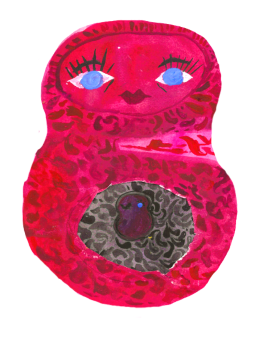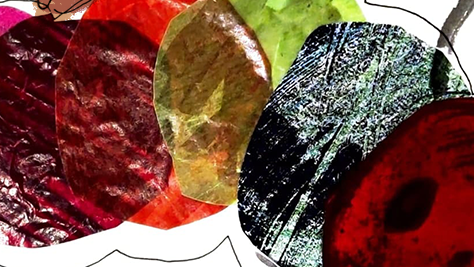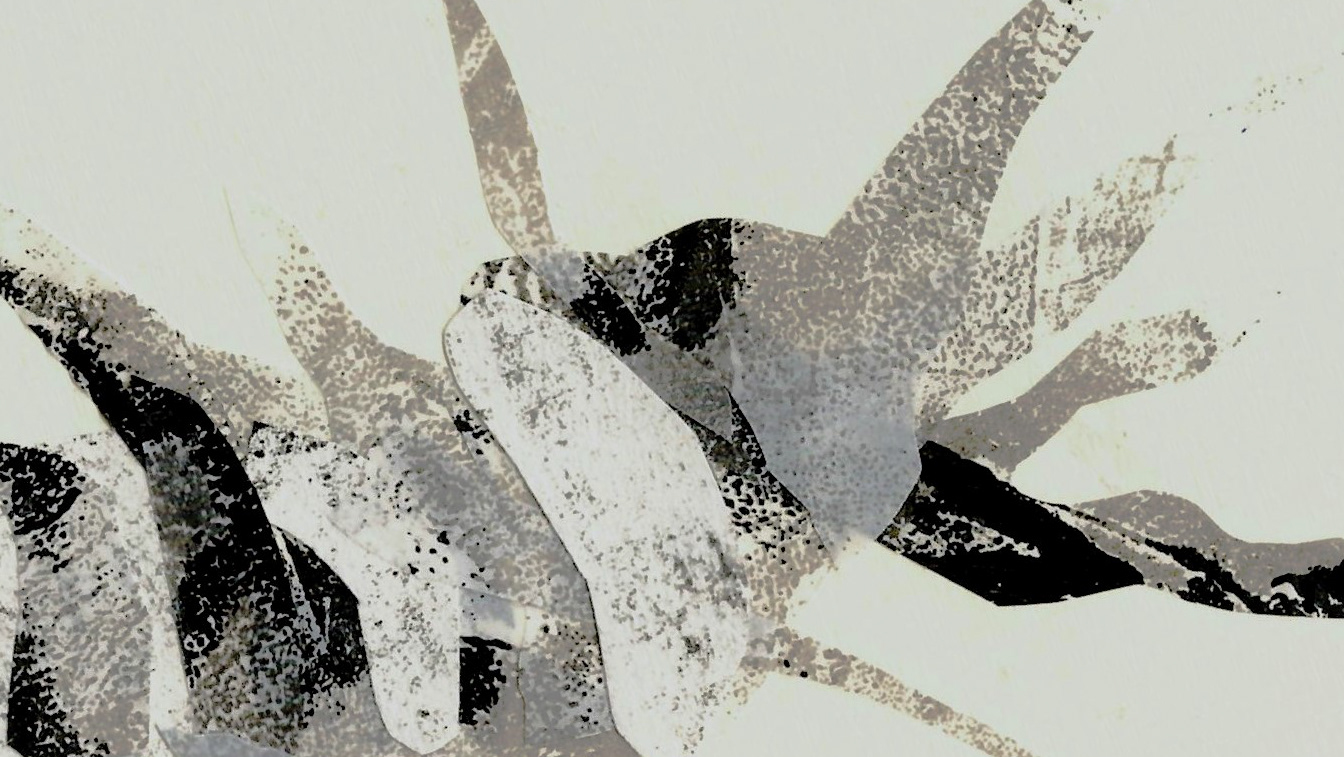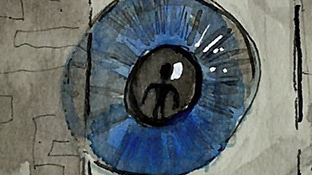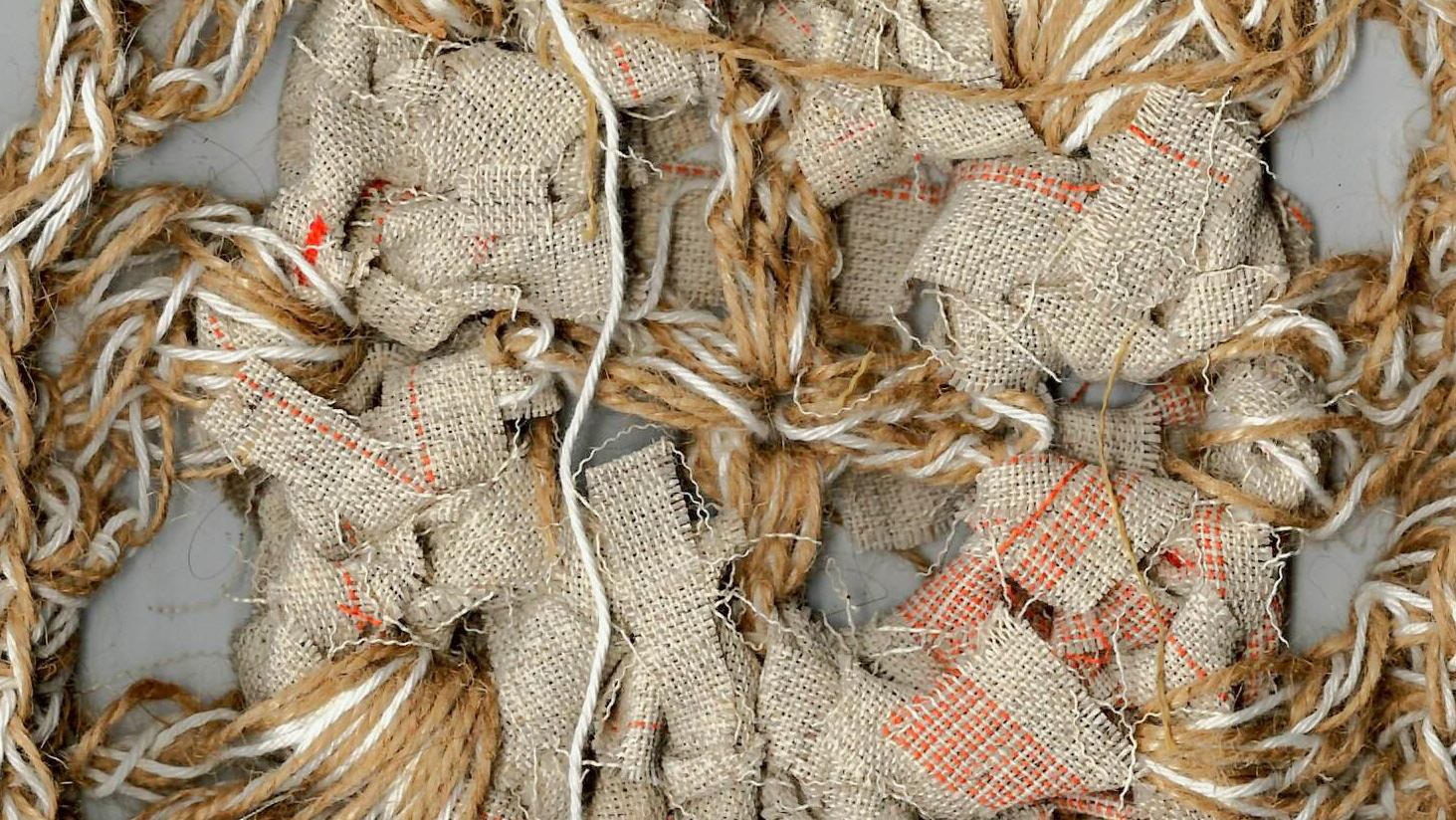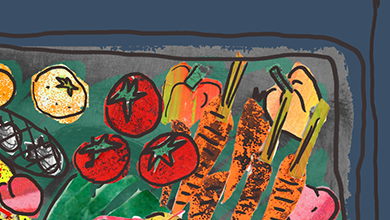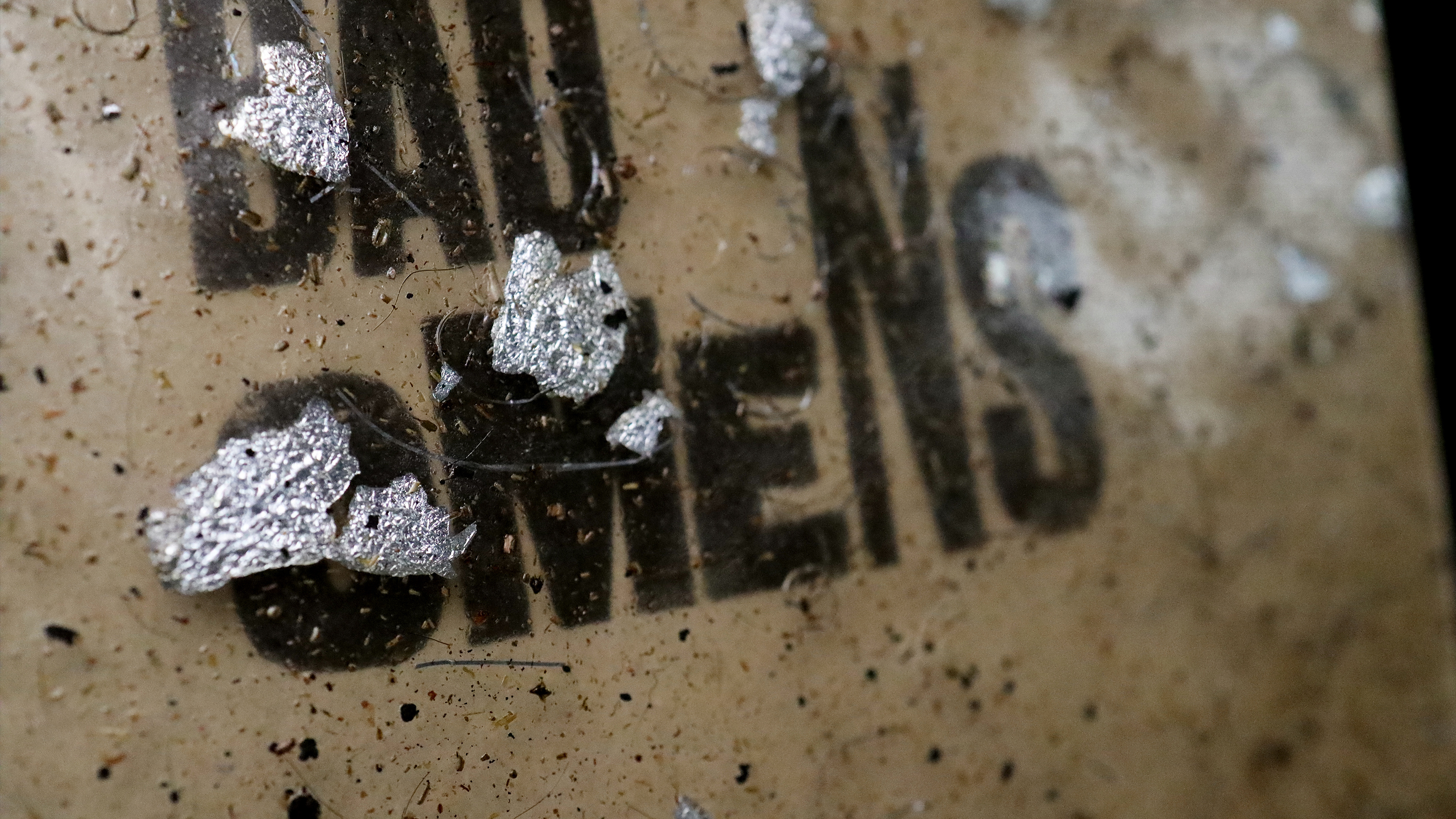Going into this brief I was pretty excited since much of my work is based on the relationship between people and places. I am also feeling quite a lot of pressure to make something really awesome, since I think I will most likely talk about this project in my dissertation, since the concept of 'place' seems like the most related to the kind of work I enjoy making.
I started this project like I most often do, by looking through the briefs.
Something that I have previously wanted to explore further is imaginary places. I admire artists who are able to develop complex worlds that seem believable while also being extremely imaginative, making the audience engage deeply with their work. One example is Alexis Deacon (one of my favourite illustrators) , who create a sense of suspense and anticipation as he slowly reveals the nonsensical and exciting aspects of the worlds he creates.

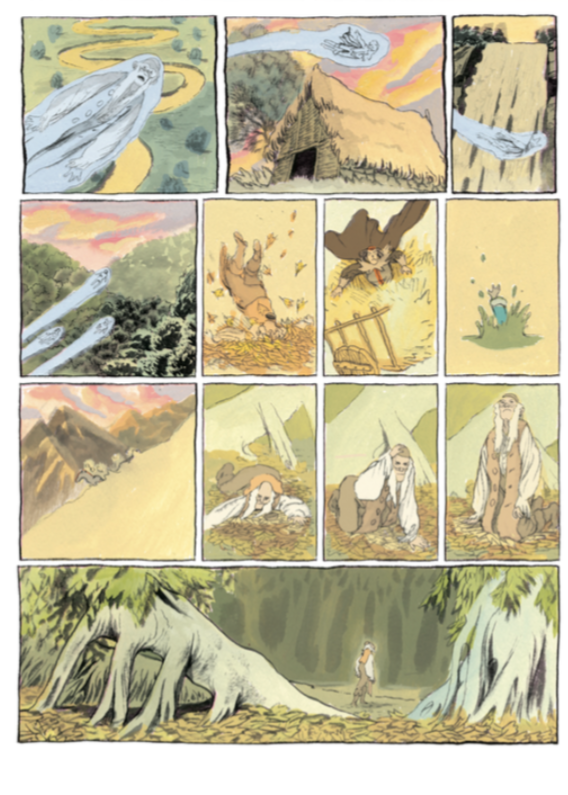
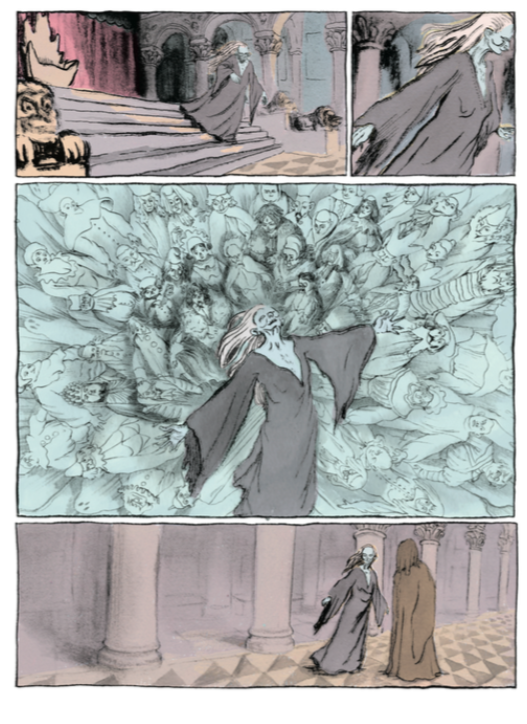
One of the subjects that I wanted to try approaching in this project is finding adventure in unexpected places which might've, at first, seemed boring. Although I grew up in a big city, I live really close to the edge. Right now, it is being converted into some kind of suburb area with a couple glass office buildings sprinkled in between, but back when I was growing up, there was nothing there. My most entertaining evening activity was to look at my neighbour who was a goatherd (who now had to leave due to the constant construction taking up what used to be plain field spaces; along with all the other people who used to take care of animals).
I don't really know whereto start with this brief, so I decided to make this tiny pink book in which I drew some of the random places that I would walk around in after school.


Although the book is pretty much only relevant to me as it is very personal, it got me thinking more about looking at creative formats that enhance the feelings that being in certain places evokes. To me, really watery, bleeding watercolour evokes childhood nostalgia, maybe due to its softness, or because it is the medium that would be provided to us in preschool.
Briefly, during last year, and more so during the beginning of this year, I started reading about psychogeography, specifically about Guy Debord and the situationist internationale. I was particularly interested in the concept of 'derive', which, esentially implies aimless exploration, something that I would like to explore during this project. Childhood exploration (to me) means wandering without a destination in mind, only searching for adventure, and making a playground of the whole world, which is not only fun, but also facilitates the opportunity to learn about the world first-hand.








Since I am already planning to make a book for the 'Identity' project, I want to do spmething different for this one. So, although I have my initial pink book experiment, I have started to think more about doing something 3D, as that is something that I am interested in trying this year.
Magdalena Bors
I love the way she uses found objects to create intricate sculptures. As someone who is really bad at throwing things away, I am wondering if I could also use the stuff that clutters in my room to create something . I especially enjoy the way she sticks to one material I tend to throw every medium I own at my work, so I feel like purposefully trying to use only one material for a 3D outcome would be an interesting way to enhance the meaning of that material.








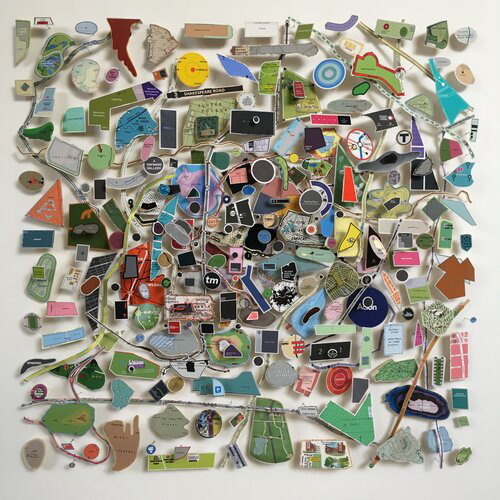


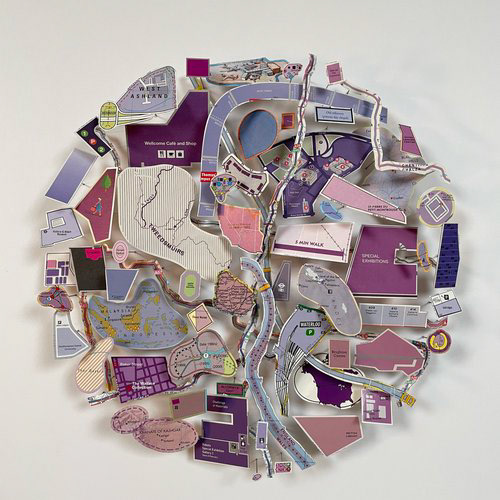

Chris Kenny
On that same note, I also collect every piece of paper that comes into contact with my hands on the street. Every couple of months I have to organise through my collection of leaflets and choose which ones I really want to keep so that I do not bury my whole self in paper.
Chris Kenny creates maps with his cut-outs, which I think is incredibly clever; I would love to try using all the paper I have gathered to create something completely new.
Lauren Clay
Her exhibition spaces look seem really immersive, I feel like the relief elements are effective in bringing the viewers in her soft pillowy world.
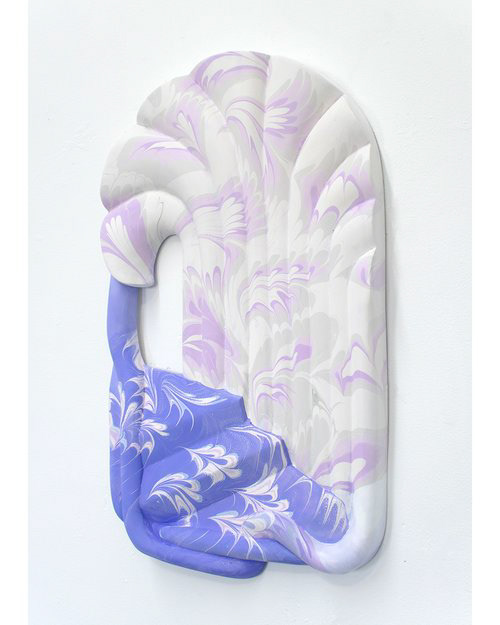



Although I had some plans of things to try in the exploration of this brief, I got really busy, and, before I knew it , I had to head home, completely unprepared to tackle this brief, and in a mild state of panic.
During the winter break, as I was heading home, I took the opportunity of my fairly long journey to do some life drawings. (mostly since I had no idea where to take this whole brief, so doing reportage was a way to get myself to just do something, anything, with the hope to progress the brief)
Doing this ended up enhancing my journey, as not only did it give me an activity to focus on instead of the dread and misery of being stuck in a train then coach then airport then plane then airport again, and so on, but it even made me feel excited. Normally I would feel more and more exhausted with each change of space, but now I looked forward to changing the setting of my observational drawings. Even sitting in the airport for 4 hours didn't seem so boring while I was observing the people around me while also visually documenting them. I also found that I didn't care that much if they saw me do it, perhaps due to all the exposure therapy we had in 1st year, when we were constantly forced to draw in public.
When I am home, I am completely immersed in the home atmosphere, and I cannot convince myself to do any work, no matter how dire the situation might seem. I feel like every crumb of self-discipline that I might have just evaporates when I go home.
Since I was enjoying the break, I let myself draw when I felt like it. This meant that most of my work ended up being created whilst I was waiting for something, the bulk of it being done while in the airport or while I was waiting for buses to go around the city.
Doing this also made me think more about what I enjoy creating in my free time. I have no idea what I want to do next (regarding a possible art career), as I feel like I just like doing everything, but also nothing in particular(just like how I felt like I don't like being anywhere in particular). However, thinking about how much I was enjoying doing reportage made me also think back on what I willingly and completely unpromptedly pick up a pencil to do. And that is life drawing, which has become ingrained in my consciousness, without me realising; I always want to be doing it.
Something that I could consider doing in the future is reportage work. However, although illustration is often a job with a lot of uncertainty, I feel like reportage is particularly niche and hard to get a job in.
Airports
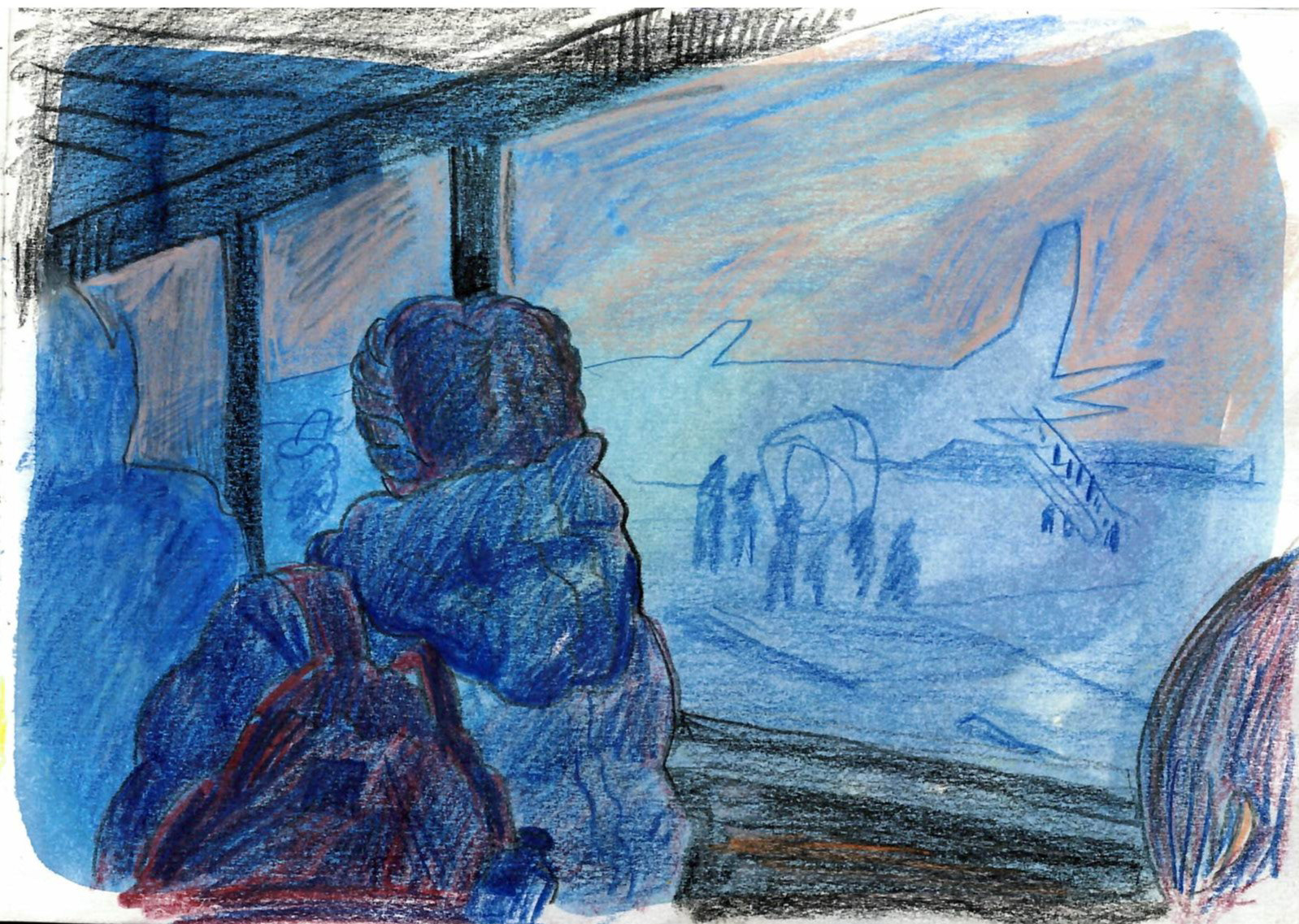


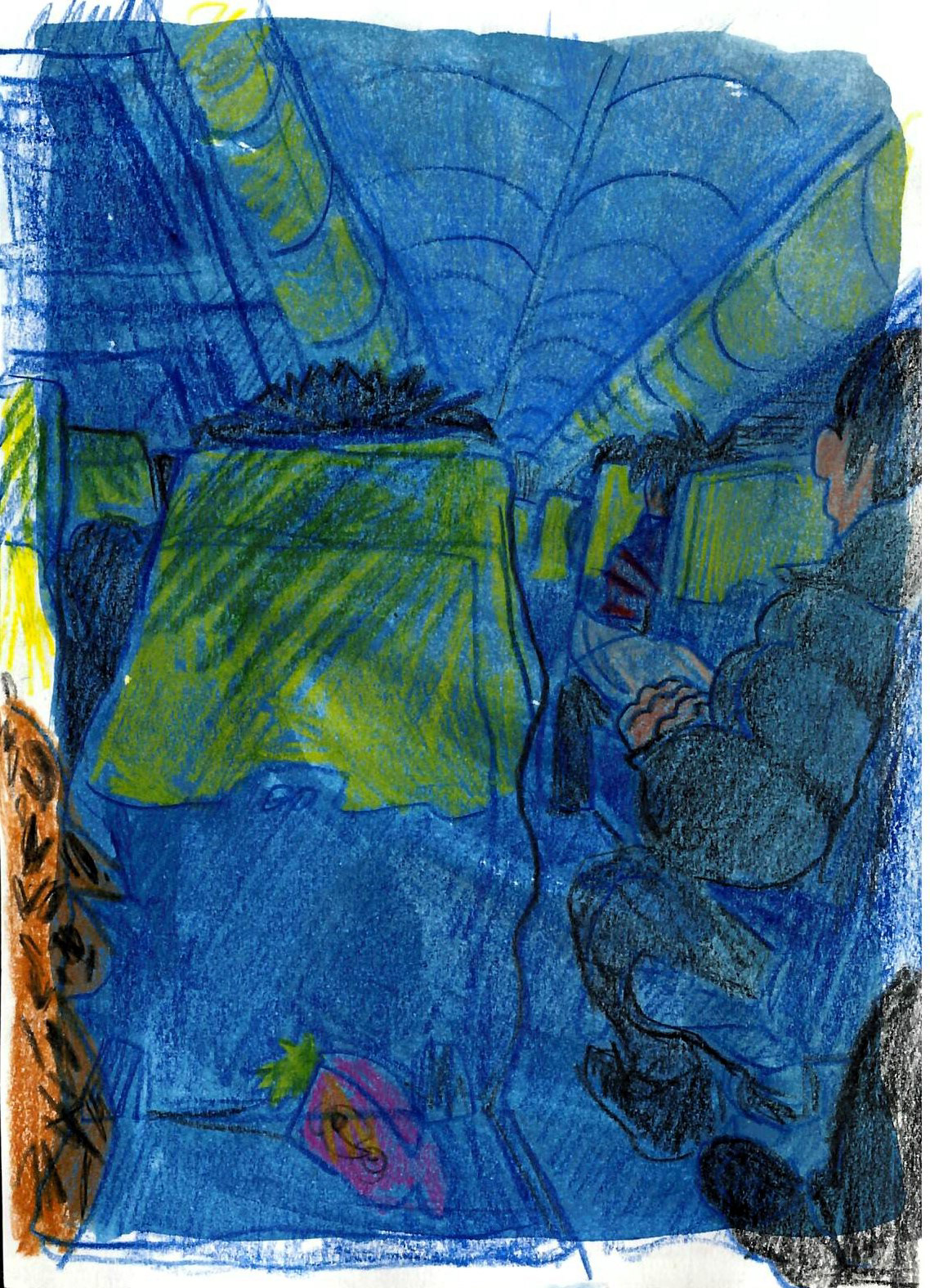


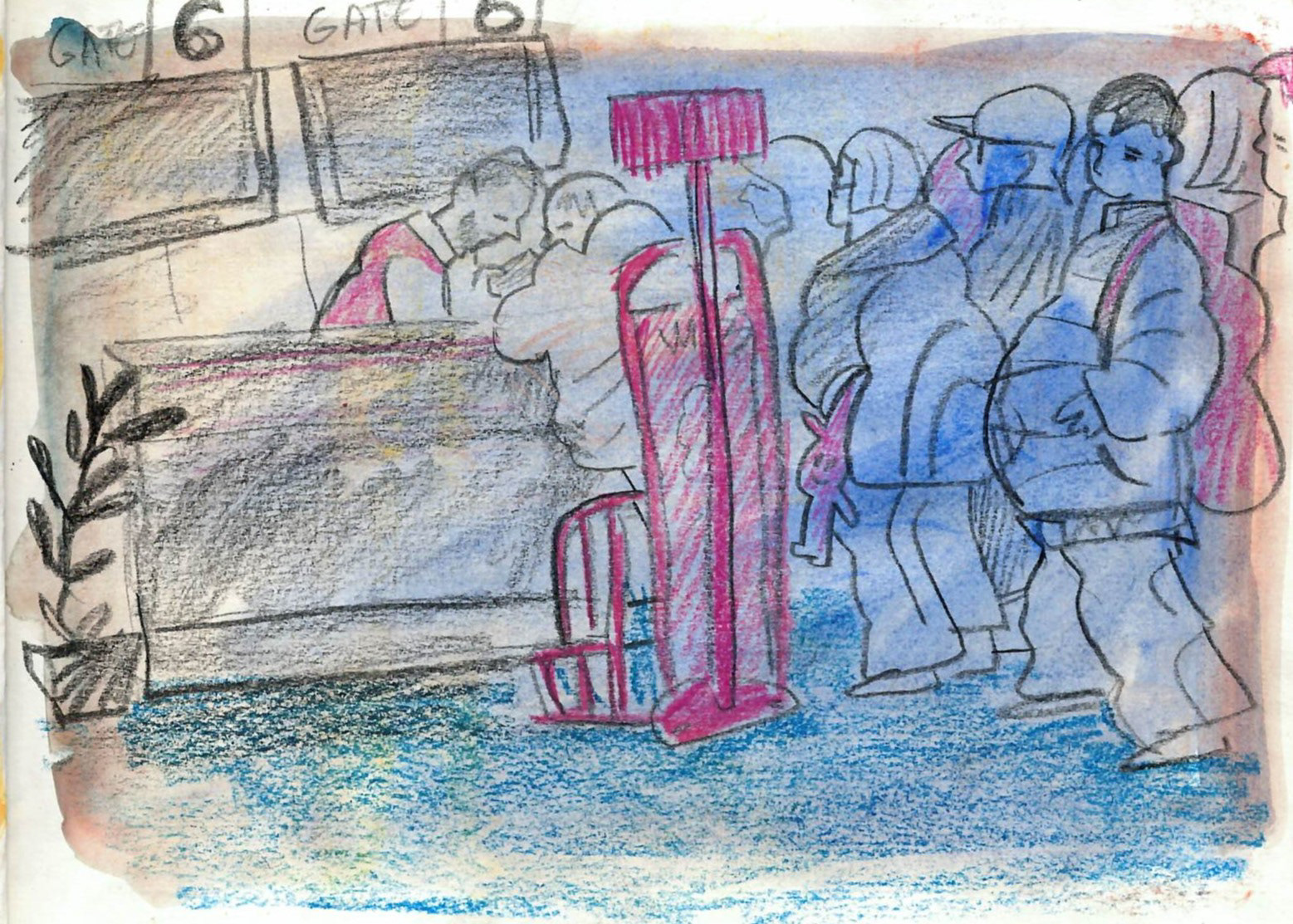



Even though winter break lasted for weeks, a disproportionate amount of the work I have done is in the airport. The airport/airplane is such an isolated place from the world, and I feel like everyone acts completely differently in an airport to any other place in society. I think people tend to care way less about other peoples' opinion or presence in this environment, rather than anywhere else. Due to that, I felt particularly at ease drawing random people who sat around me. There is also quite a noticeable difference in the quality of drawings from the airport on my way back home(at the top), and the ones leaving from home(bottom rows).
This difference makes me feel like I should evaluate the way I portray emotions in my drawings. In the top ones, on my way back home, I was extremely bored , since I was stuck in the airport for way too many hours due to getting the cheapest train and plane ticket combo, which are quite far apart. These drawings are quite colourful and the lines are quite well considered, as I was in a space where I could comfortably pull out my art supplies and scribble. I also was really bored, so creating the drawings became my source of entertainment.
On the other side, the drawings I made while leaving my home seem much less considered. I was also much less bored, and mostly just found myself in a state of mild distress and sadness, so I started drawing people around me with the hope of distracting myself. It didn't really work, and I was still unhappy. Looking back at them after a bit, the lines on the drawings seem to have a desperate twinge to them, sort of like they are being violently thrown on paper as a las desperate distraction.
While the goal of both series of drawings was to be a distraction, they have very different qualities. I never really draw when I am in an authentic bad mood (and if I do, I often try to supress it and focus on what I am doing), so it's interesting to see how that actually affects my work. In my 'Identity' project, when I tried to convey anxiety, I feel like I did it through generic means (scratchy, abrupt lines and other such marks that tend to be universally recognised as distressing), so it is interesting to see, now, how my mood actually peeks through the drawings (even though I do not intend to) while I am actually feeling it, as opposed to when I purposefully try to convey an emotion. This discrepancy in how emotions make themselves known through drawings and how they tend to be represented would be good to keep in mind, however, I am not sure how I would replicate this since I don't tend to draw when I am in a less-than-fortunate state of mind, as doing so makes me feel even more stuck in my head.
In the city

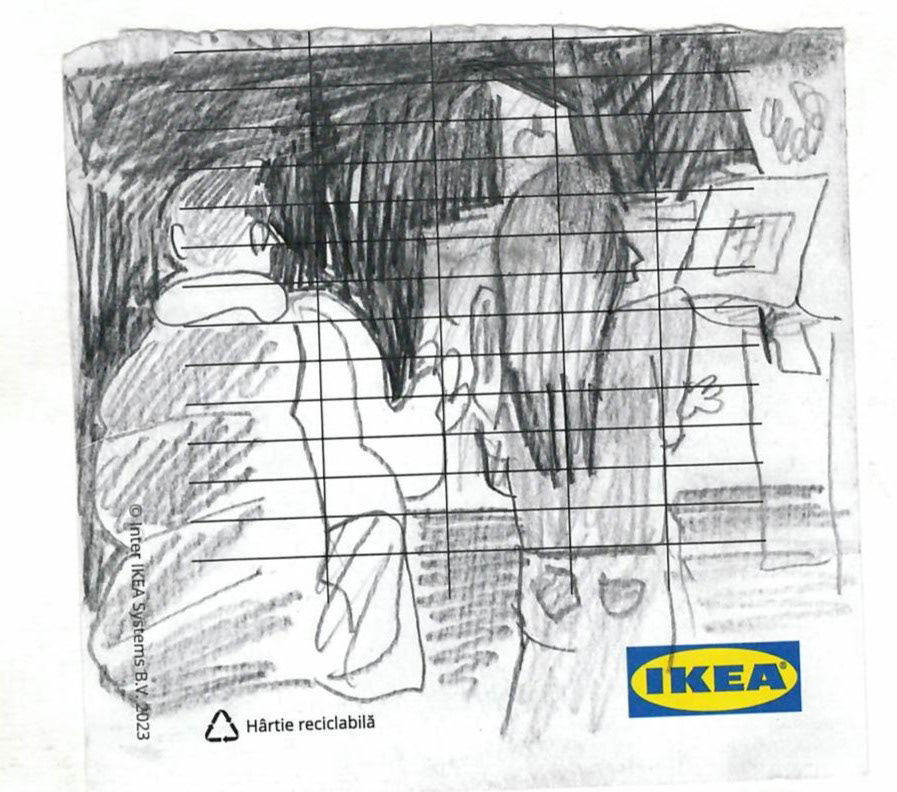

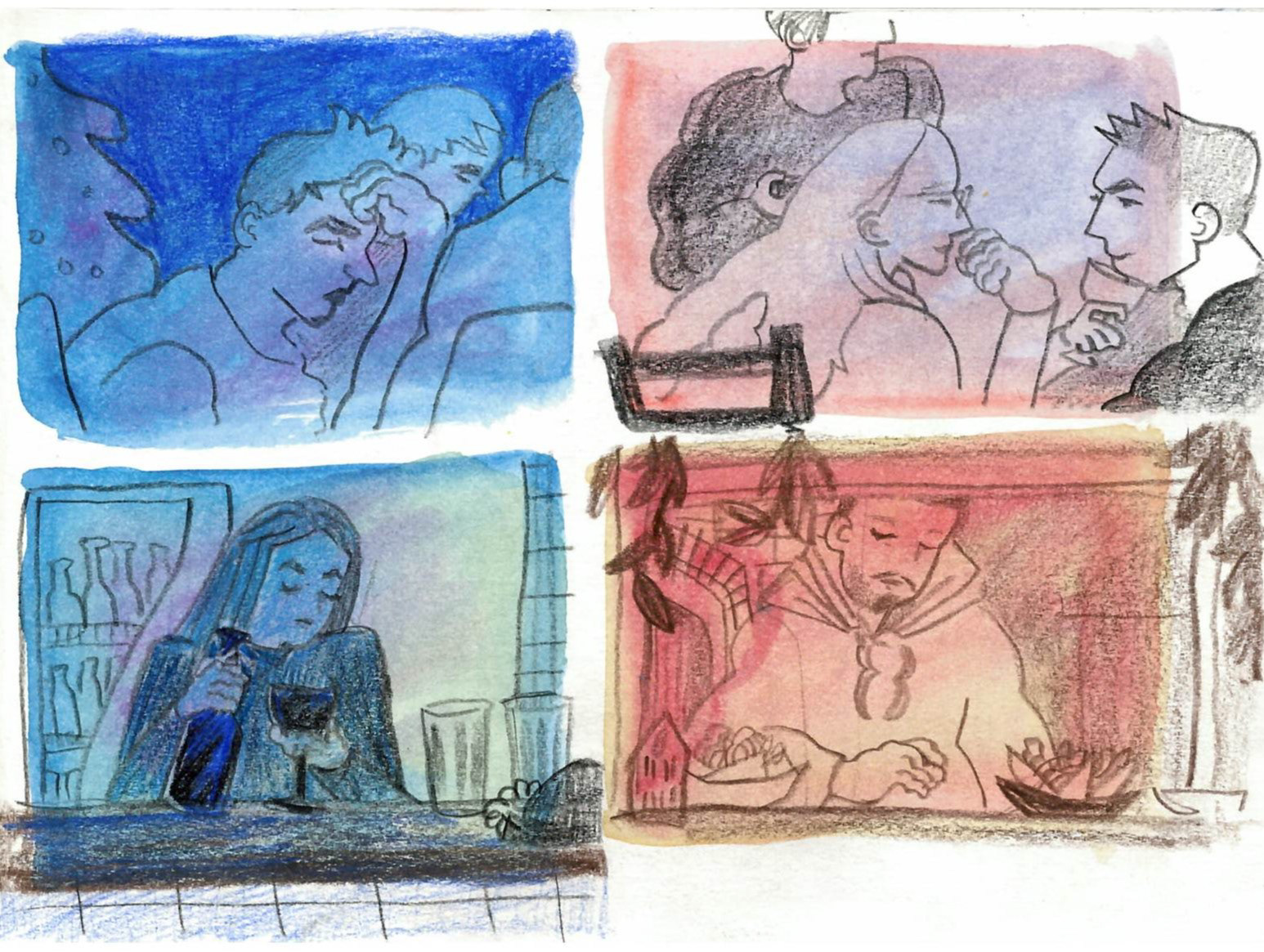
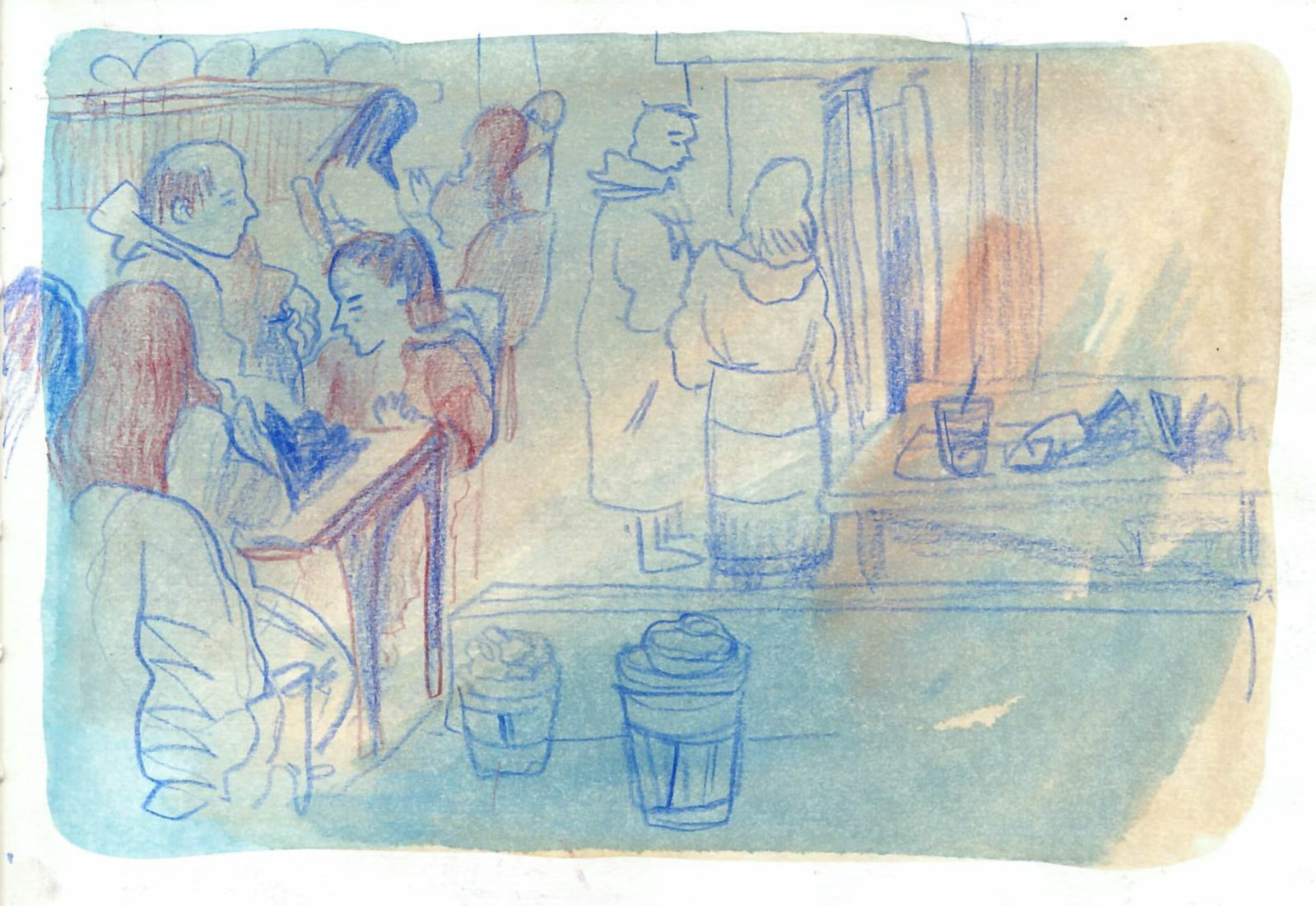
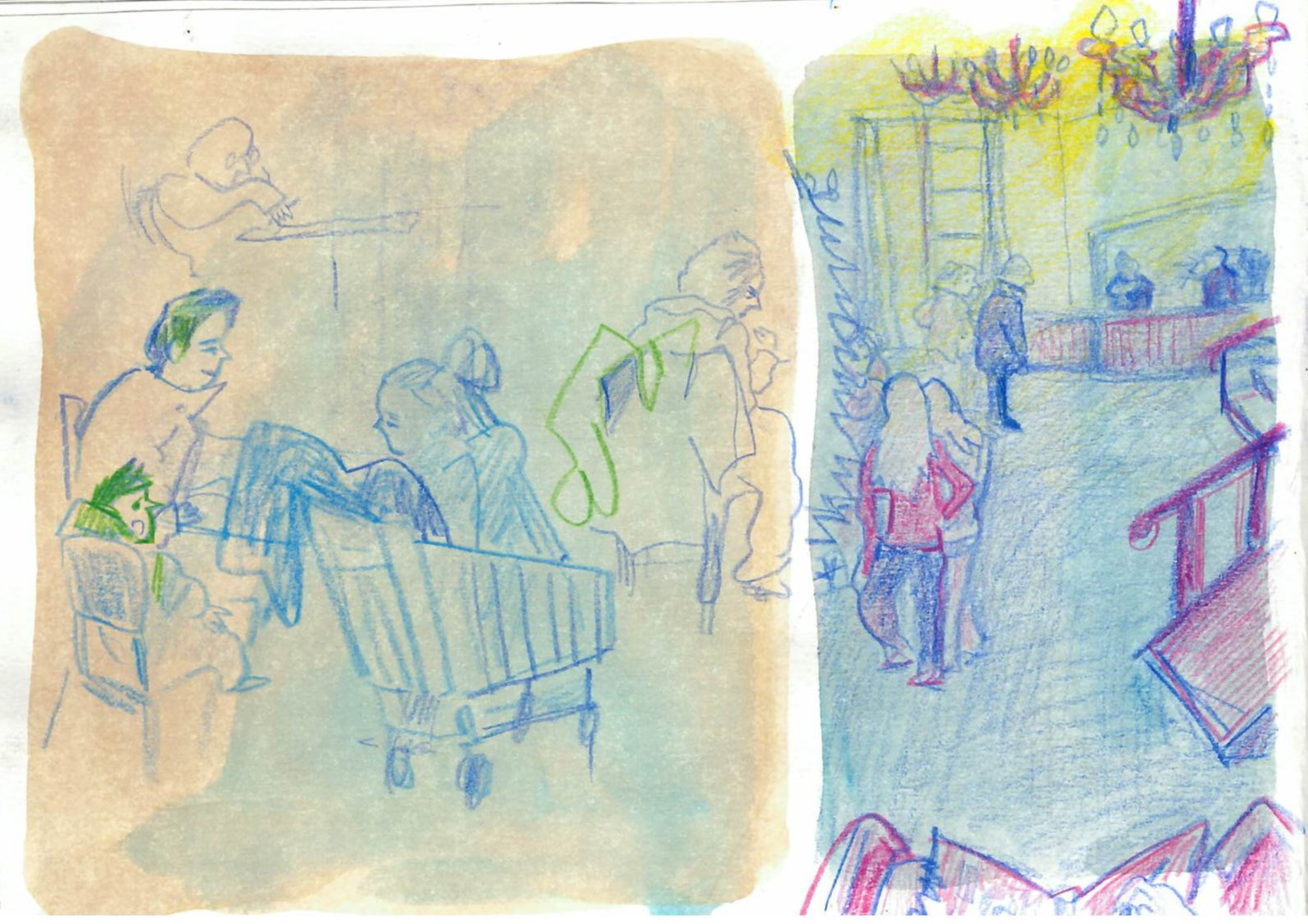


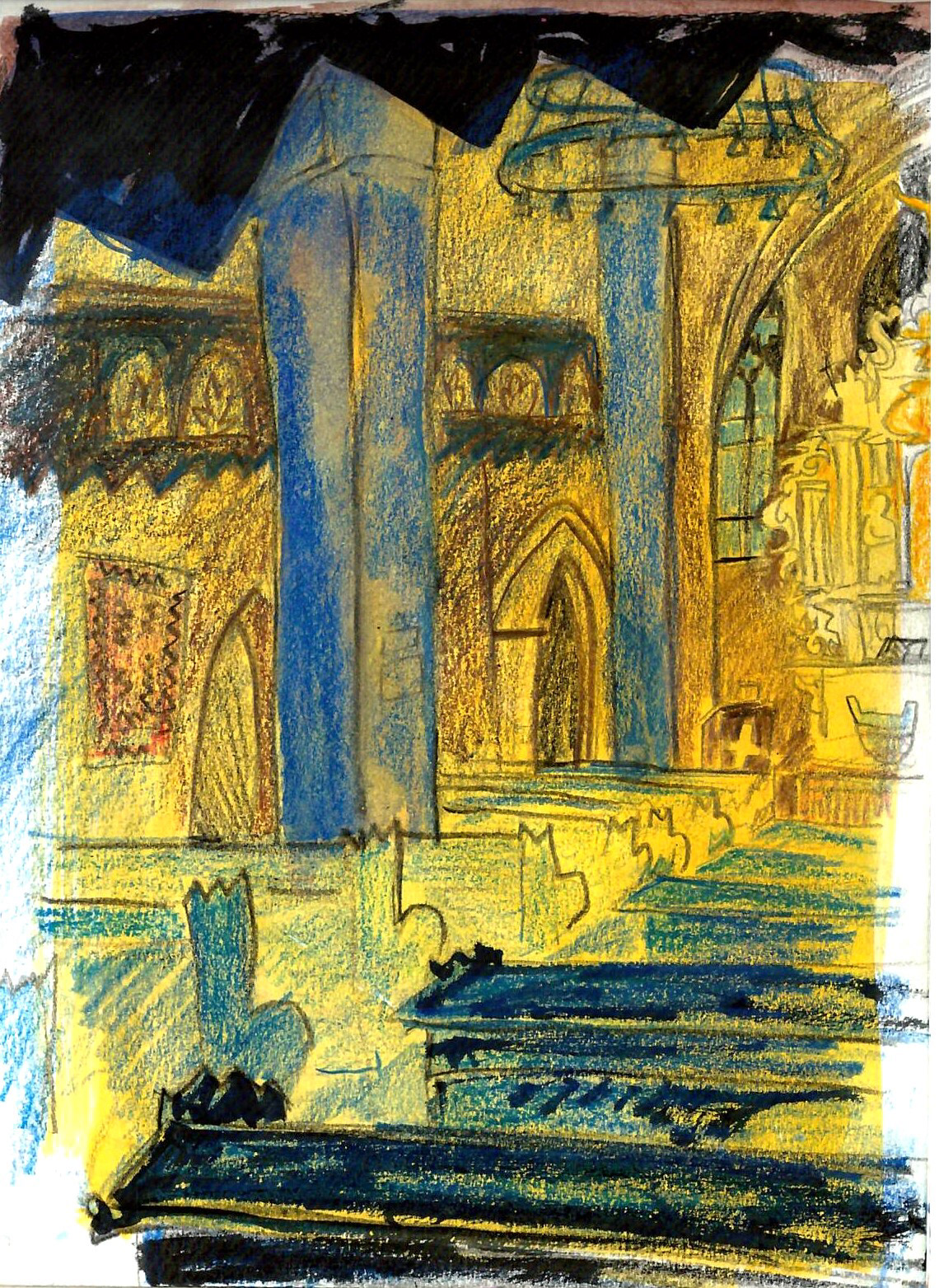




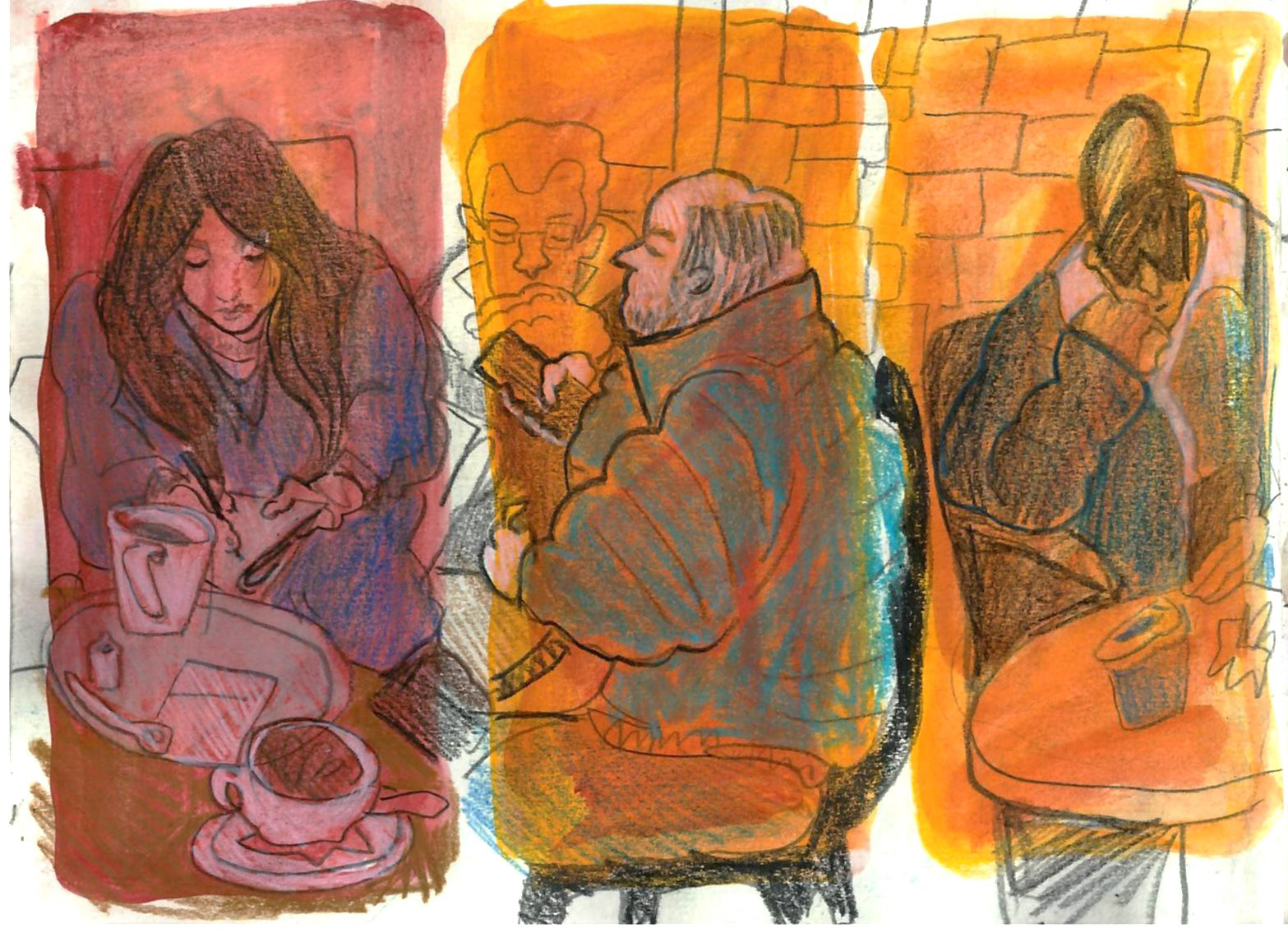
joyed drawing in the city. I feel like this is where I can find the most stories, which makes sense since thousands of people converge. A particularly note-worthy story I discovered while looking for things to draw was the one above, on the bus, where a bunny and a bag of sweets lie forgotten - I wonder why they are there? was it on purpose? an is the person sad for leaving them behind? As I was thinking about exploring more imaginary places, I feel like a good starting point could be looking at these mundane objects that have the potential to have had a crazy story in getting there.
Restaurants and cafes are always fun places to draw in, as I get to see people interacting with other people they know, so they show more aspect of themselves than if they were surrounded by strangers. However, it feels more intrusive to draw people here.
Bus stops
Another type of place I drew a lot in were bus stops. Looking at this sketchbook, I feel like I have created a visual map of my journey, but instead of the destinations, it is the means of getting there that are portrayed.
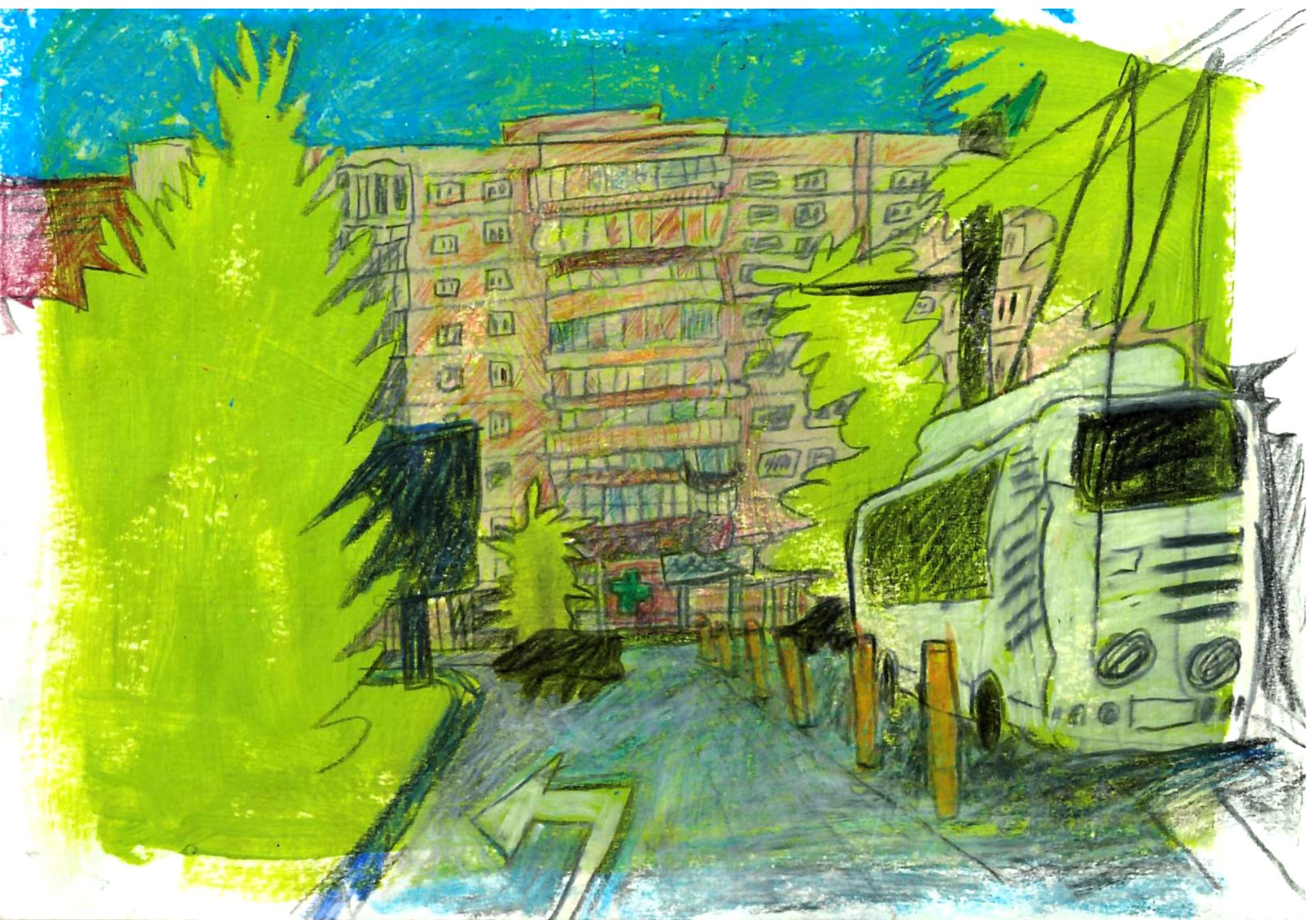
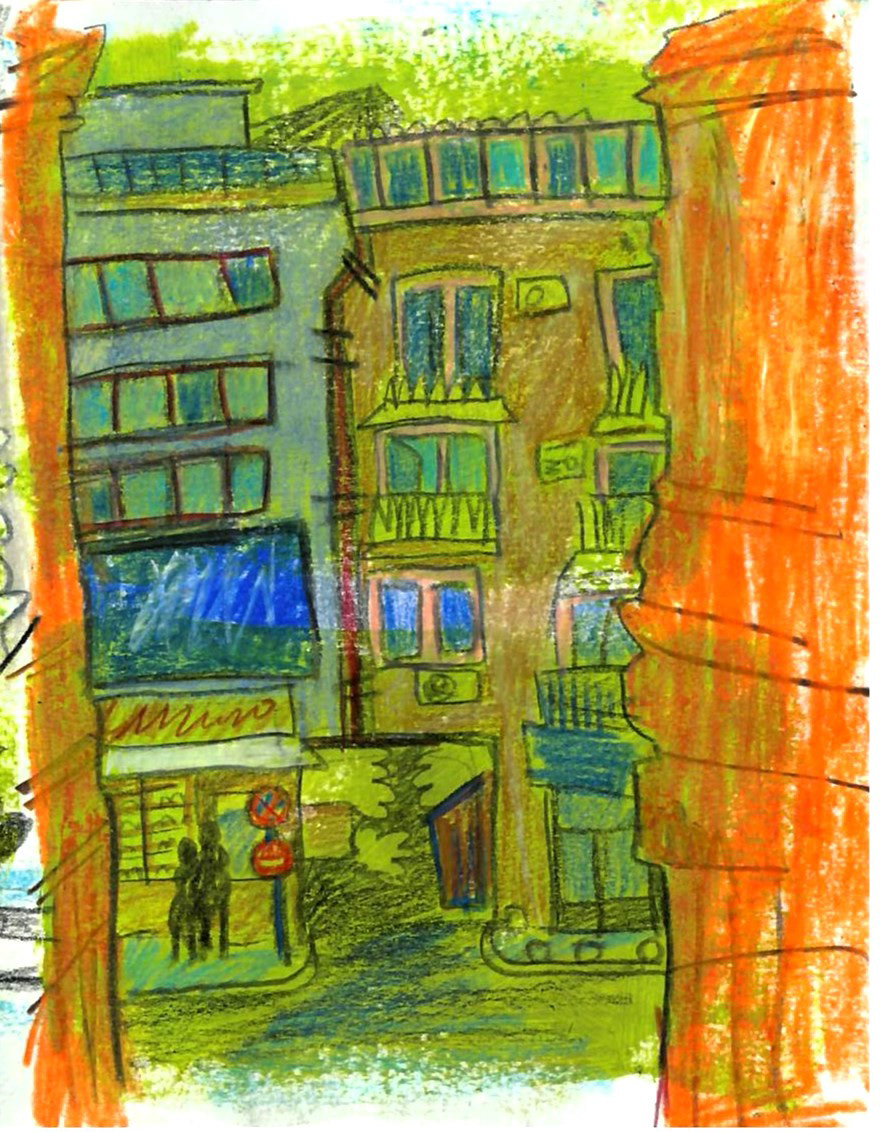
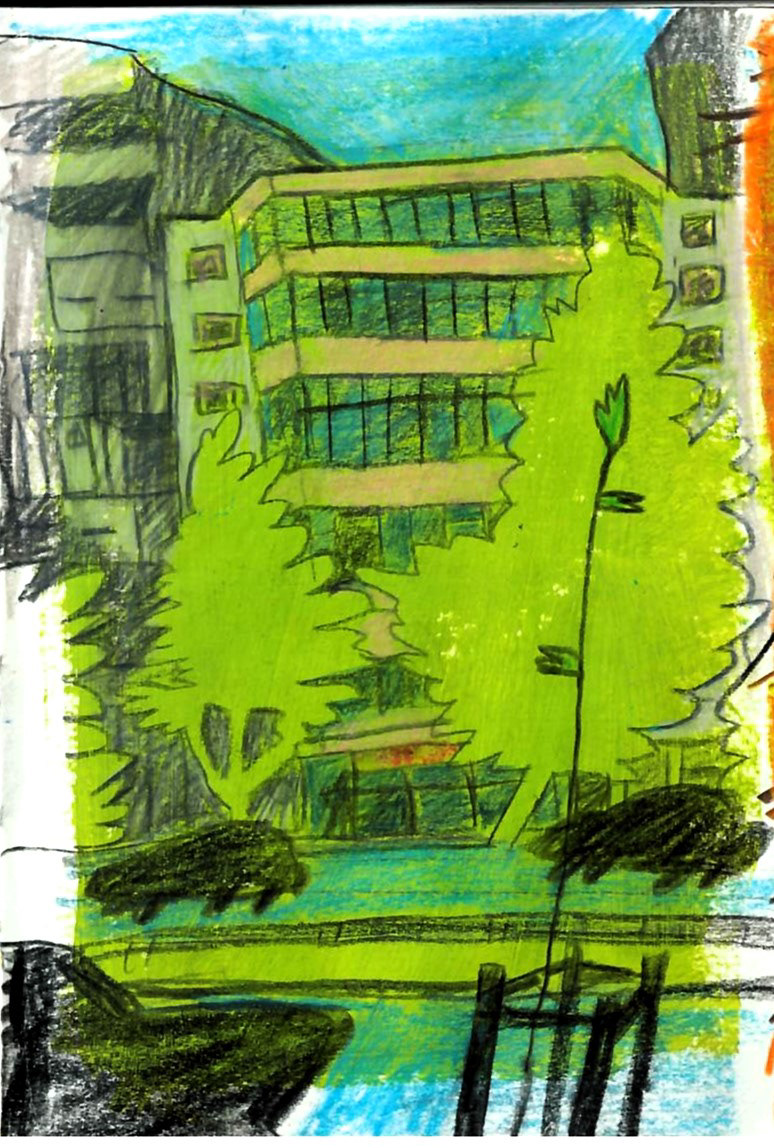

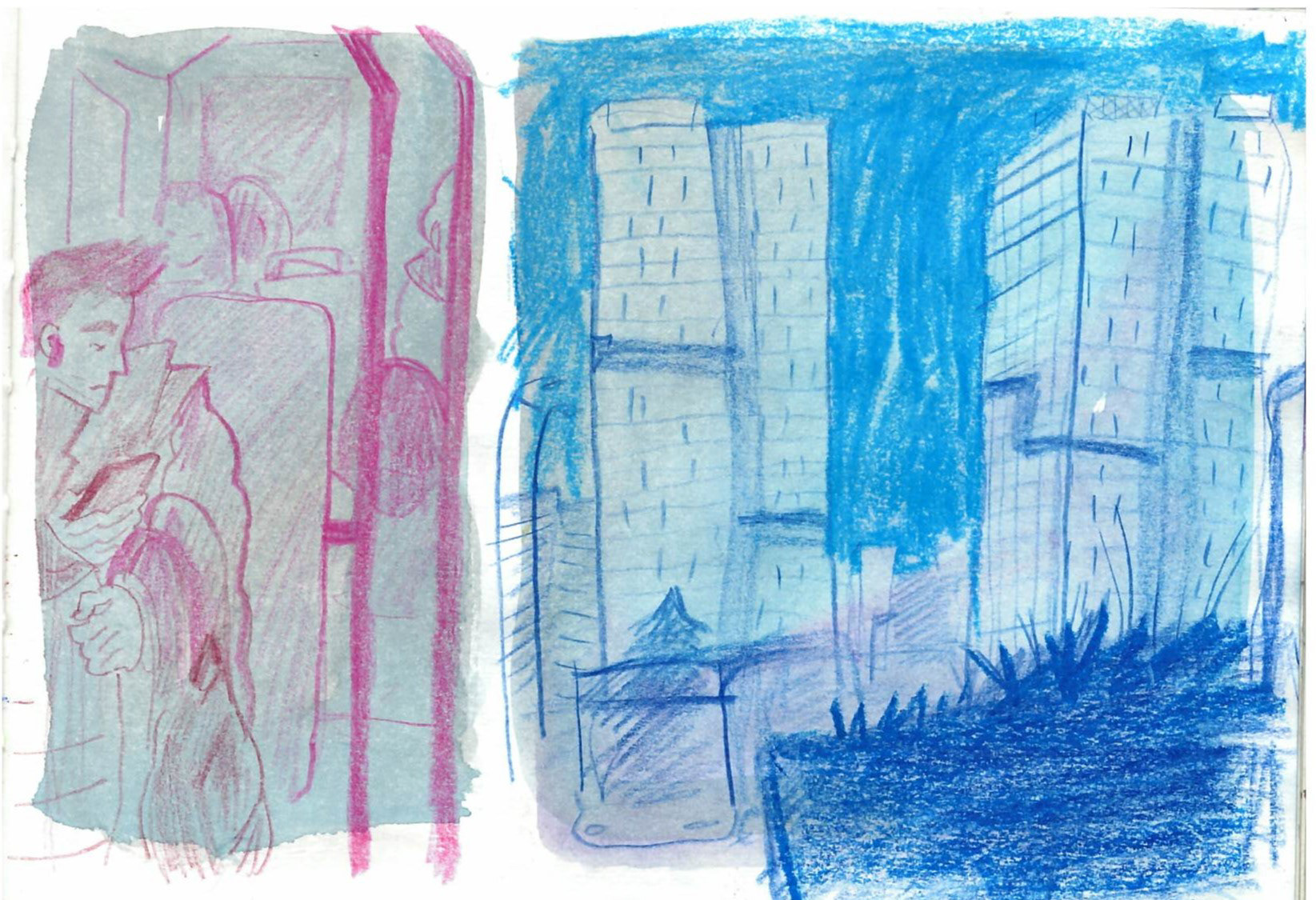
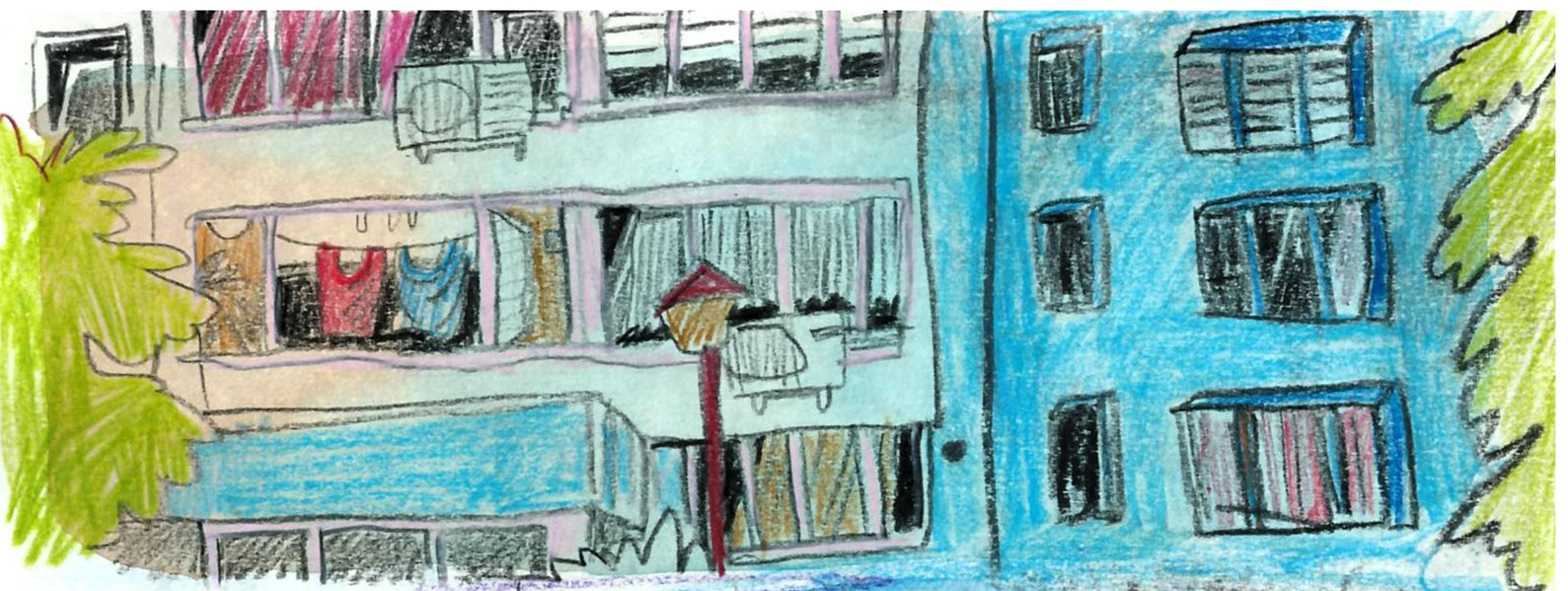
Something that I also noticed was the way drawing an image made me more involved, as I focused on the moment I was experiencing way more than if I had done nothing or even if I had taken a picture.
I find that I never remember the in-between spaces of my life. Although I am a really impatient person and I hate sitting for long periods of time, I often sign myself up for things that involve me waiting for really long periods of time( such as really long coach rides) because I always forget the horrible emotional state they put me in. And ,predictably, even if I spend more time on the road than at the destination, I always remember the destination better.
Drawing my surroundings made me feel more connected to these waiting moments that I would usually find very unimportant. Looking back, I remember where I was in each of these drawings and the places I was going to and from, as well as the thoughts I was having in those moments, whereas I normally just forget everything as soon as it happens.
I also drew my friend while I was really bored while waiting for her to get up
Fog and Frost
While I was at home, I went on a trip with my family to the Transylvania region, which was appropriately ominous due to the fog. I thought the foggy landscape was really beautiful, even though it was a bit scary.

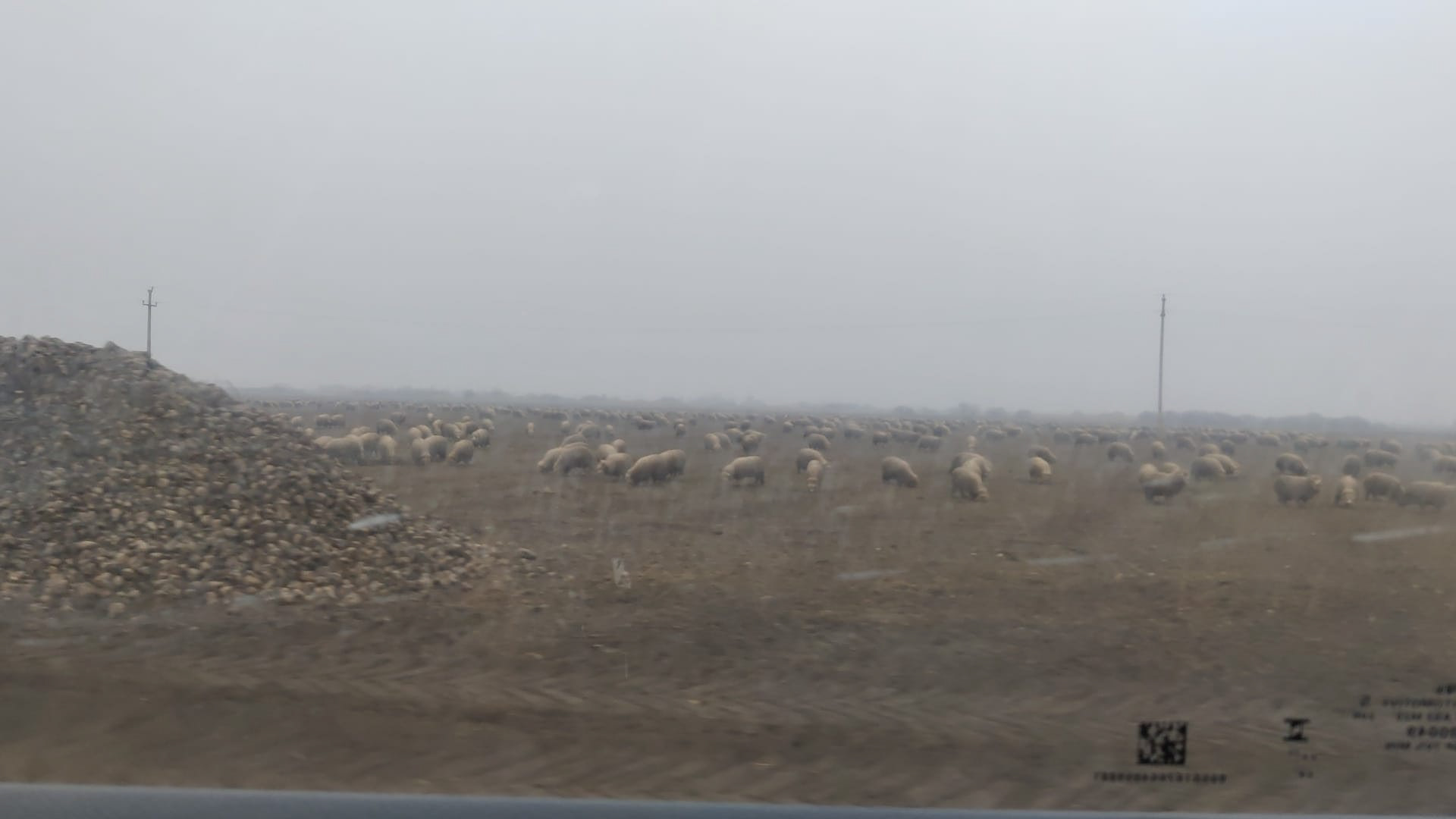
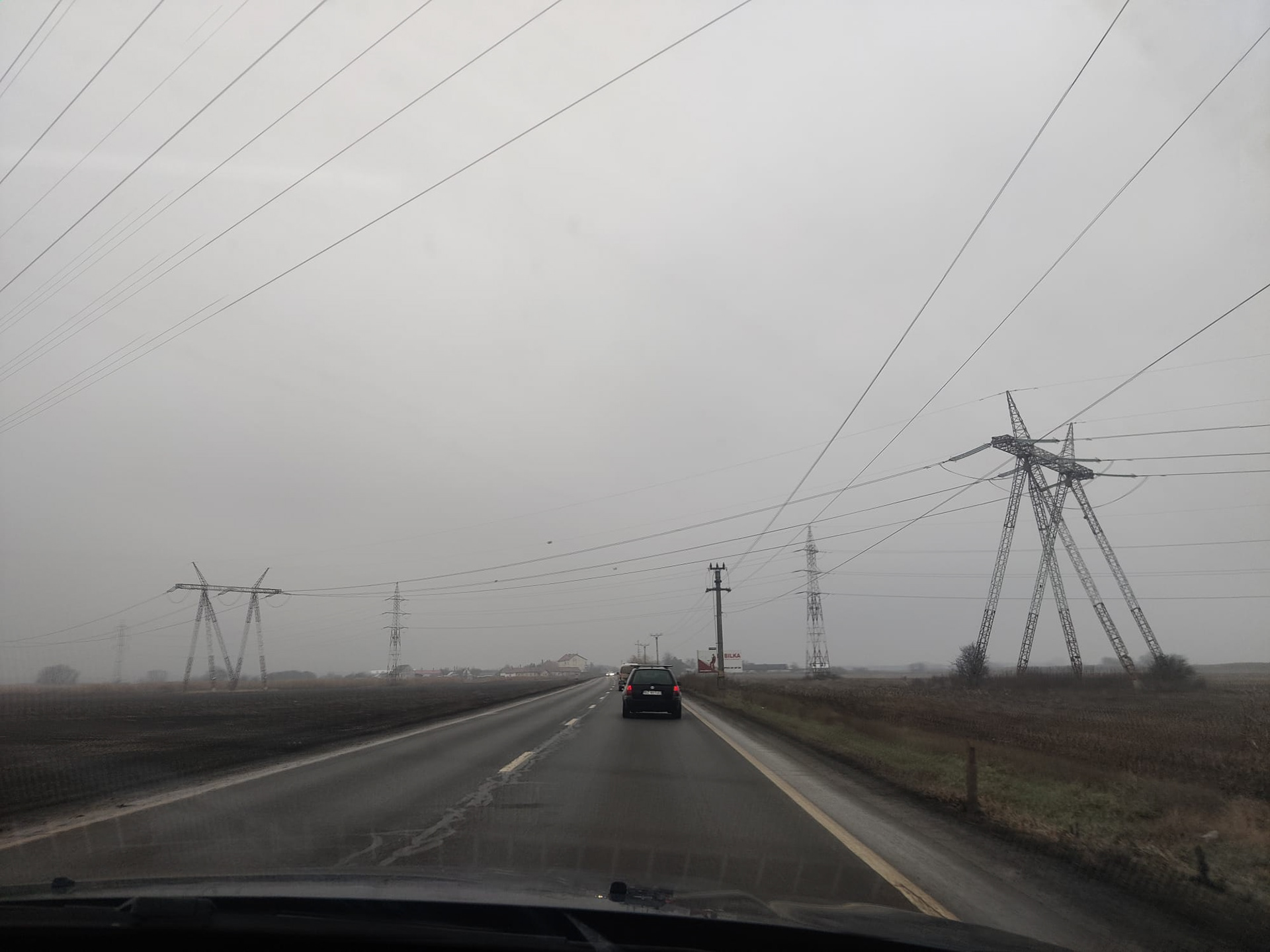


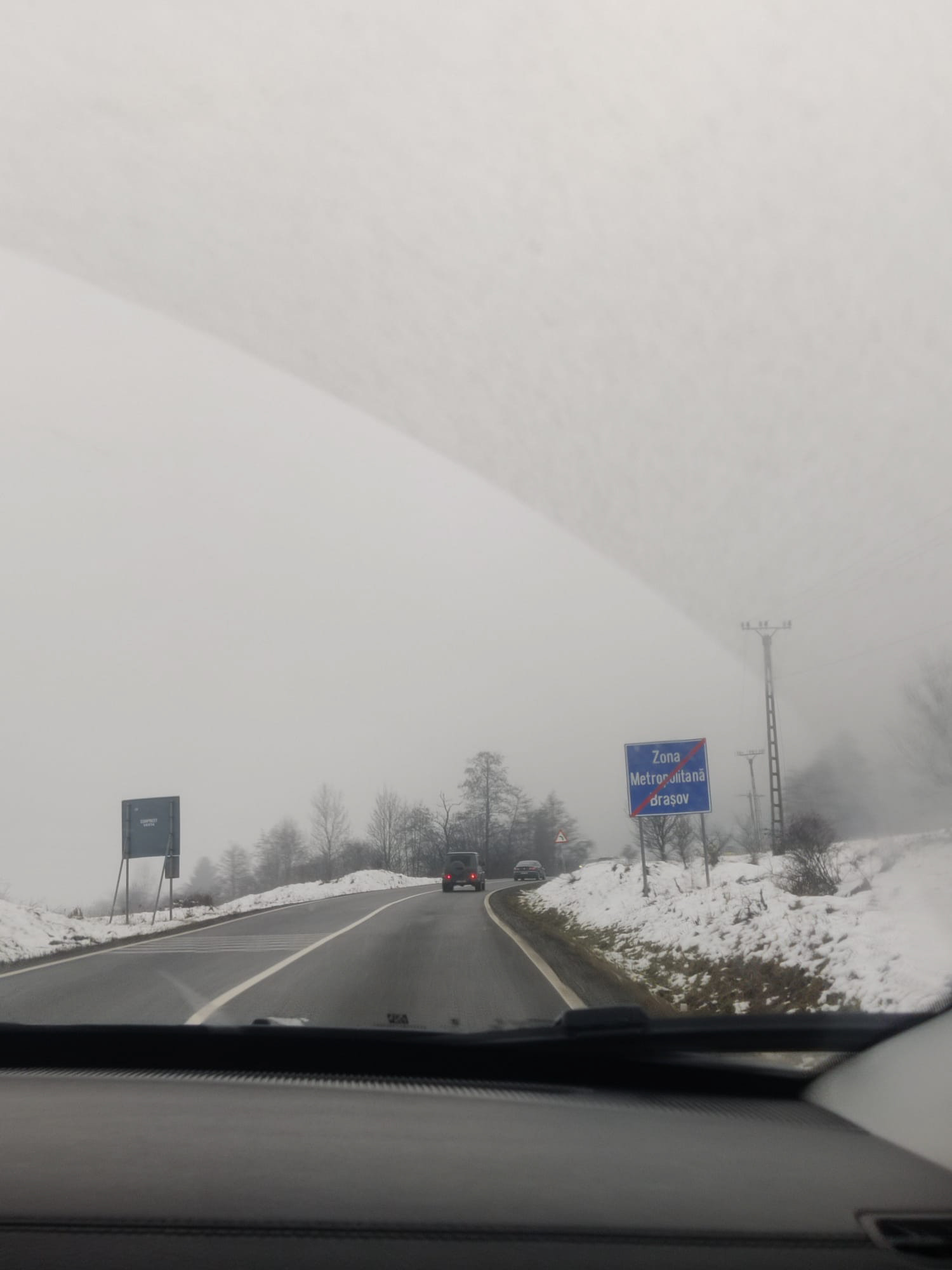

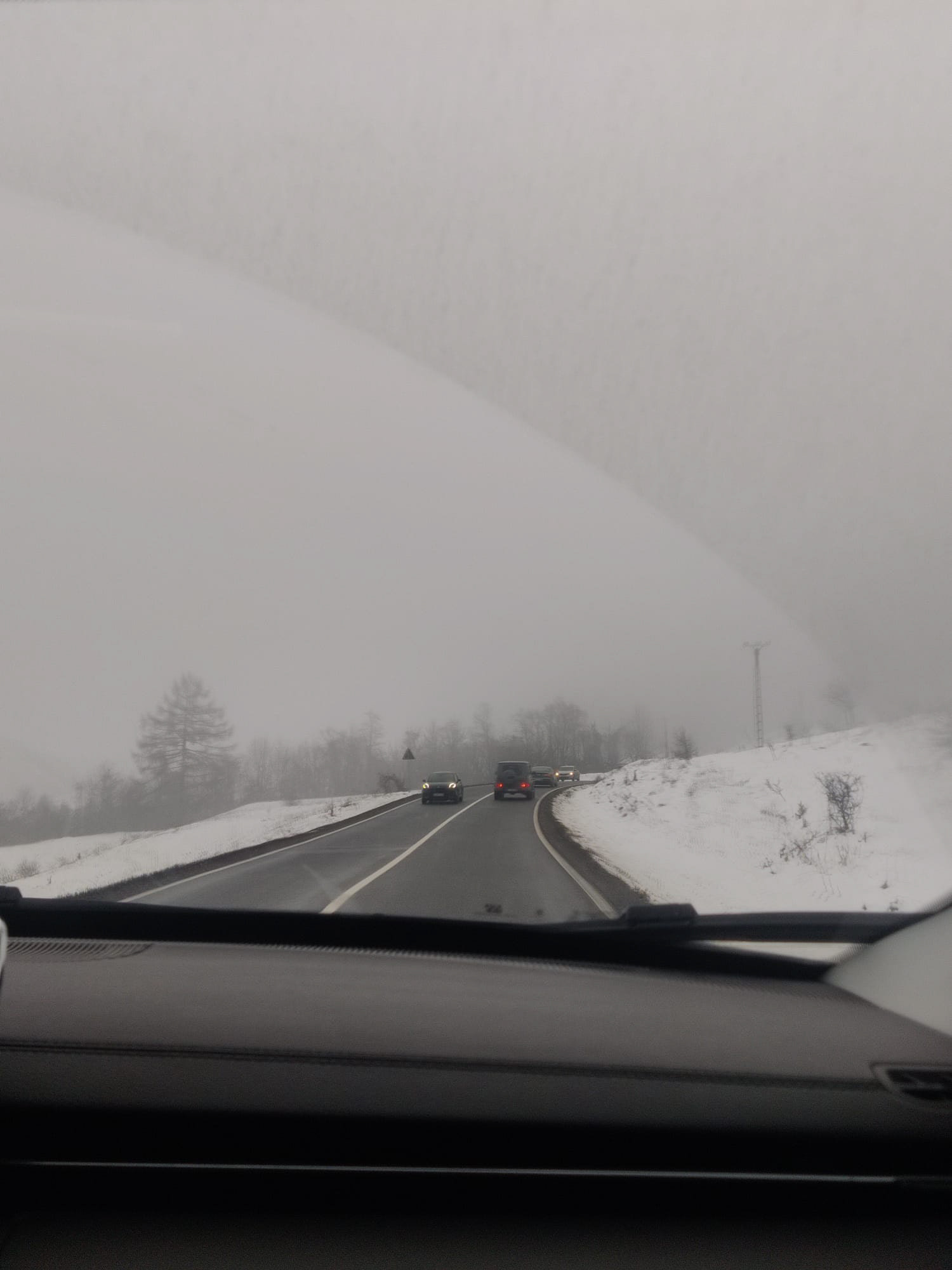
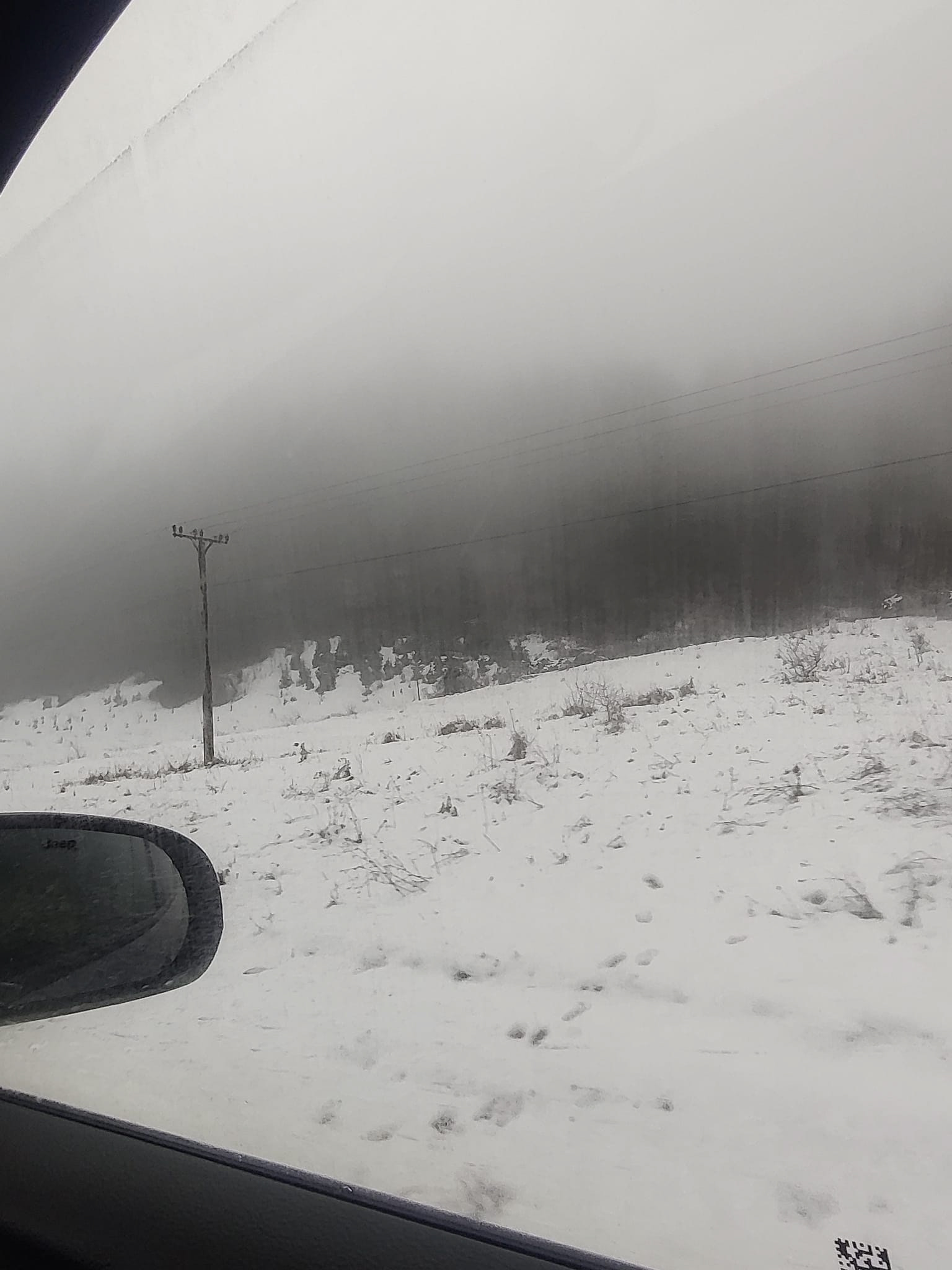

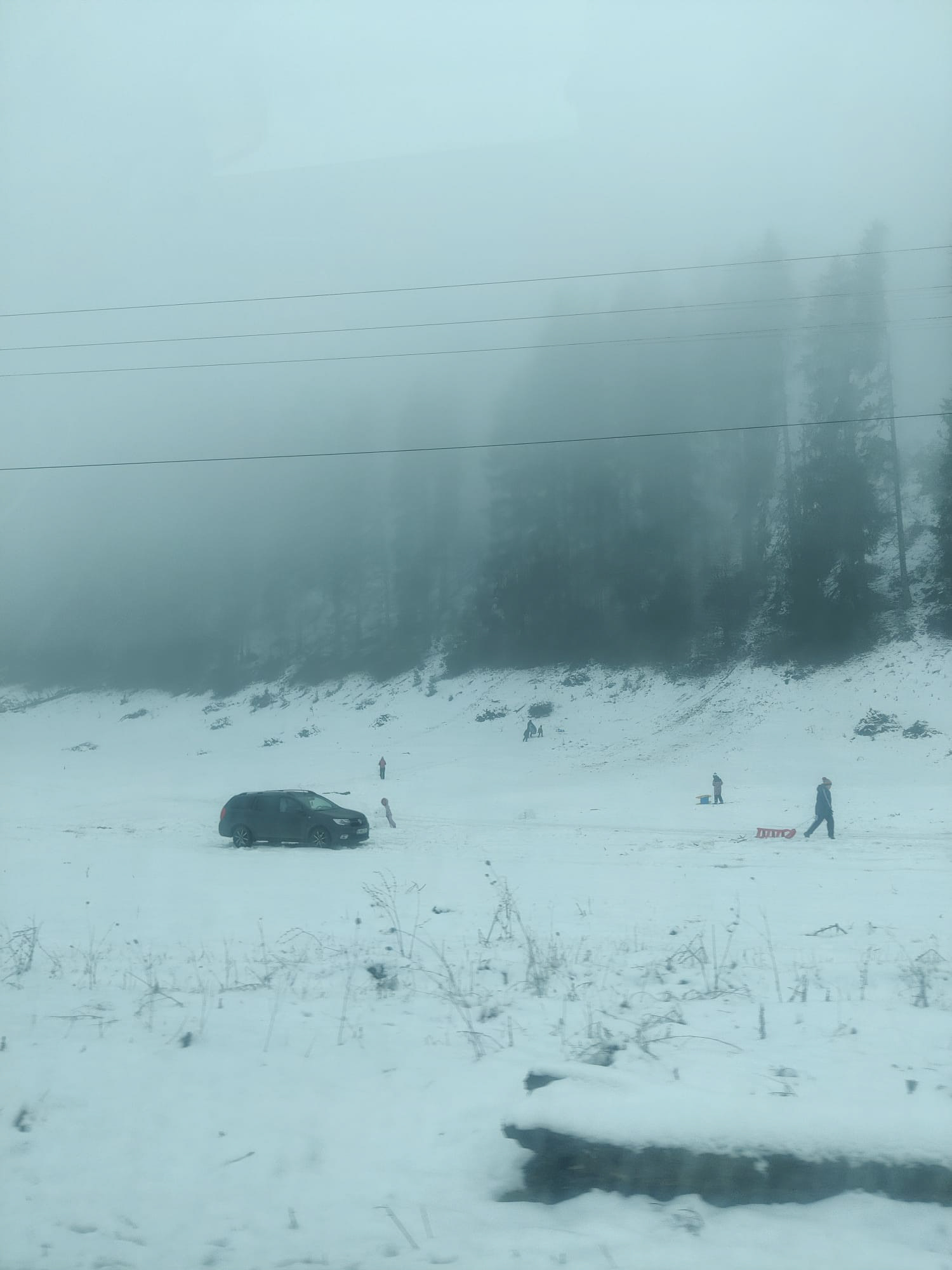

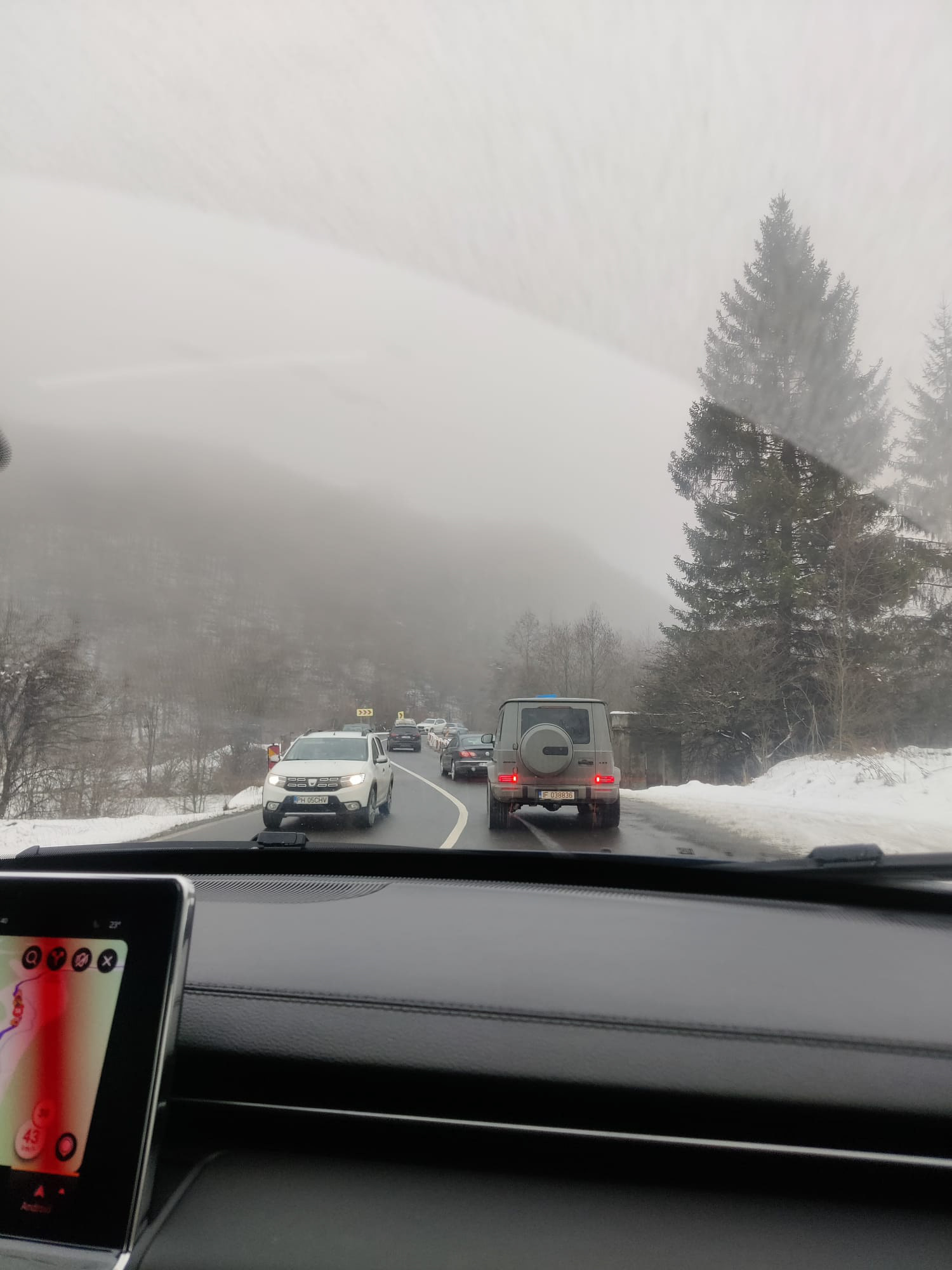
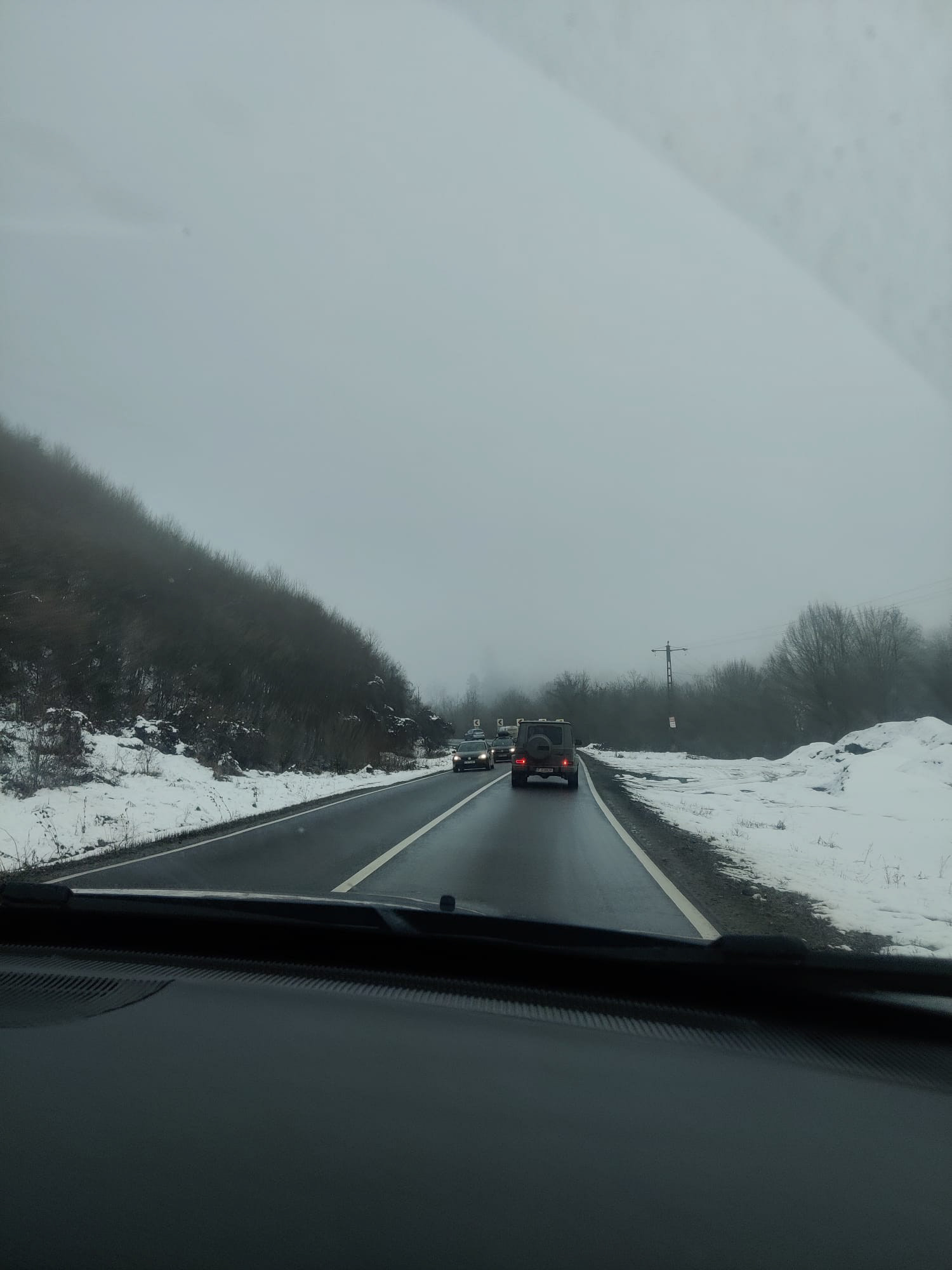
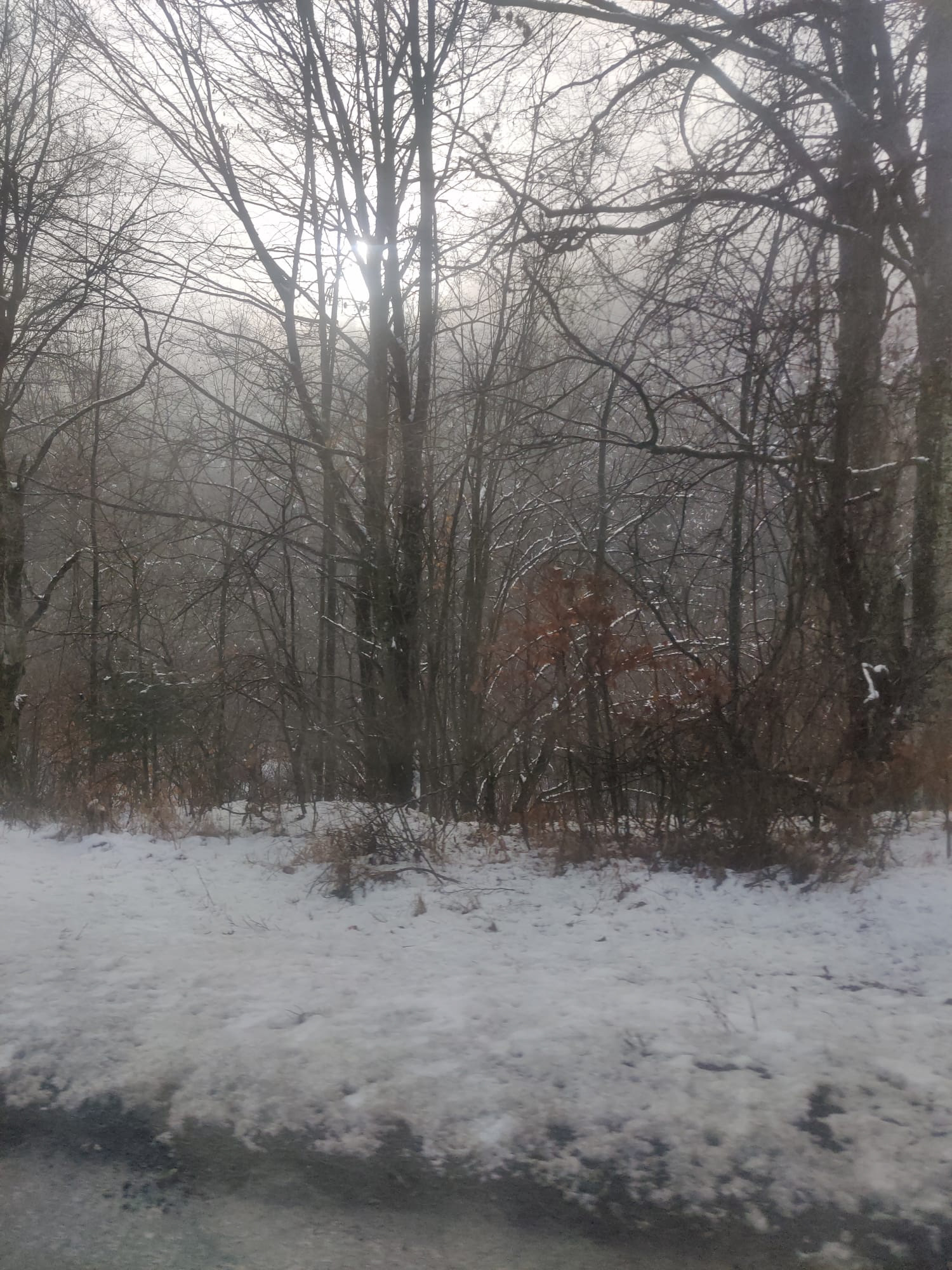
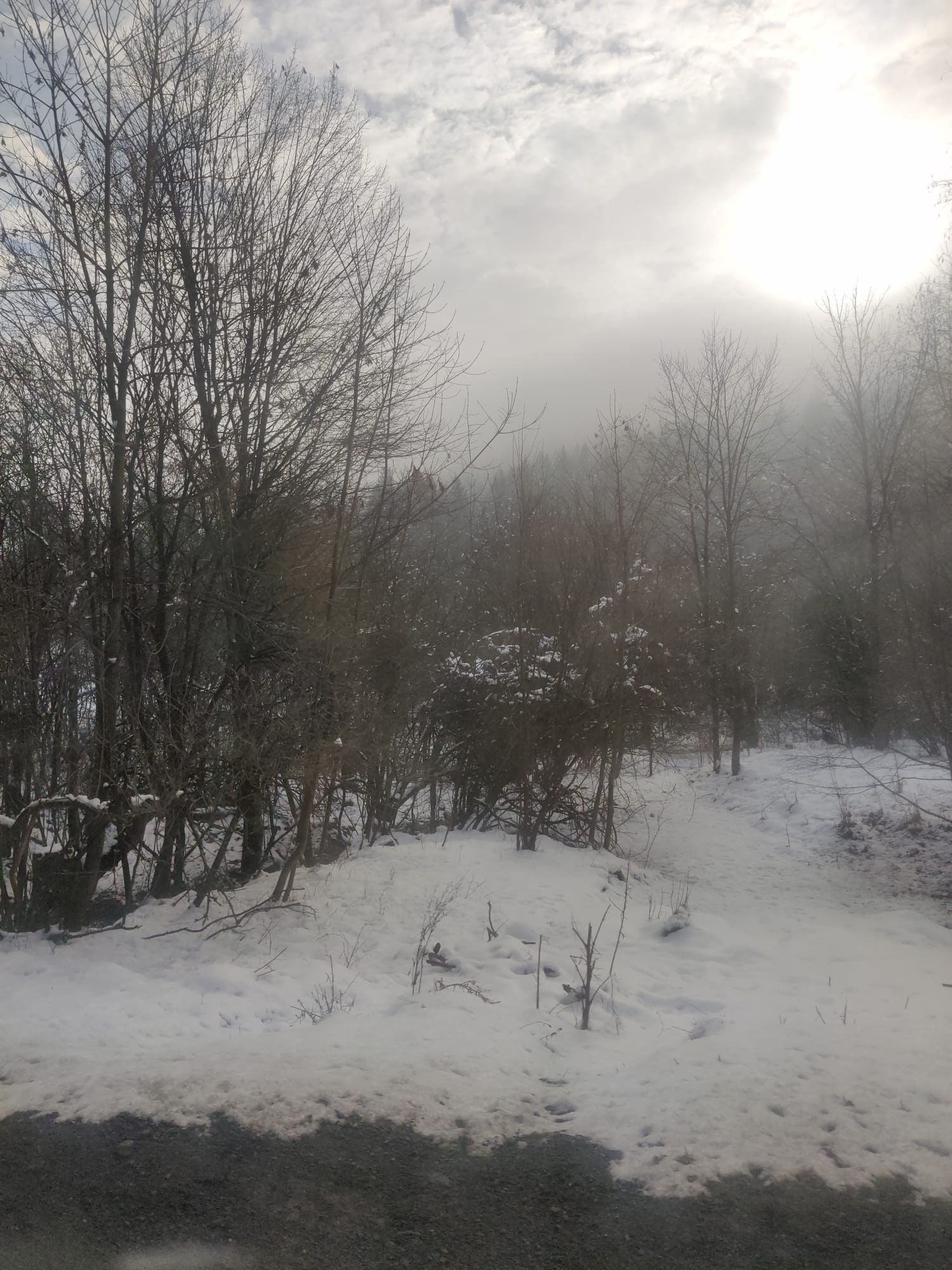

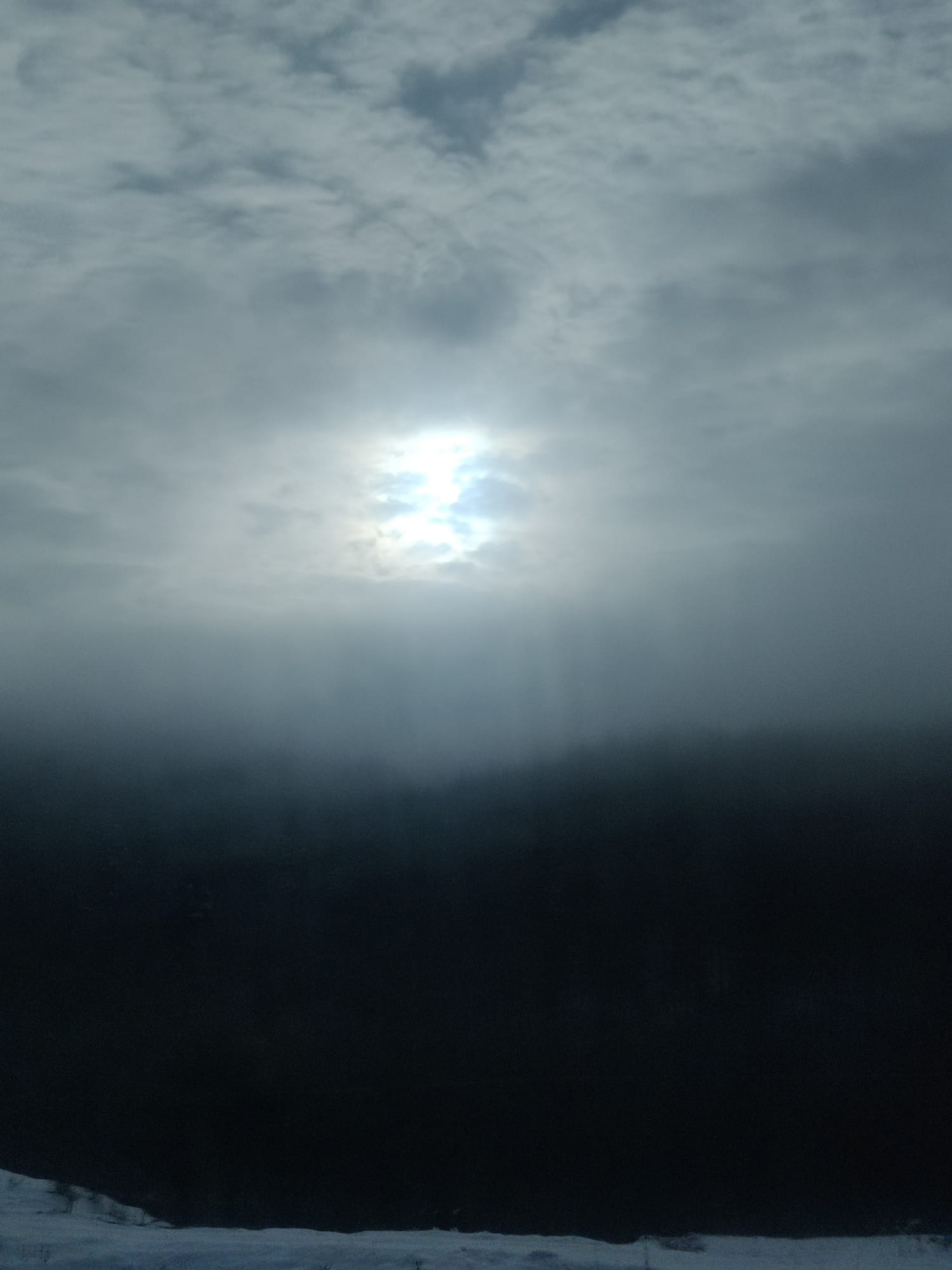

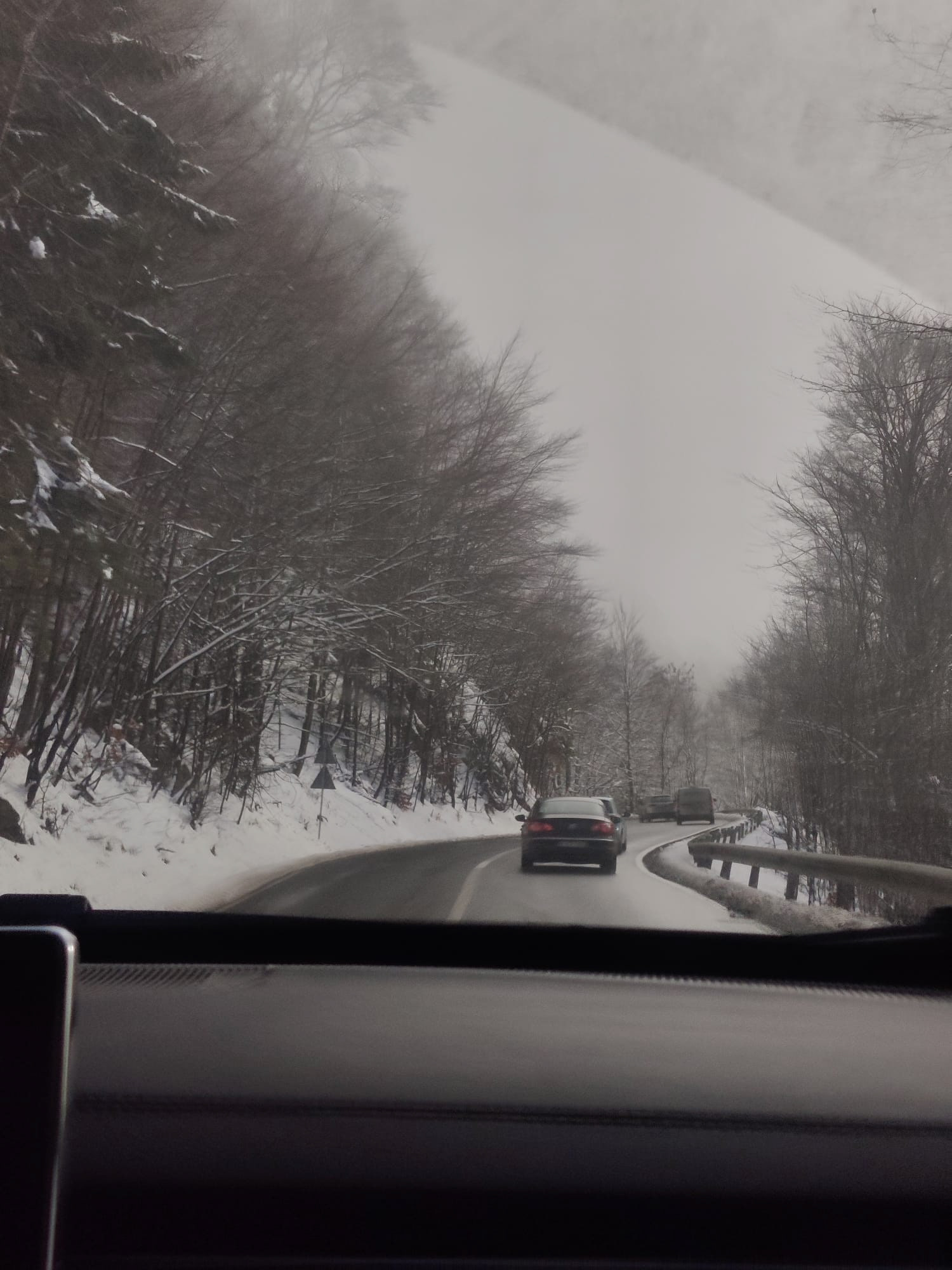
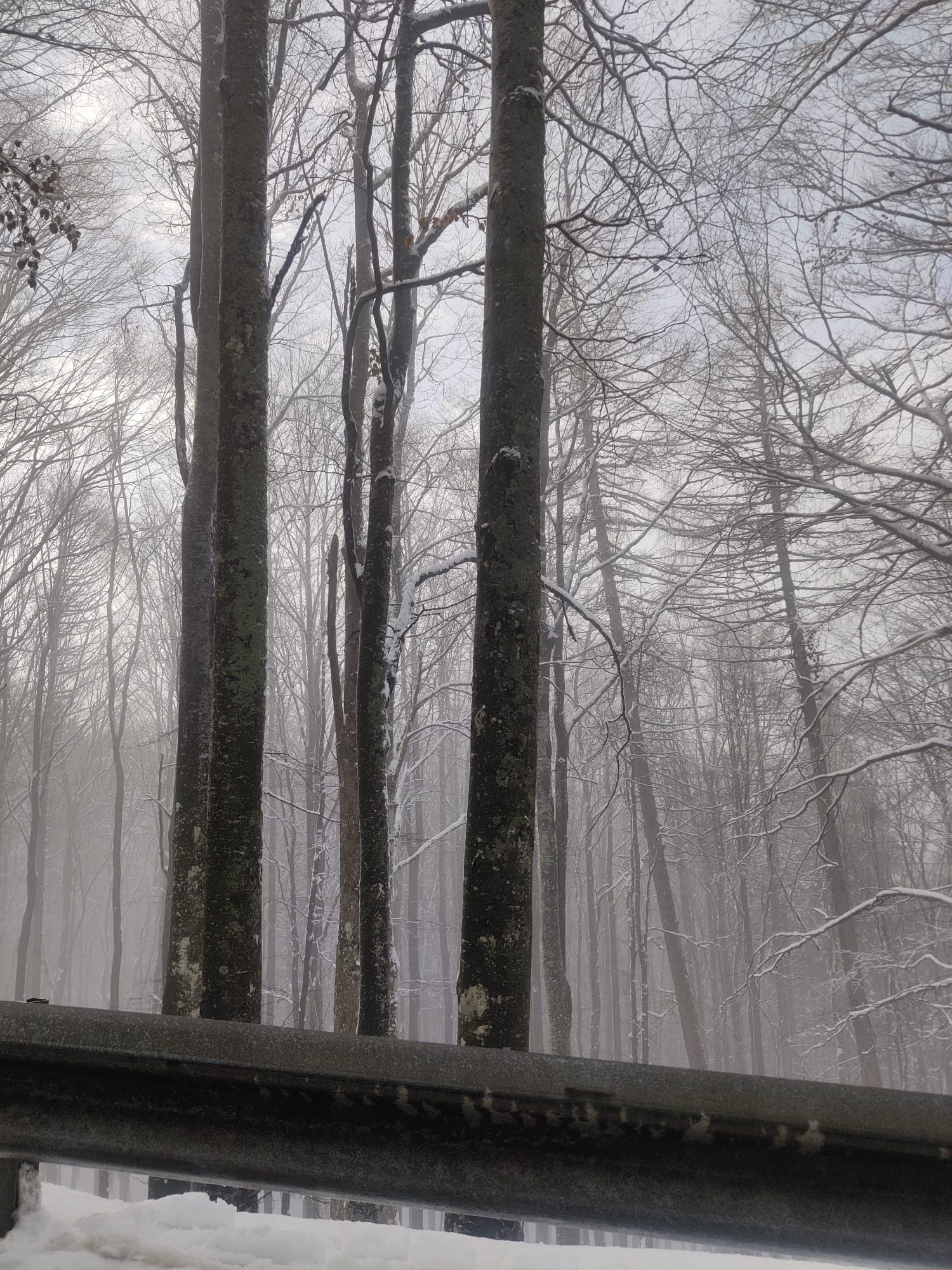

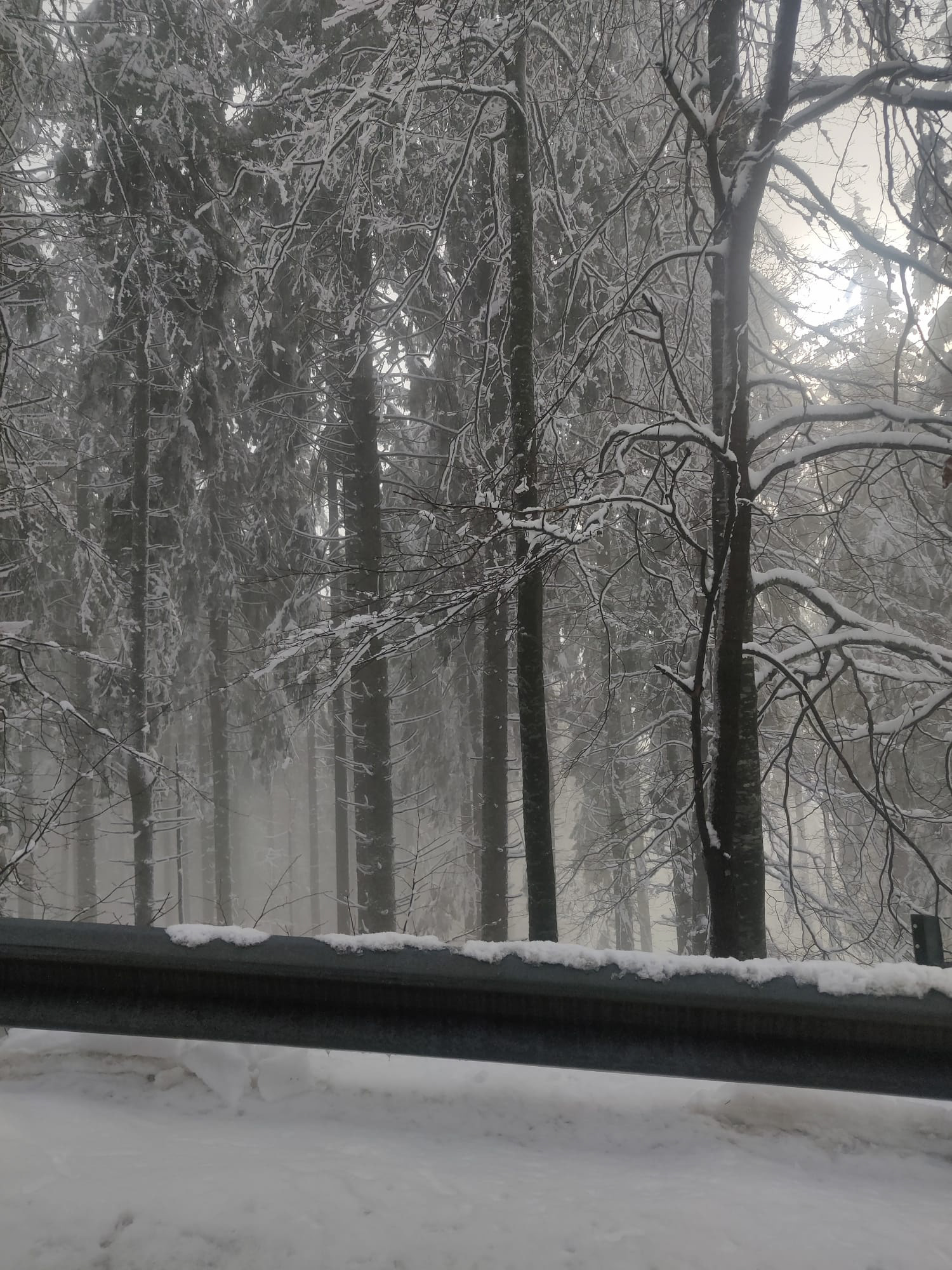
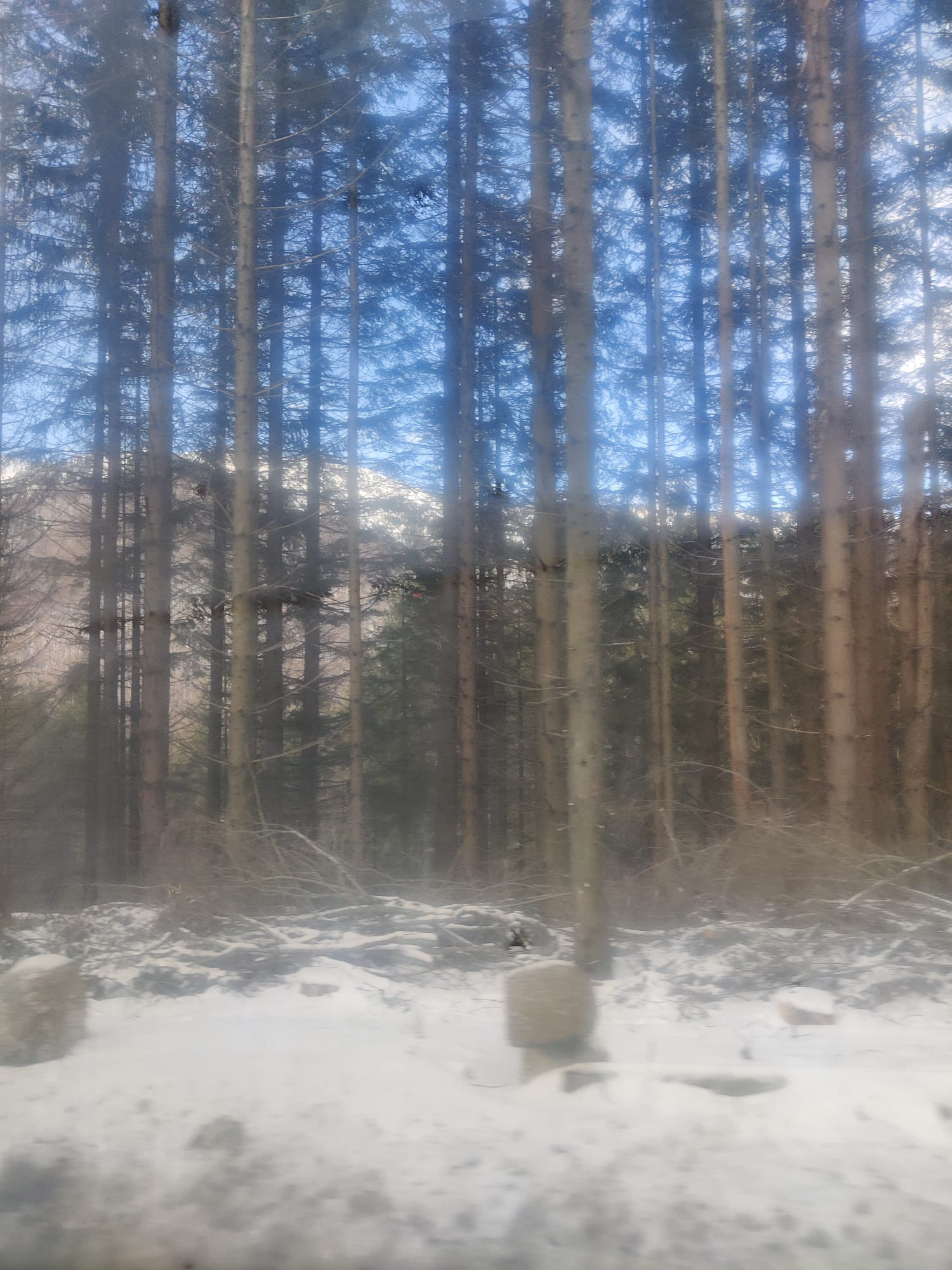
When I see a landscape I find very nice, I tend to take a picture of it, however, not only does a picture on my dusty phone not represent the photographed places accurately, but they could also never take me back there, which is what I actually want.
In response to these thoughts, I made some drawings trying to portray the eerie beauty of the foggy forest.
I kind of wish I made these drawings while in the car, as, similarly to how the drawings I made in the airport show my distress, this would have been a cool opportunity to capture the feeling of being in cold and carsick.


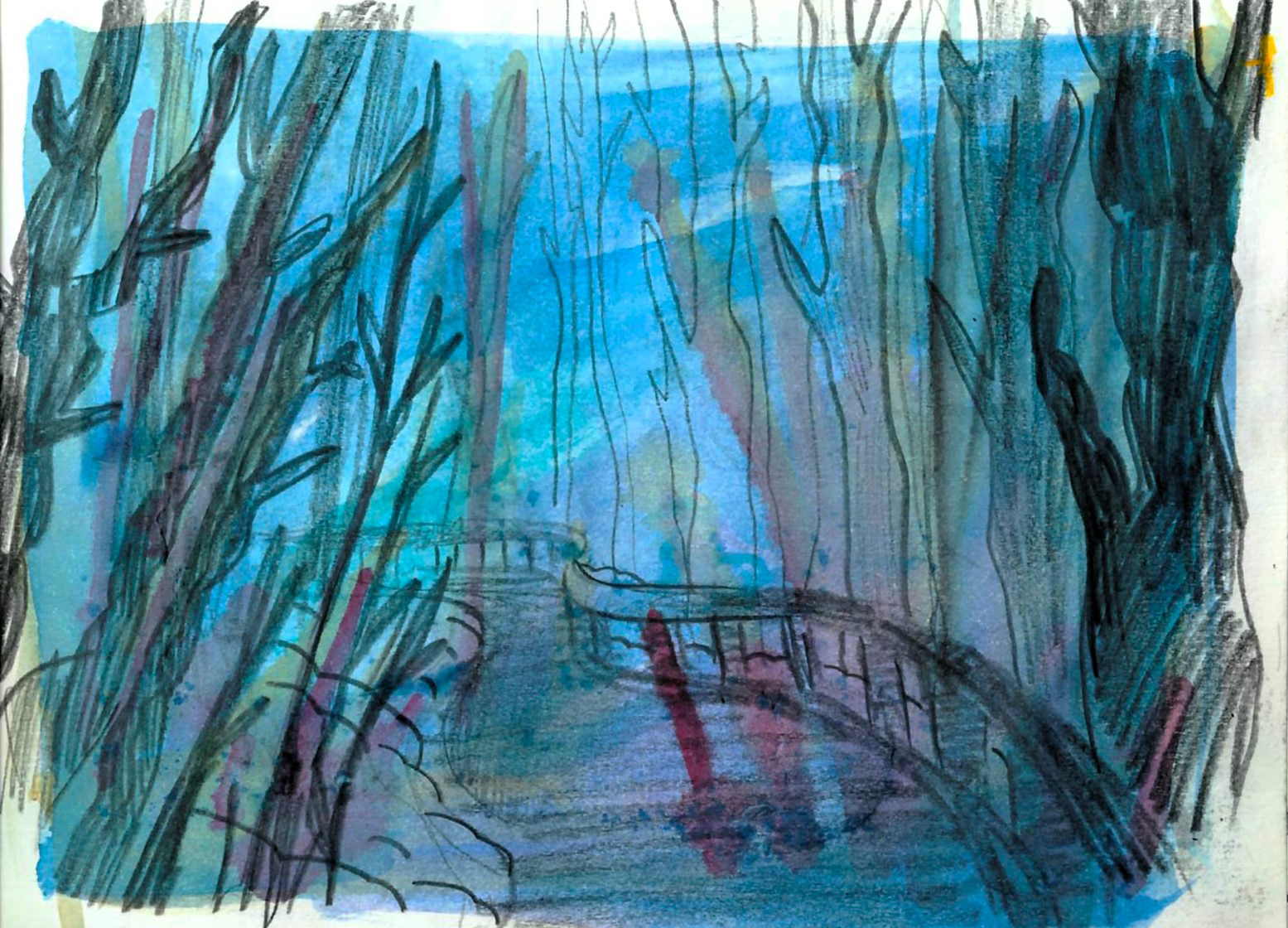
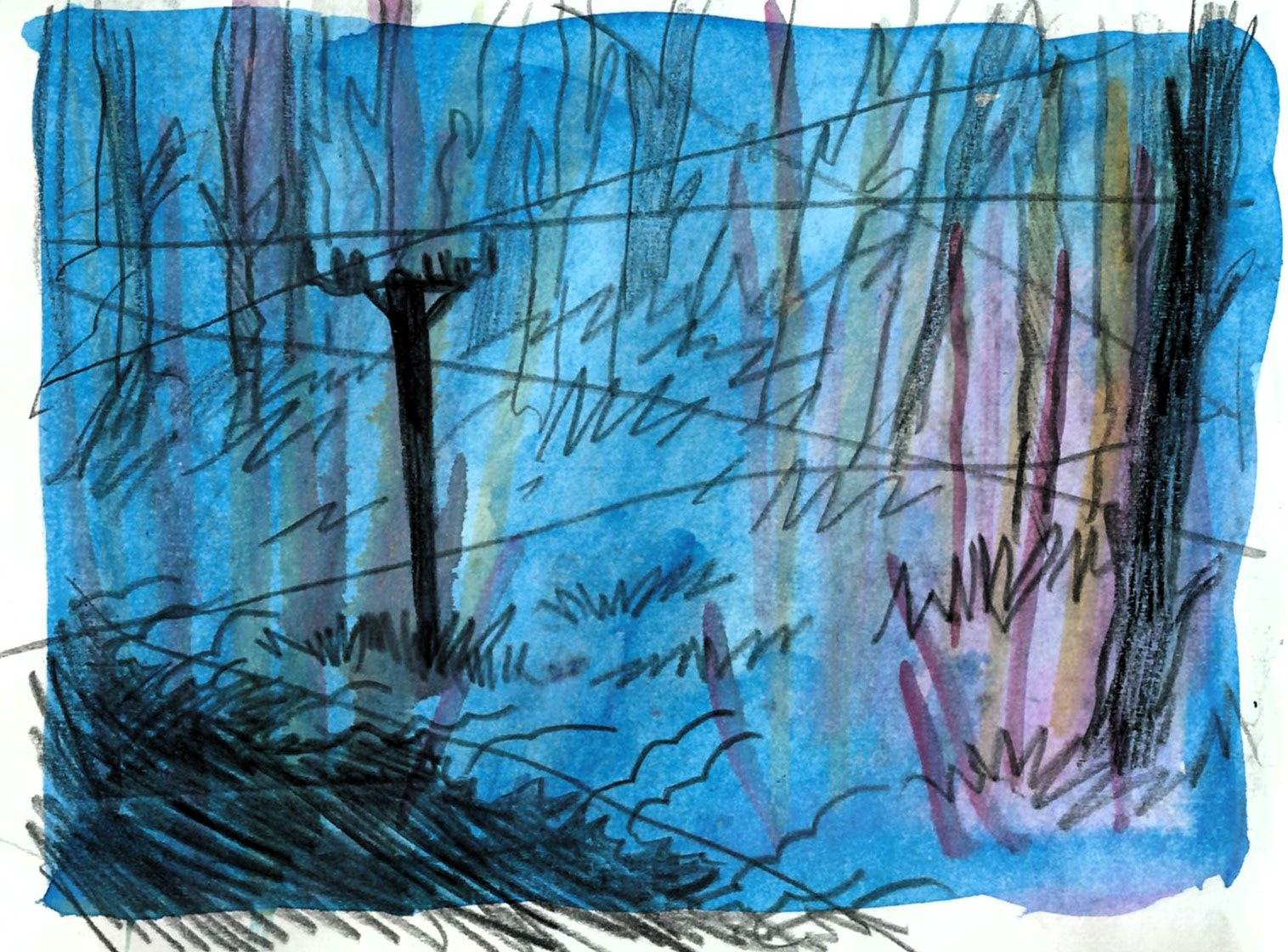


I want to still attempt to capture the feeling of being in a foggy, cold forest. I feel like painting fabric could work, due to the potential fogginess of the paint staining the fabric.
Helen Frankenthaler
I came across this artist, who uses a technique called soak staining, which seemed relatively straightforward. I this her pieces are quite evocative, particularly the first image which reminds me of a beach and the feeling of being cold and soggy whilst lying on hot sand.
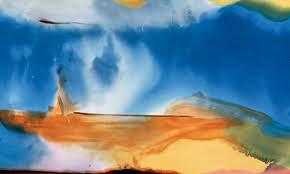
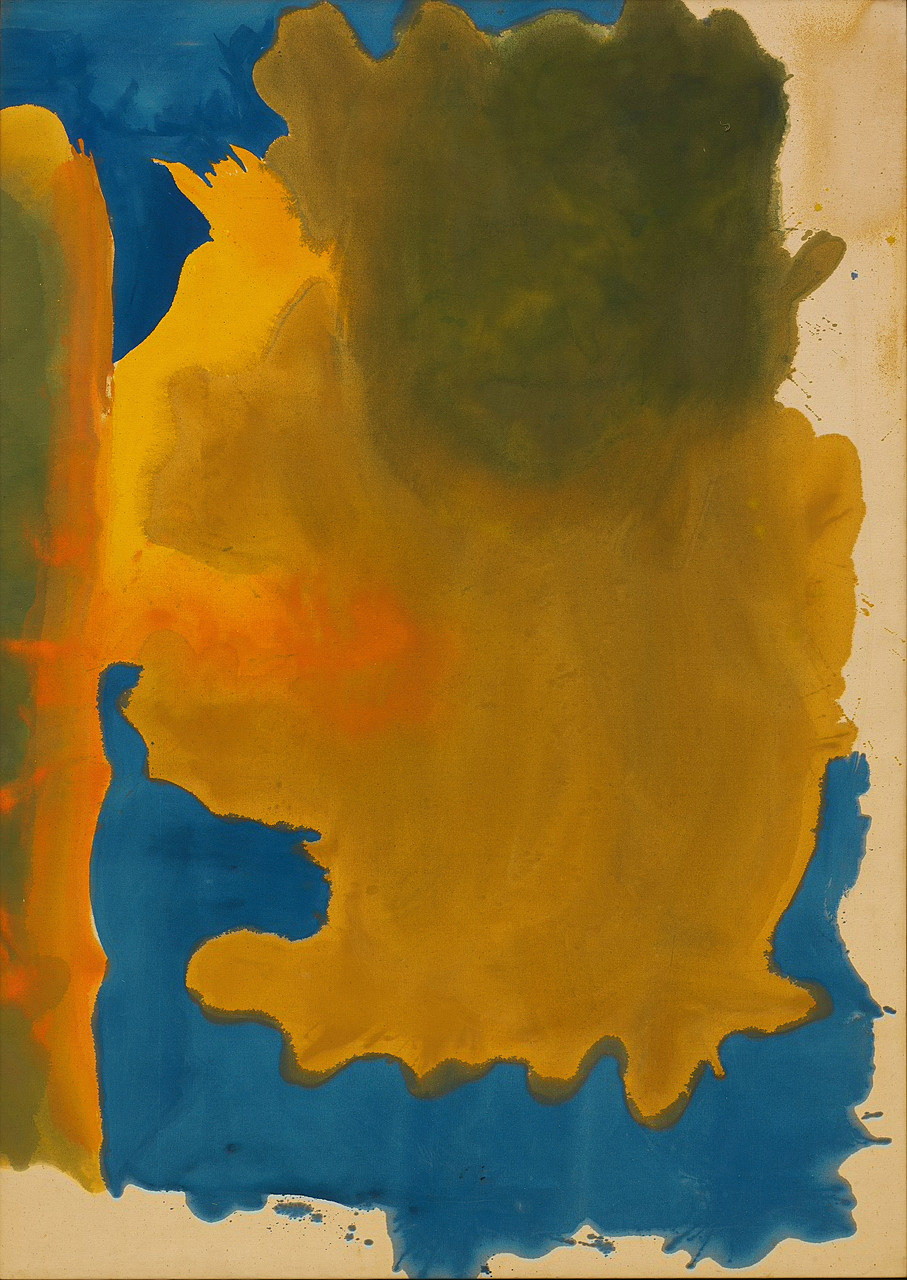

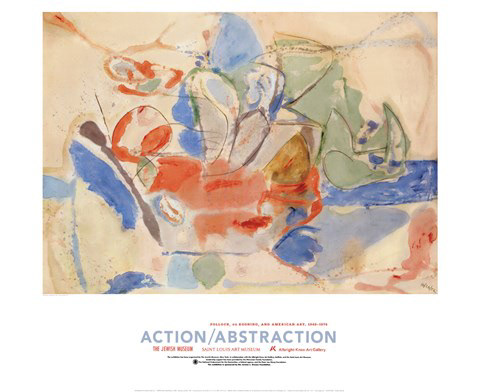
My attempts were not super successful, and I think I was definitely doing something wrong. I tried doing some further experiments digitally, over the weird stain I created(the 2 below), but they were also not that great.
I would like to work with fabric more in the future, as I really enjoyed the 1st year book cover project, in which I worked with fabric, and I have been wanting to try that again. However, I do not think this method is the best way to go about it . I would probably get way better results if I were to screen print. Nonetheless, I am still quite scared of screen-printing after some unfortunate 2nd year failures, so I might continue to try other ways of painting/ getting images onto fabric.
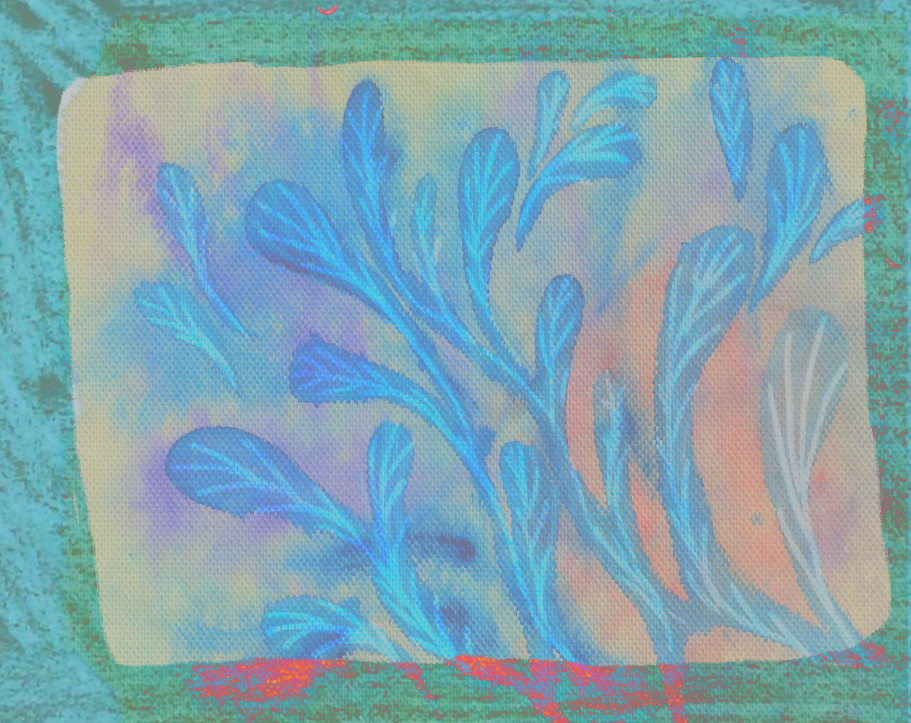
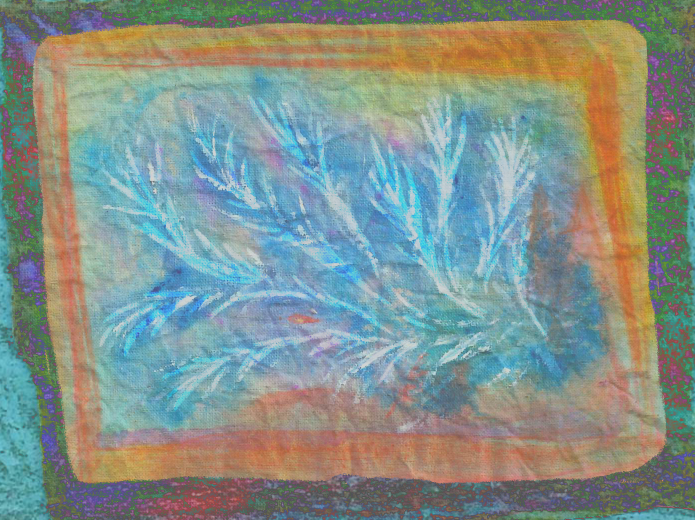
At this point, the only thing I feel like doing is to panic. We were briefed for this project quite a long time ago, and yet, I barely have anything to show for it; I definitely do not know where to go with it.
I think my problem might be that I keep jumping to different ideas without properly evaluating everything I have done. I took a minute to assess all my drawings from Christmas break , and noticed that pretty much all of the drawings were created while I was waiting for something.
I had previously noticed that a big part of my drawings was done in spaces that could be considered liminal, however, when I first took a look at the briefs at the beginning of the project, this was one of the ones I immediately crossed out, since it did not seem appealing to me.
I often like to let myself explore briefs freely, which means that often, they go in a direction that I had previously not anticipated. In this case, I decided to forsake my previous (perhaps unfounded) disdain towards the 'liminal space' brief, since, at this point, it seems like the most natural direction to go in.
During a tutorial discussion, it was recommended to me that I read the book ' The Art of Travel' by Alain de Botton. Reading this book, I related to the author in many ways. In the book, he talks about feeling betrayed by one's own home when it fails to provide the comfort that is expected of it, and turning to transient places to find this lacking comfort in the unintentional solidarity that forms in such spaces.( the biggest perpetrator probably being the airport, where you are as stuck as you can be while waiting to get on the plane).
A quote that especially resonated with me was : " It is perhaps sad books that best console us when we are sad, and to lonely service stations that we should drive when there is no one for us to hold or love".
Especially when I was in 1st year, I avoided staying in my room as much as possible, since no matter how much time I spent in there or tried to make it my own, comforting space, it never seemed like one, and it's lacking home atmosphere made me feel even worse, so I often turned to taking long, aimless walks to avoid being at home.
Overall, reading this book encouraged me to start thinking more about about transient places, specifically about the way they tend to be misunderstood. Architecturally, they are often horrific, and, as a physical space they tend to be as uncomfortable as physically possible ( just imagine slowly sliding down the cold and slippery metal chair that might be found in an airport waiting room). But, in 1st year, when the flat I was living in never felt like a home, perhaps the waiting rooms of airports and coaches ended up being more comforting.
With these thoughts in mind, I still do not really know where to go from here, and how exactly to explore these thoughts visually.
An artist mentioned in the book who tackles transient spaces is Edward Hopper. But, although the space is important in his work, the focus is placed on the human in the space, emphasising the emotions that they might be feeling in that moment. Comparatively, I feel like my winter break drawings are much more focused on the space, looking at my bus stops, even though I have hated waiting at them my whole life (and I still do), now that I no longer see them as often, the stale sights now seem almost nostalgic, and I look at my drawings with a weird sense of longing.
Since this project has been continuously stalling, I feel like I should try to approach it from a different angle. In this case, my plan is to take a page out of Edward Hoppers book and venture out into the coach and train station of Nottingham (and potentially a service station if I can get there), and to focus on drawing the people in that space.

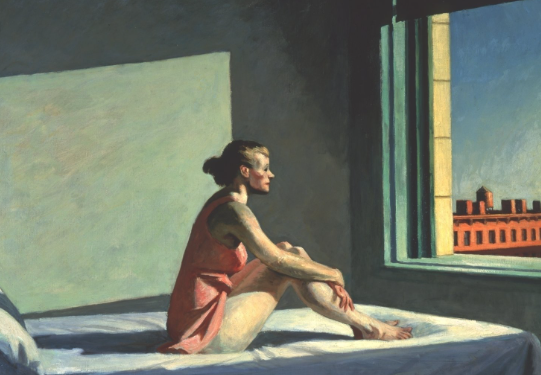

It has been drizzling every day, so I have not been going out to draw.
However, I have been referred to Marc Auge's book 'Non-places'. It has been quite a difficult read, but I tried my best to get through at least a bit of it, since it is really interesting, and I feel like it will be quite useful in informing my practice. Through this book, I got introduced to new terminology regarding my topic, specifically the term "non-places", as he defines non-anthropological places, which are a product of supermodernity, as their sole purpose is to get people from one place to another, instead of being a place in their own right. Something else that he talks about is how these places are not only isolating physically, but also in an identity sense, as they encourage anonimity, despite the fact that people spend a lot of time together in them. Although this isolation means that they tend to be denigrated, it also makes them optimal spaces for introspection and spending time purely waiting. The world we live in is quite fast paces, and waiting becomes rarer, which, at the same time, makes it seem more unbearable.
With all this in mind, I was quite excited to go out into the world and draw, with a newfound focus on non-places and people in non-places.
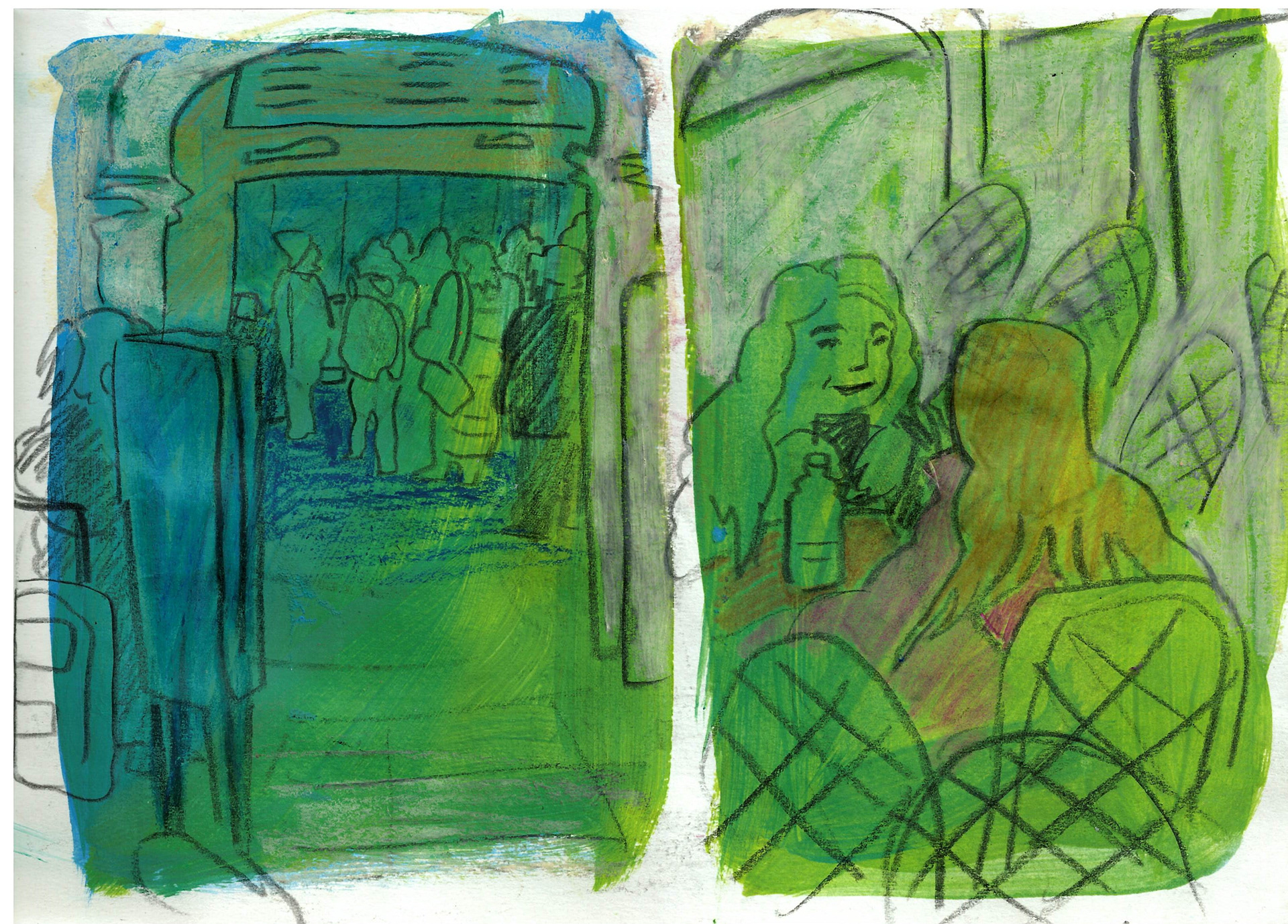



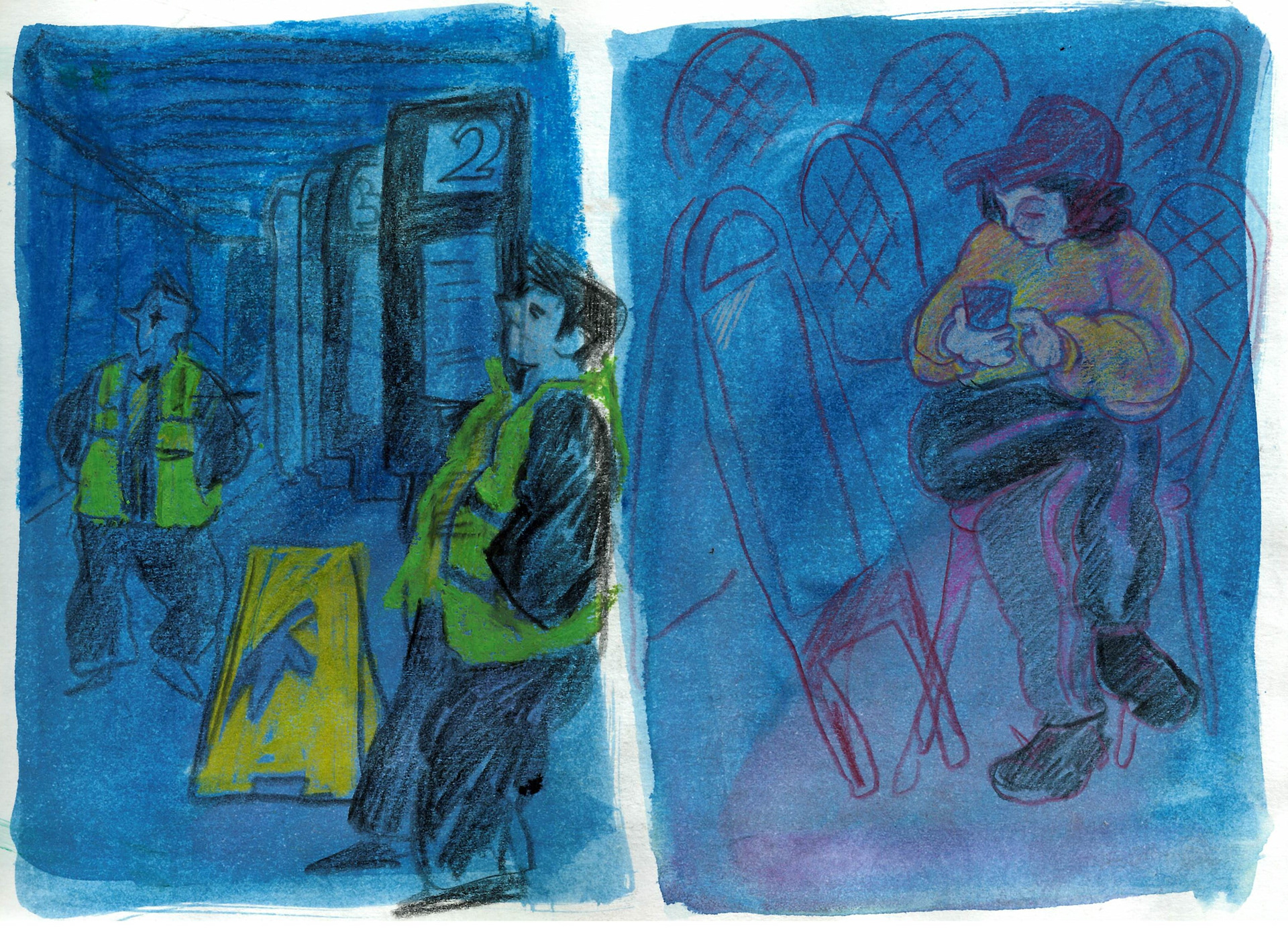
I felt really awkward while making these drawings. I feel like due to my intention of going to these places just to draw, these were not as successful, as this went from an activity that I was doing to pass the time while forcibly stuck in a non-place, to something that I chose to do. I felt like this defeated the whole point, as I was not really experiencing the isolation and liminality of these places, since I could leave whenever I wanted. It was no longer an involuntary activity.
Moreover, I felt like there was a power imbalance which made me feel a bit evil. When I drew random people in the airport, we were all equally stuck and equally forced to be there. But now, I came here with the sole purpose of observing and drawing them. I felt quite bad doing this
Aimless Exploration
Since my previous drawing sessions was very unsuccessful, I soon ventured out again. But this time, I had no specific subject in mind. While walking around without a plan, I stumbled upon more interesting things than when I had planned to go to the train and coach stations. I happened to go out on a day when a football match was going on, so there were a lot of people with red 'Nottingham Forest' hats, which I drew from multiple angles, as I was impressed by their uniformity. To me, this cemented that spontaneity is an important part of life drawing.




To come back to my failed day out drawing people - it reminded me of Wong Kar Wai's 2000 movie 'In The Mood for Love", particularly because of the huge amount of times the 'frame within a frame' technique is used, which feels voyeuristic and underlines the pressures of being observed - which is what I felt like I was doing to the people in the Nottingham coach station.
Even though I did not enjoy the experience of drawing people that day, I started thinking about how looking at people through the obstructions in the train station feels analogous to how people only reveal curated fragments of themselves in places where they only converge with eachother for brief periods, without forming a connection.
With that in mind, to play around with framing, I used my drawings from the past months that I photocopied and cut, and I created a small experimental book where I tried out different types of framing the characters. Some of the spreads came out looking quite intrusive, making the subjects feel surveilled.
Although I liked the inclusion of cut outs and the gradual reveal of the figures as I turned the pages, I was unsure about the voyeuristic feeling of the book.
I also went back to my old drawings in the sketchbook and added some cutouts to create a similar effect to the 'facets' book, but in a clearer way, since the book was getting quite messy.
I then spend the next couple of days experimenting with books that have different 3D elements, such as this tunnel book. While the exploration was pretty fun , none of them really led me anywhere else.
I briefly returned to my experiments with 'point of view' , but this time, instead of using cut-outs like in the 'facets' book, I experimented with perspective using a foldable zine, which unfolds to reveal the full picture. What I had in mind for this was eye-level perspectives, and the difference between photograohy and how we actually see the world, as our eyes need to drift through multiple details and piece them together to get the whole picture.


I then proceeded to do some more experimentation with room books, where I could create a small private space for my illustrations to sit in, as an opposition to my cut out book which was quite intrusive.
















At this point, I still did not know what to do, so I continued to aimlessly experiment with making random books. This one is a different type of room book where fold out pages can be used to design a room. This has nothing to do with anything that I have worked on up until now, however, I am feeling very directionless, so maybe a fresh approach would be nice.
Even though this might not be a surprise considering all my tests have been book formats, I have officially decided that the outcome for this project would be a book. I think one of the things that made this project stall is the fact that I could not decide, even roughly, what outcome I am aiming towards. As I am approaching the end of university, I feel like I should have expanded my horizons more, so I was aiming to create a wider variety of outcomes(and I have already made quite a few books).
However, at this point I feel like making a book would be the best thing to do for this project, since I can use a book to convey a message through a cohesive body of work, using sequential imagery. Moreover, flipping through a book can also be a journey, mirroring my journeys through the city or to my home.
After spending quite a long time feeling directionless and like nothing I have made ties together.
Since one of the things I wanted to do this year was to apply to competitions, I decided to aim to make this project into something that I can apply to the 'Batsford Prize' with.
Since I have been this aimless with this project, I thought that having a really strict deadline will force me to stop overthinking everything I do and to finish the project. Moreover, I feel like having an additional theme that I need to stick to will help me make decisions down the line, which is good because I struggle with being decisive.
One of the many things that I have been indecisive about during this project is the tone I want it to have. "Fun and Play" categorically suggests positivity, so my project should also lean into having a fairly positive tone; thinking about it like this takes the decision off my shoulders, which I am quite happy about right now.
I feel like my work in over the past year and a half has been more focused on tackling gloomy topics, so this might be a nice change of pace.
I have been trying to get a letterpress induction for quite a while, however, I have not been able to. I thought a great way to get into the spirit of fun and play would be to play around with making some letter stamps that I could use in lieu of letterpress. I also thought that, since, I will probably not have time to do letterpress for this book before the competition deadline, I could use these as a substitute.
In the end, the shapes I created were not nearly precise enough to use as nice lettering, however, I ended up having quite a bit of fun making some abstract shapes with them.







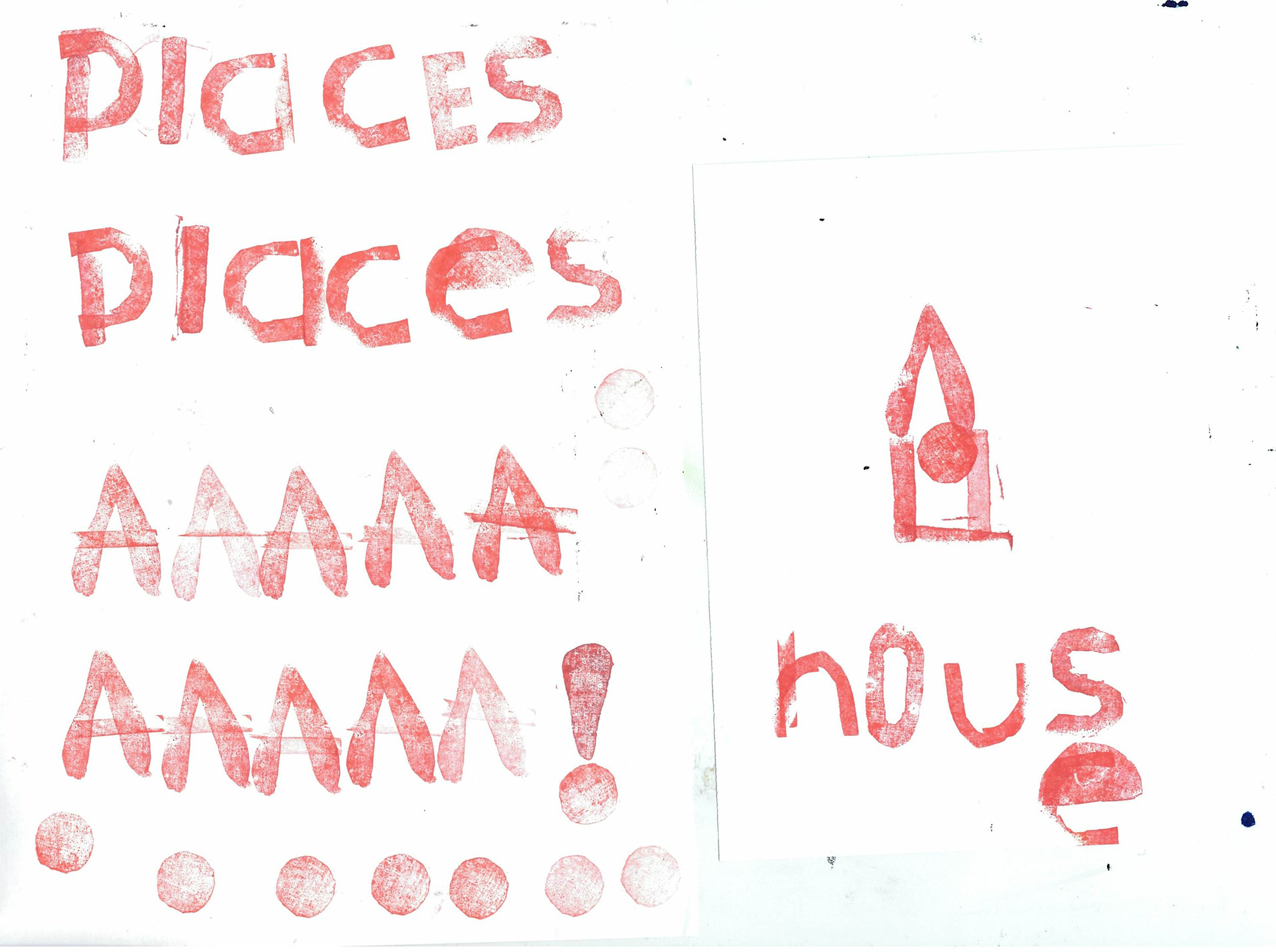
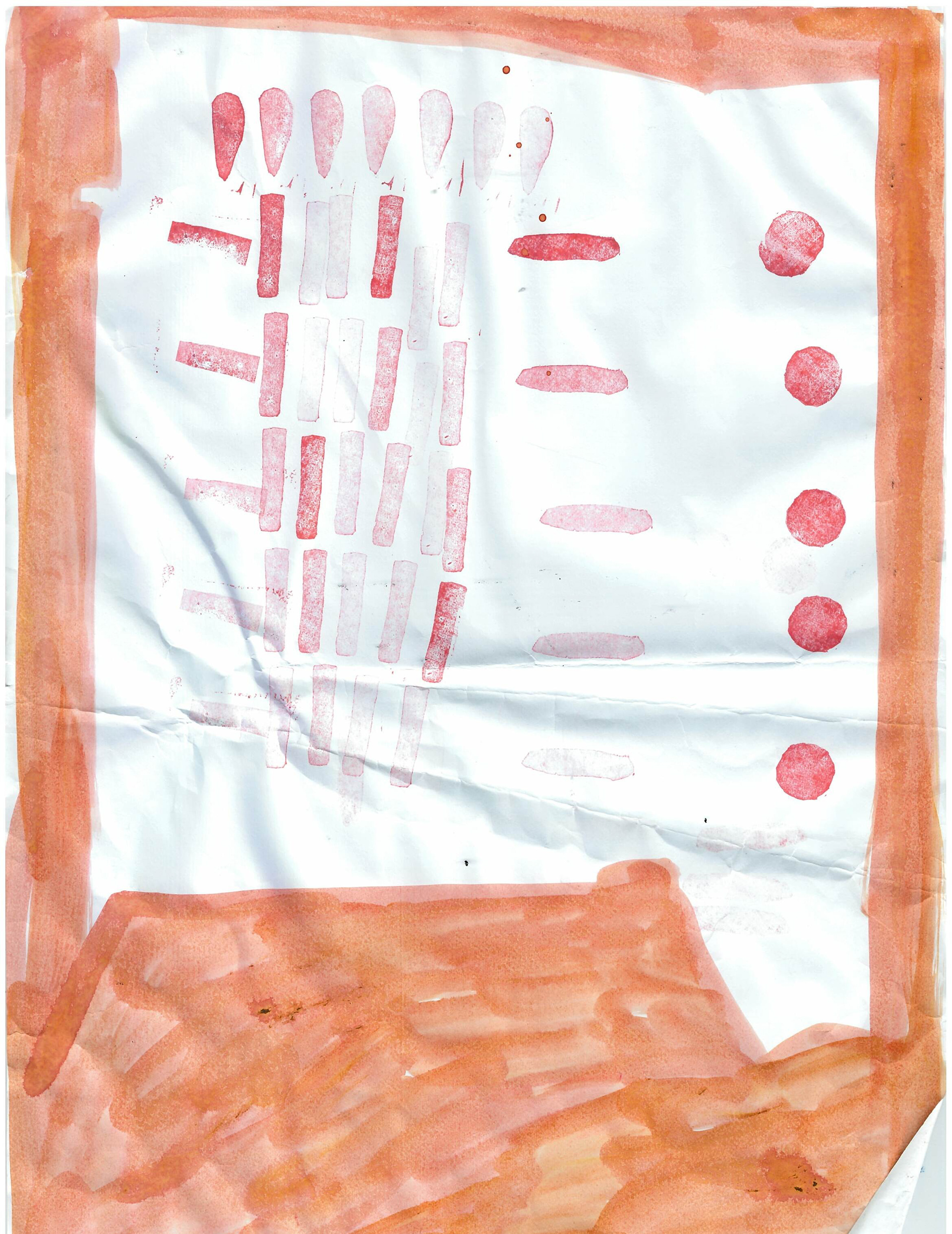

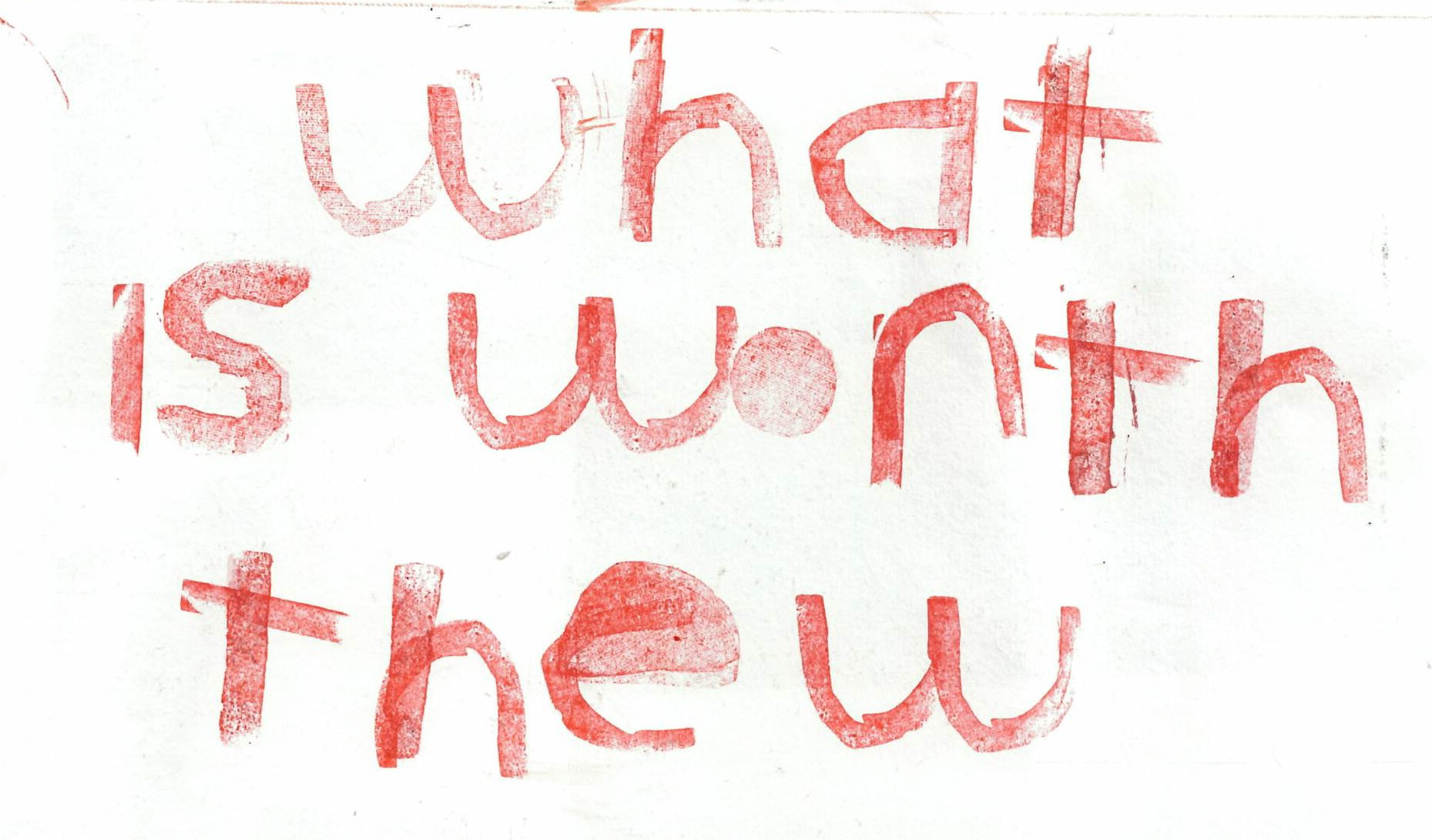


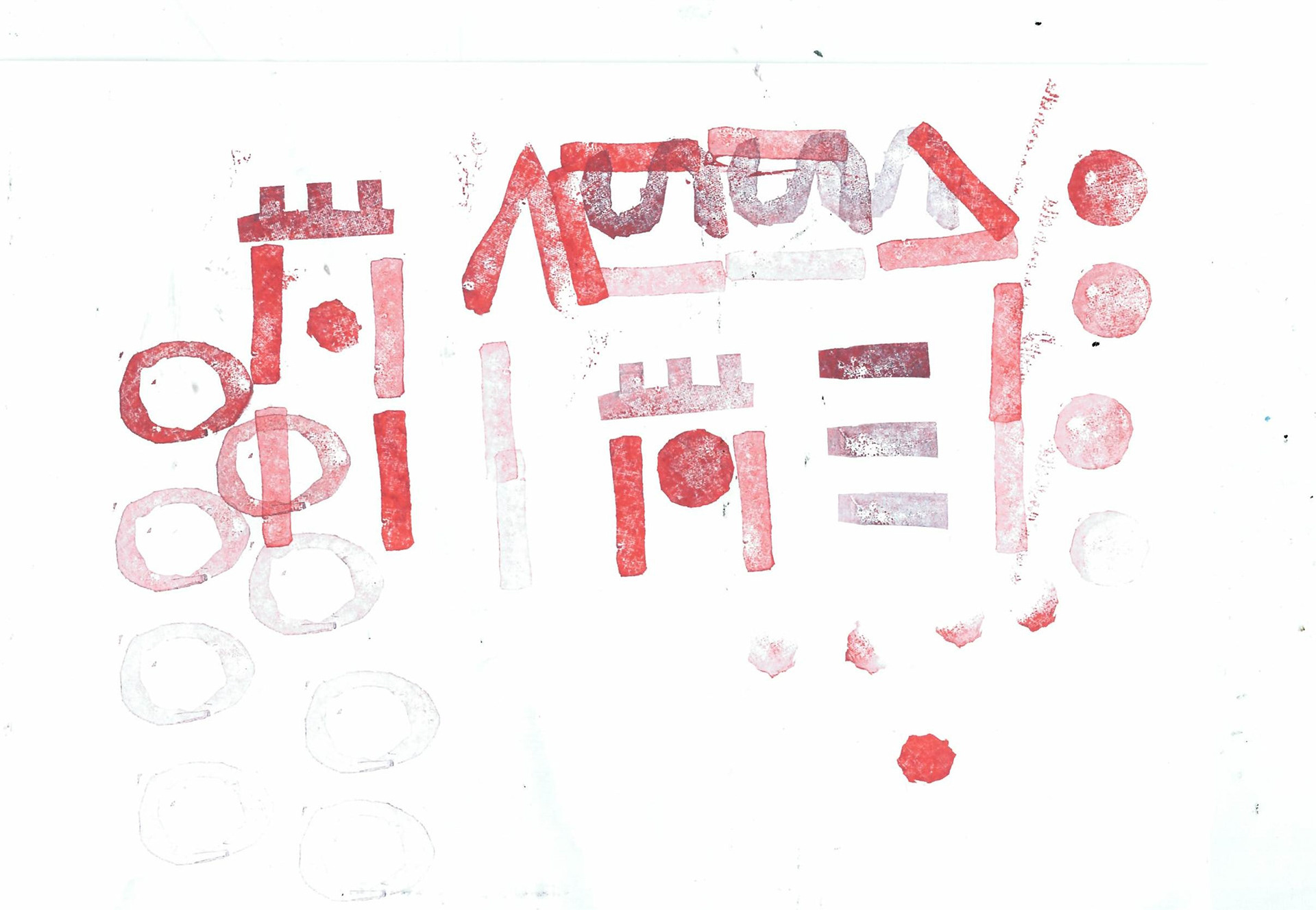
Throughout the development of this brief, I have avoided making any type of story, since felt like the topics I was looking at would fit a more abstract narrative better due to the fact that 'waiting' itself is an abstract theme.
However, since I have been feeling so aimless, I decided to ground myself into a story for the moment, to gather myself and to hopefully help me decide on some clear aims for this project.
But first, I made a mind map to help me see what the most important points to touch on are.
While this might be an odd way to problem solve, I used writing the short story as a way to simplify all my ideas which, at this point, had gotten very weird and confused.
The story is a very simple one, so I do not get off track again. The 2 main things that I wanted the story to include were 'waiting' and 'observation', since I feel like this is what has sat at the core of this very confused project.
It is about how when I was in school I used to get the bus, but since the traffic is really bad, I would either get to school way too early due to taking the earlier bus, or way too late. Whenever I took the later bus, I would always know that I was about to be late, since I would get severely stuck in traffic. Whenever this happened, I would always get really restless and think about getting off the bus and walking, even though I knew that would still take longer in the end. To distract myself, I would look at the people passing by from the bus window. I ended the book with me being sad about being late.
Looking at this story inspired by a part of my life, I realised that what I would like to say through this book is that, although frustrating, waiting can still bring on positive things, and that it should be embraced.
I feel like whenever I am not sure how to proceed with a project, creating a book always helps, due to their narrative qualities. In this case creating a very straight forward story helped me clear my mind and find my direction.
I think the story itself is alright, but I want this project to be more conceptual, so I used the story as a stepping stone to develop a more abstract book.
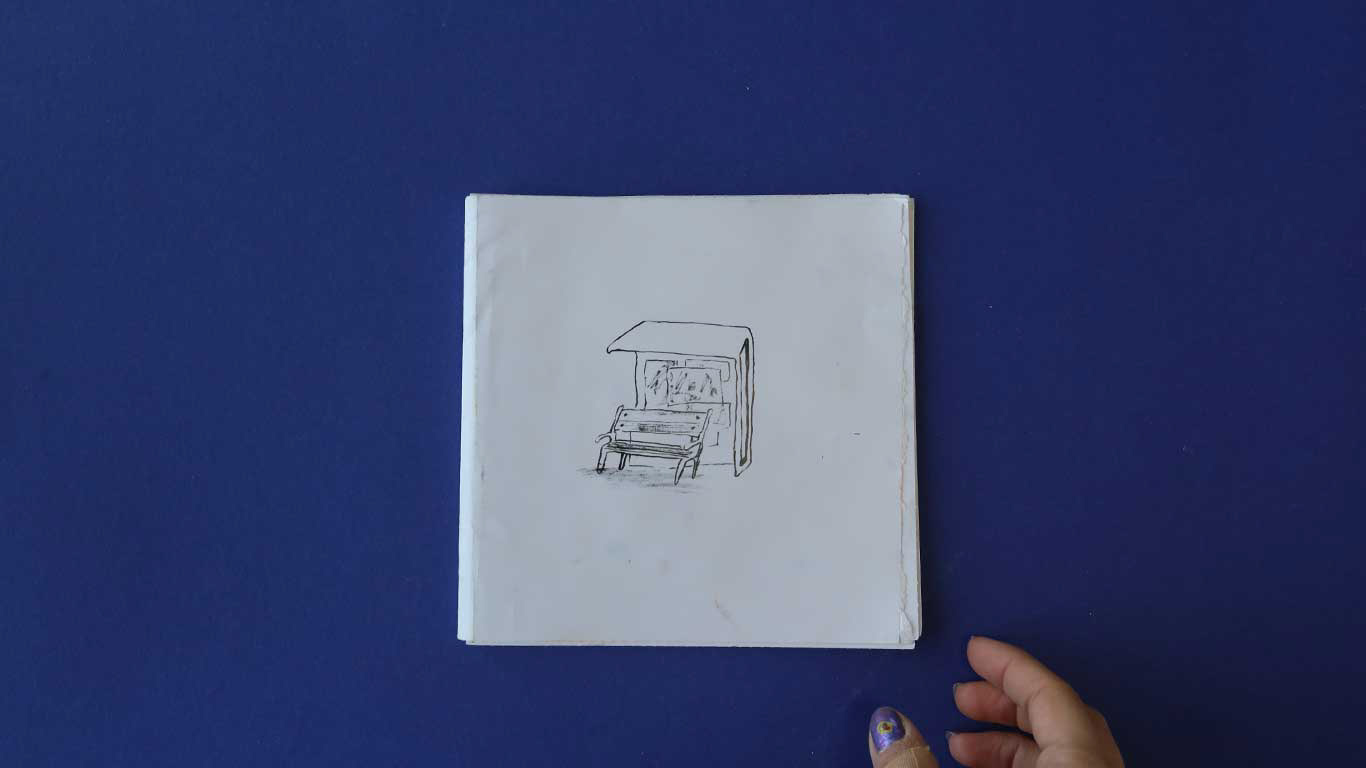
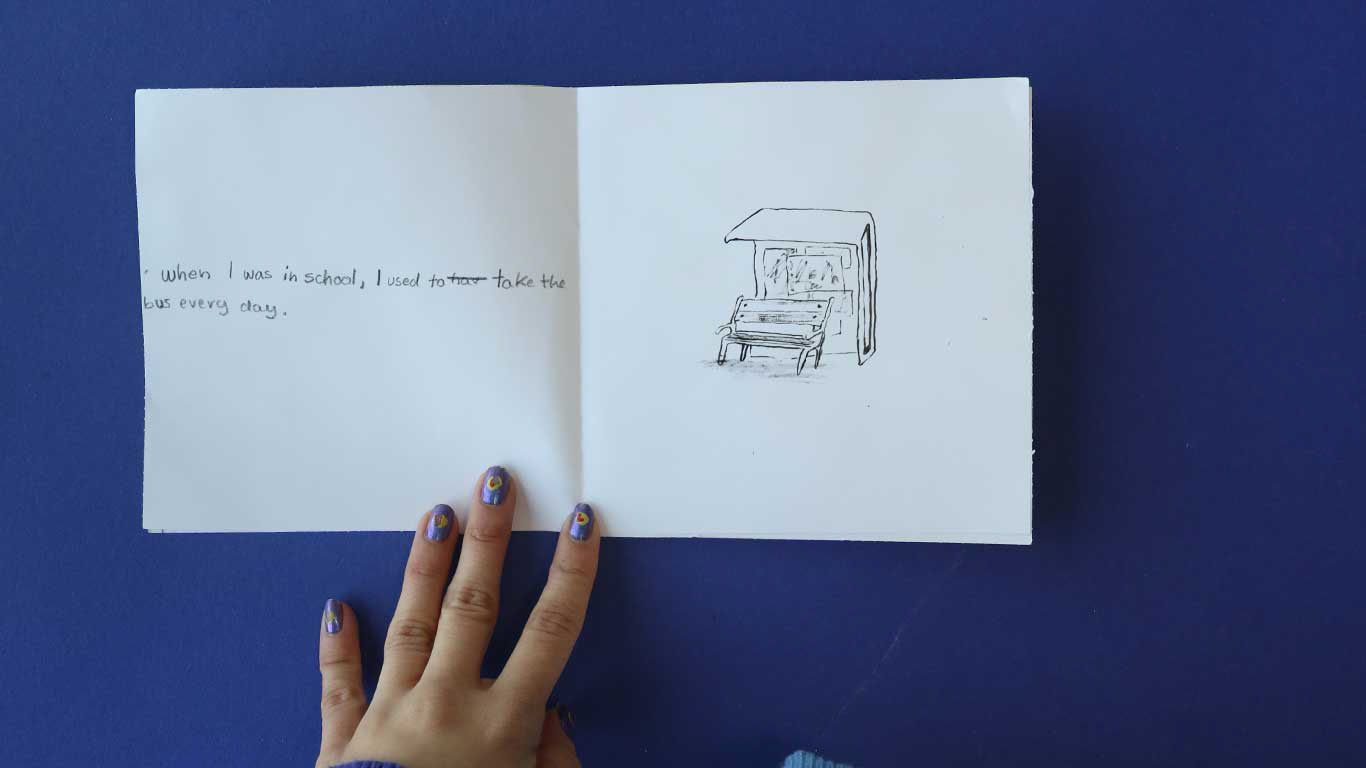

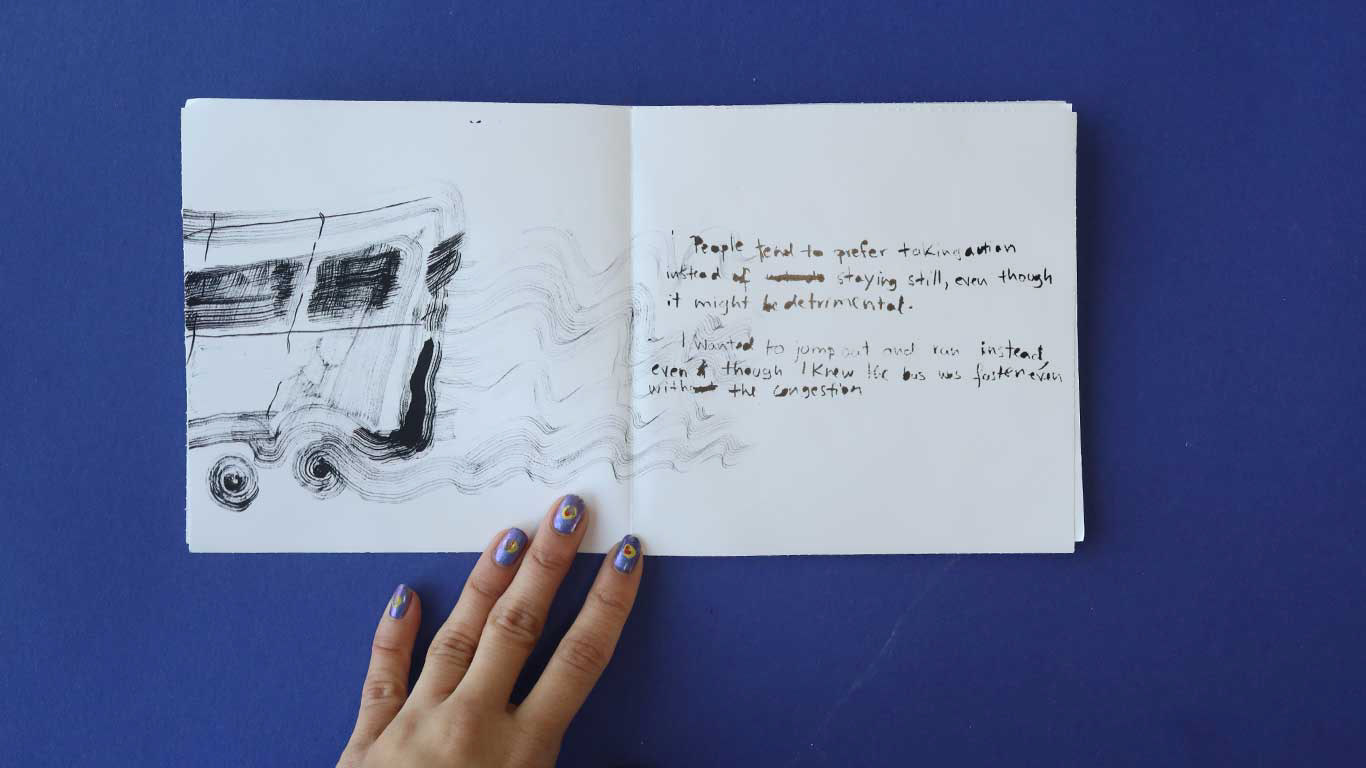

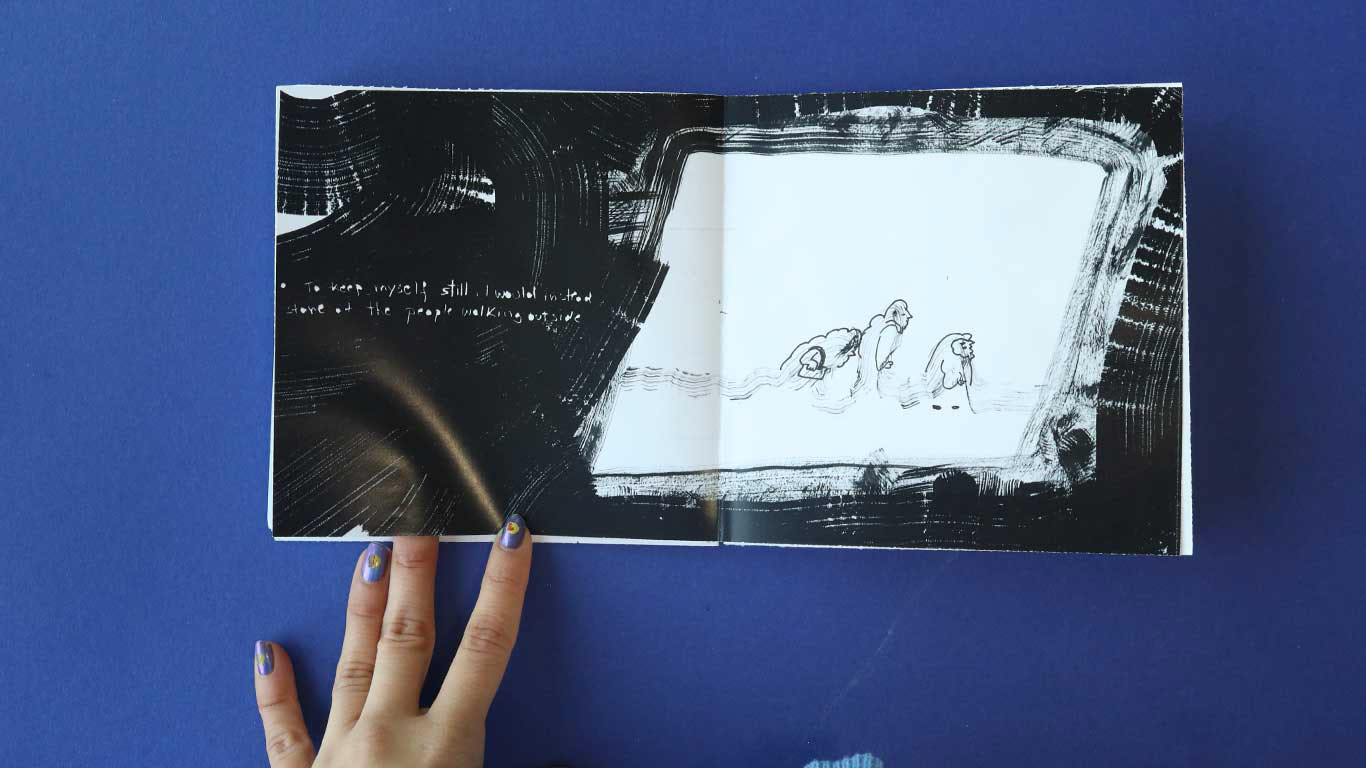
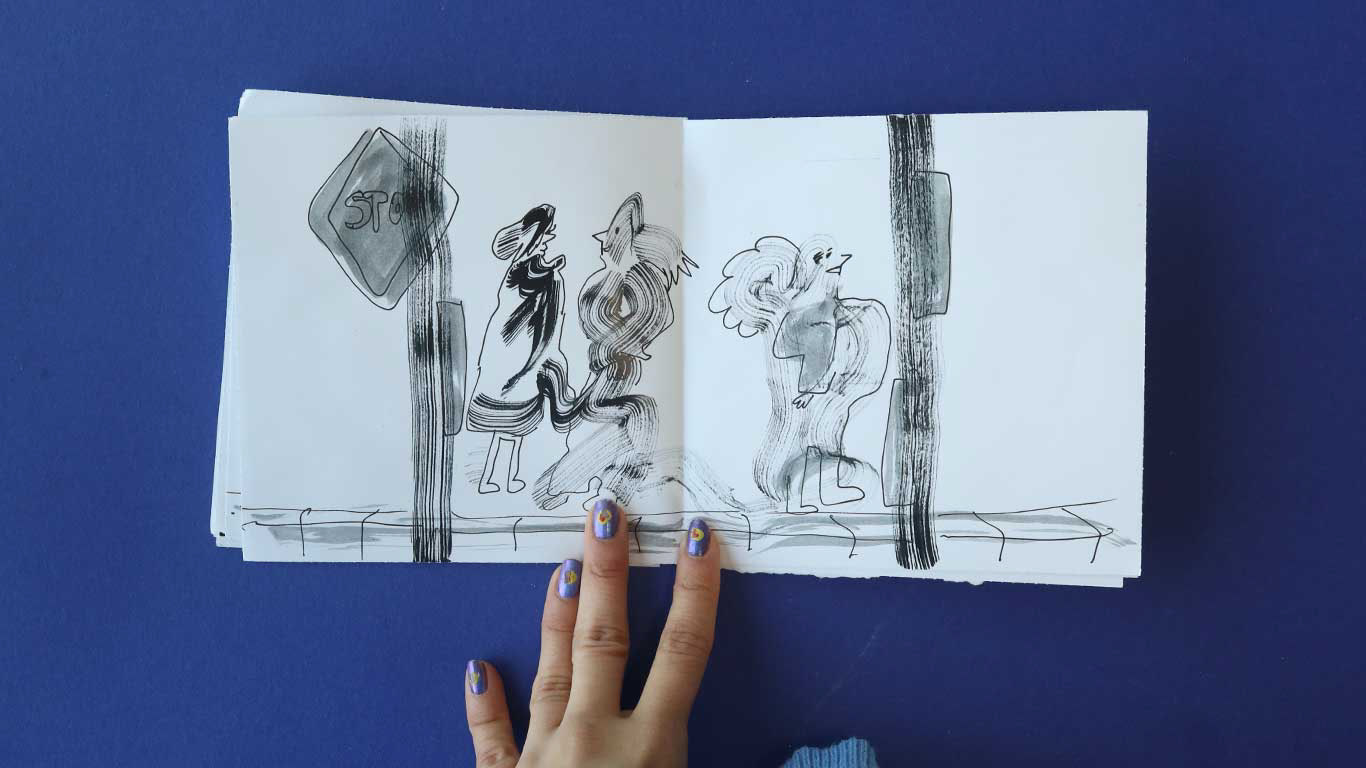
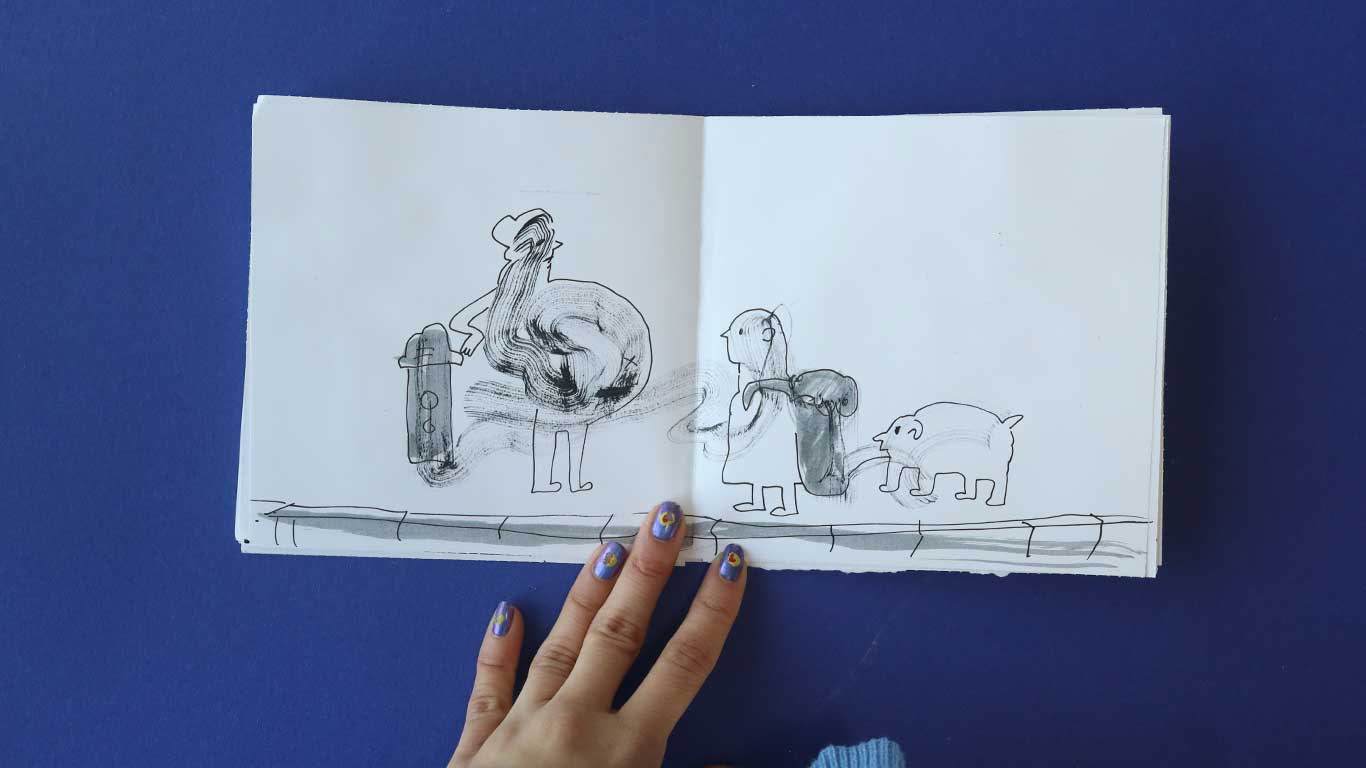
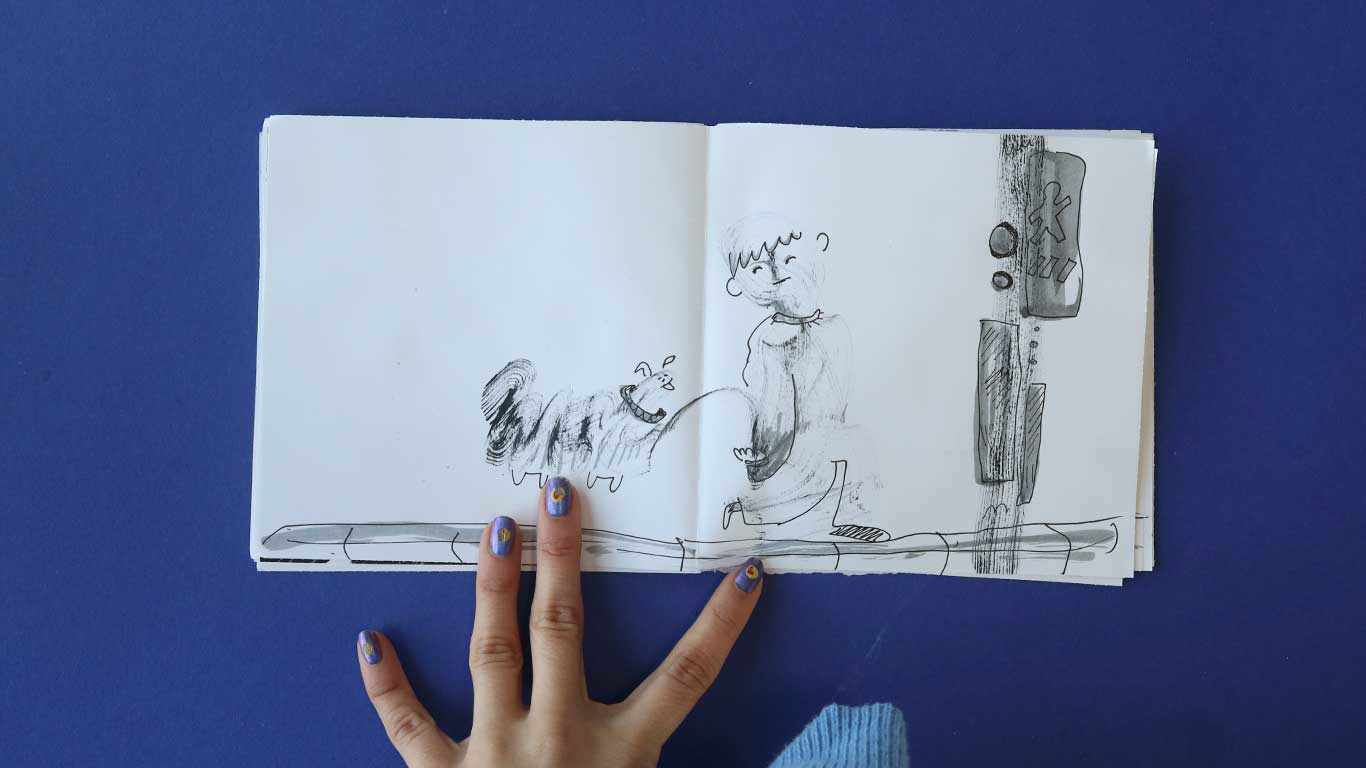
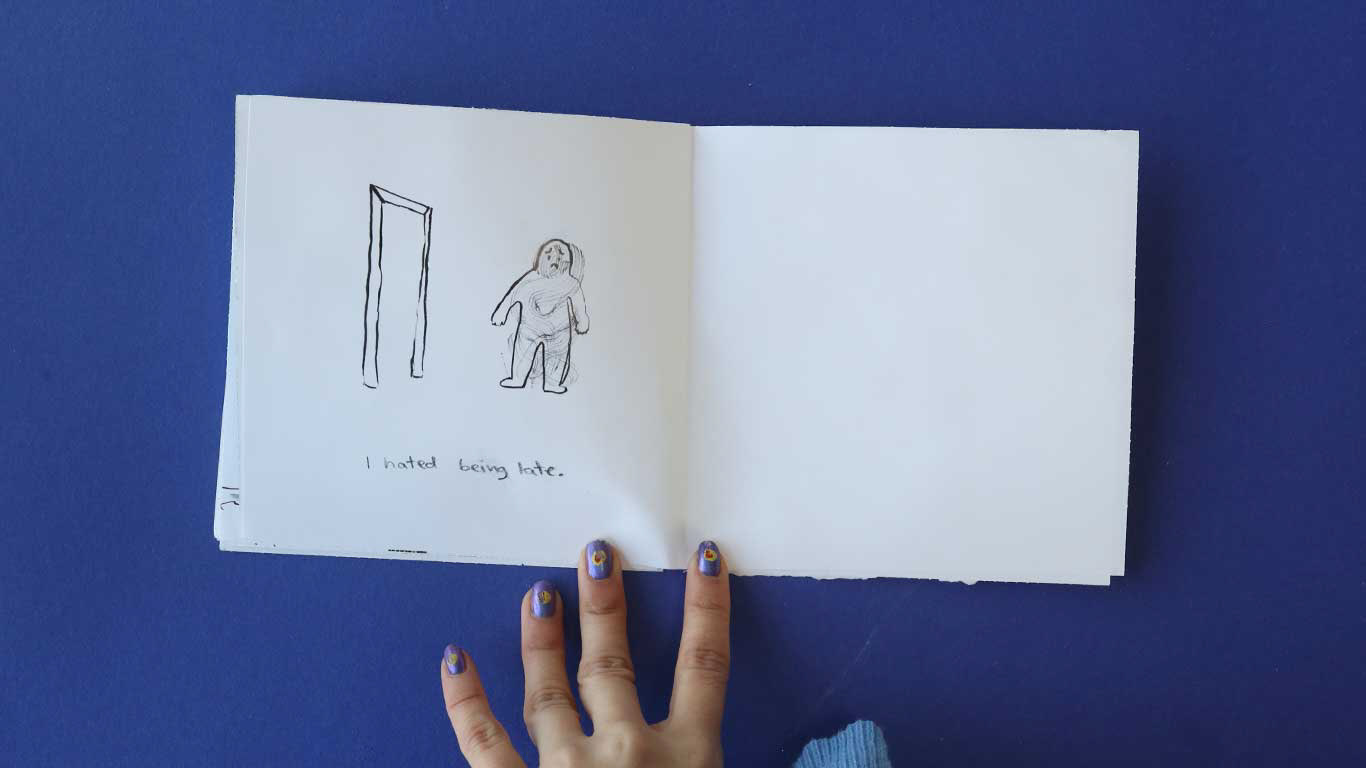
Since the subject of waiting does not necessarily exude fun and play, I tried to keep the image creation part of this brief as playful as possible. I used different materials to create flowing patterns. I used unconventional materials to create a wide array of textures that I could use in the images. Since time flows, I wanted these patterns to flow too.
After creating the patterns, I ending up in a bit of a slump again. Even though I now know what I aim to say through this book, I am not sure how to do it, or what the best visual ques to convey it are. Throughout the week, I went back and did some more observational drawings.
I still don't fully know what to do, but I have had a realisation.
Although I have decided that I don't want this project to be entirely about reportage/observational illustration, and that I want it to have some deeper meaning, I still kind of just kept being dependent reportage instead of letting myself explore freely with my ideas. I feel like this is one of the things that made me stall for a long time, as I kept drawing from life even when it was not helping me further develop the ideas. So, at this point I have decided to just use what I have gathered so as to not use up any of my time doing on-location drawing.
Similarly to my story about the bus, I wanted to start this book with some negative statements about waiting, acknowledging the fact that waiting is frustrating and then, at the end of the book, revealing that it can actually be beautiful, in spite of all the negatives. I decided on using my least favourite things to wait for for this oart of the book : waiting for the tram, queueing , and, worst of all, waiting for the washing to be done.
I felt like a lot of my reportage/observational drawings were looking quite stiff, and I was struggling with reaching a balance between pure observation and my imagination. I started looking at Martin Salisbury's book 'Drawing for illustration', in which he mentions that this is quite a common struggle, and a potential exercise to fix this would b committing a scene to memory and drawing it immediately after, without looking back again, which is what I have tried doing with the people waiting for the tram above.
After doing this for quite a while I got a bit bored, so I decided to come up with a different method of conjuring up people.
Since I have been really stressed about meeting this deadline, I have been worried that my desperation will peak through, and my drawings will no longer have a playful look to them. Thus, I decided to try creating in a way in which I will be able to relinquish more of the control that I had. I started by making a lot of blobs, on top of which I added patterns. Then, at the end I would follow the abstract shape that had been created and turn it into a quirky looking human. I did this to all the blobs, in order to create a whole queue of odd people, contrasting the boring act of queuing with the fun shapes.
As I was doing more research on the concept of waiting, I found out about the play " Waiting for Godot" which has been described as a play were nothing happens in the first act, and then, in the second act, nothing happens again. I was heavily inspired by this play, not only because of the central theme of waiting, but also because of the absurdity of the play , which makes it really funny.
I tried to recreate the exagerated longwindedness of the play by using the patterns that I have previously created, and using them as a sort of 'waiting world', in which I placed a tiny person that slowly inches away from a chair, towards a bus stop.
As I was trying to do as much exploration with the way I created the images as possible, I decided on doing some collage too. Since I was using a lot of different materials, I was a bit concerned that the book would look inconsistent, so for these two images, I tried combining some different elements to tie together the more patterns parts of the book to the rest of it.
One illustrator who has particularly inspired me on this journey of media exploration is Takako Aoki, due to their commitment to create with so many different materials, and combining them all together, creating beautifully quirky compositions.
I kept going, trying out different materials and manners of creating.
At this stage, I had not actually started planning out the book. I believe that exploring with materials at this stage of the project being more of a distraction, rather than being helpful, as I was still not sure how to structure the book beyond the bare bones.
Looking back at my work from the past week, I feel like the blob-people experiments were the most successful in the sense that I was able to create illustrations without being overly reliant on observational drawing. Since observing people is at the core of my project, I decided to explore more exaggerated ways of representing them.
Amber Vittoria
Women In The Workplace
Women In The Workplace
An artist whom I have looked at is Amber Vittoria, specifically her 'Women in the Workplace' project, but also her collaboration with Cuyana. She uses non traditional women forms, exagerated to center their personalities, their inner world bleeding into their squiggly appearance.
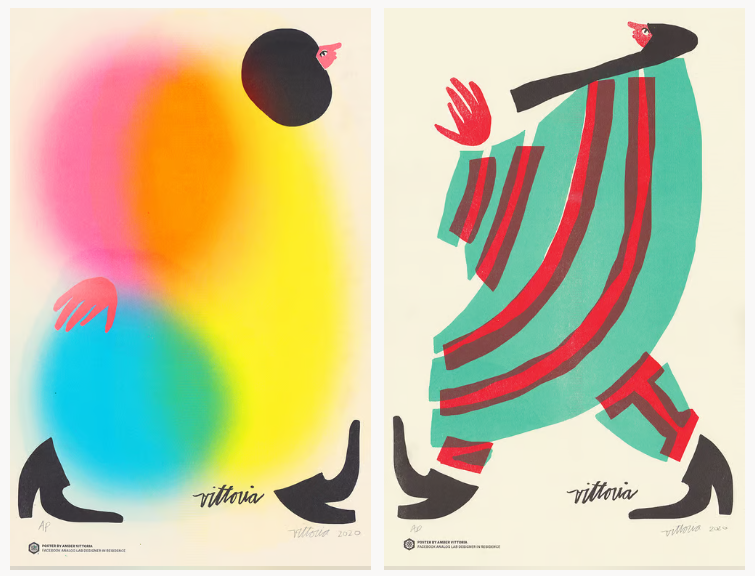


Inspired by Vittorias' work, I looked at figures from my observational drawings and reinterpreted them, focusing on using expressive, squiggly forms that tie them together to create a queue of quirky characters whose faiths have briefly entangled on the bus.
The bus peoples faiths are temporarly tied together by their shared goal of getting somewhere, only to then fade away on their separate ways.
I liked the squiggles a lot, so I think I am planning to use it as a motif throughout the final pieces in the book, to try and get them to look cohesive.
1st mock-book
As the deadline for the competition was approaching, I still did not have a fully finished structure of the book, so I decided to get right to mocking it up. At this point, a lot of my time was spent overthinking and not moving forward, so, I decided to just print everything I had and piece it together into a book, and fill it in or cut stuff out from that point, tackling the project with a reductive strategy. By planning the book through the mock-ups, I was able to come up with a way to loosely organise the book into chapters to create a narrative. I tried out multiple versions, trying to work out the best way to make the book flow.
Initially, I started by intertwining the 'waiting for godot' inspired images of the book, with the images representing the negative parts of waiting (queueing, waiting for the tram). I started the book out with the question "what is worth the wait?" to which the answer would be "it does not matter", since waiting is just a part of life.
To continue the development of the book, I started coming up with a visual list of unpleasant waiting activities, such as being in the tram or on the plane; as well as a list of beautiful things that we might notice if we stop to enjoy the wait. I want this to be similar to the 'facets' book, in the way that the cut-outs reveal aspects of life that were previously hidden, but, in this iteration, I am going to try to avoid having people on the back side of the cut-out to avoid making it look voyeuristic.
I created the final images quite quickly, as I wanted them to be as flowy as possible,=. I continued using big strokes and a different kinds of paint and ink. I used masking fluid so that I could maintain negative space in the images, without worrying about carefully painting around it. I created liberally, without worrying about messing up. During this stage, I opted for redoing images that were not working immediately, rather than trying to fix them or to be to careful. I was feeling more stressed than fun and playful, but my images still had to maintain a playful feel.
Now that my final images were closer to being done, I took a bit of a breather and planned out which images would layer together best on top of each other, so that I could create more images to fill in gaps to create the optimal layering experinece.
2nd mock-book
Since the book has a lot of cut outs, I felt compelled to create a lot of mock-ups to observe the layering.
In this version, I doubled down on the beginning bit, making it extremely long to the point that it is absurd. Whenever I showed this mock book to people to see their opinion, I found myself narrating : 'Waiting...', 'still waiting...' with each passing page. With this in mind, as well as the fact that the book was getting overly long in its whole form, I decided to make the beginning part much shorter, but to add the 'Waiting...' narration in it, to make it more obvious that 'waiting' is what is happening.
Most of the layering fit pretty well, however, I unfortunately had to take out the squiggle people (last page). That was one of my favourite images, but since I started creating the final images, it stopped fitting in due to the fact that the book became way less human-centric (since I was worried about making it look too voyeuristic with the cut-outs). Thus, they had to be taken out.

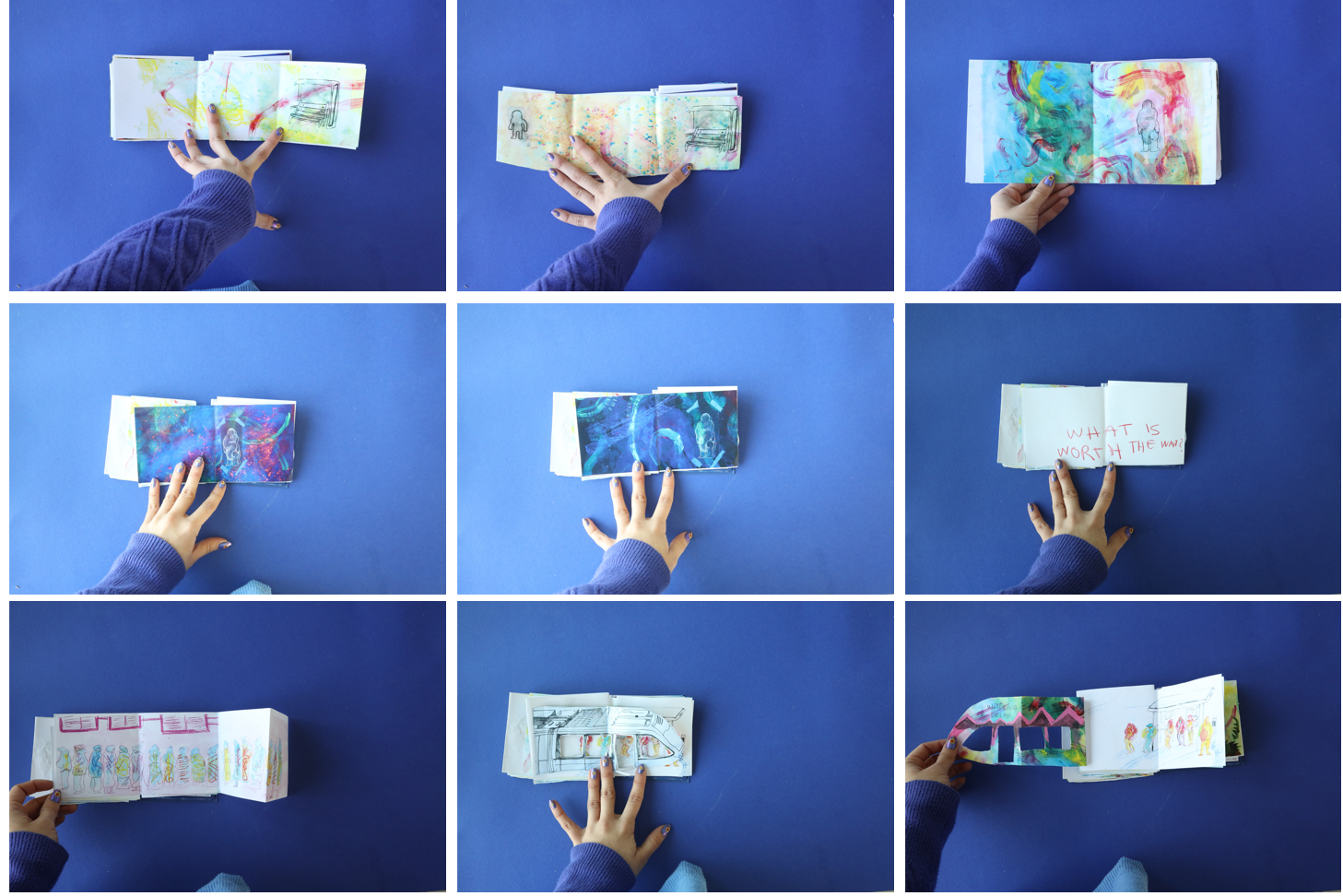


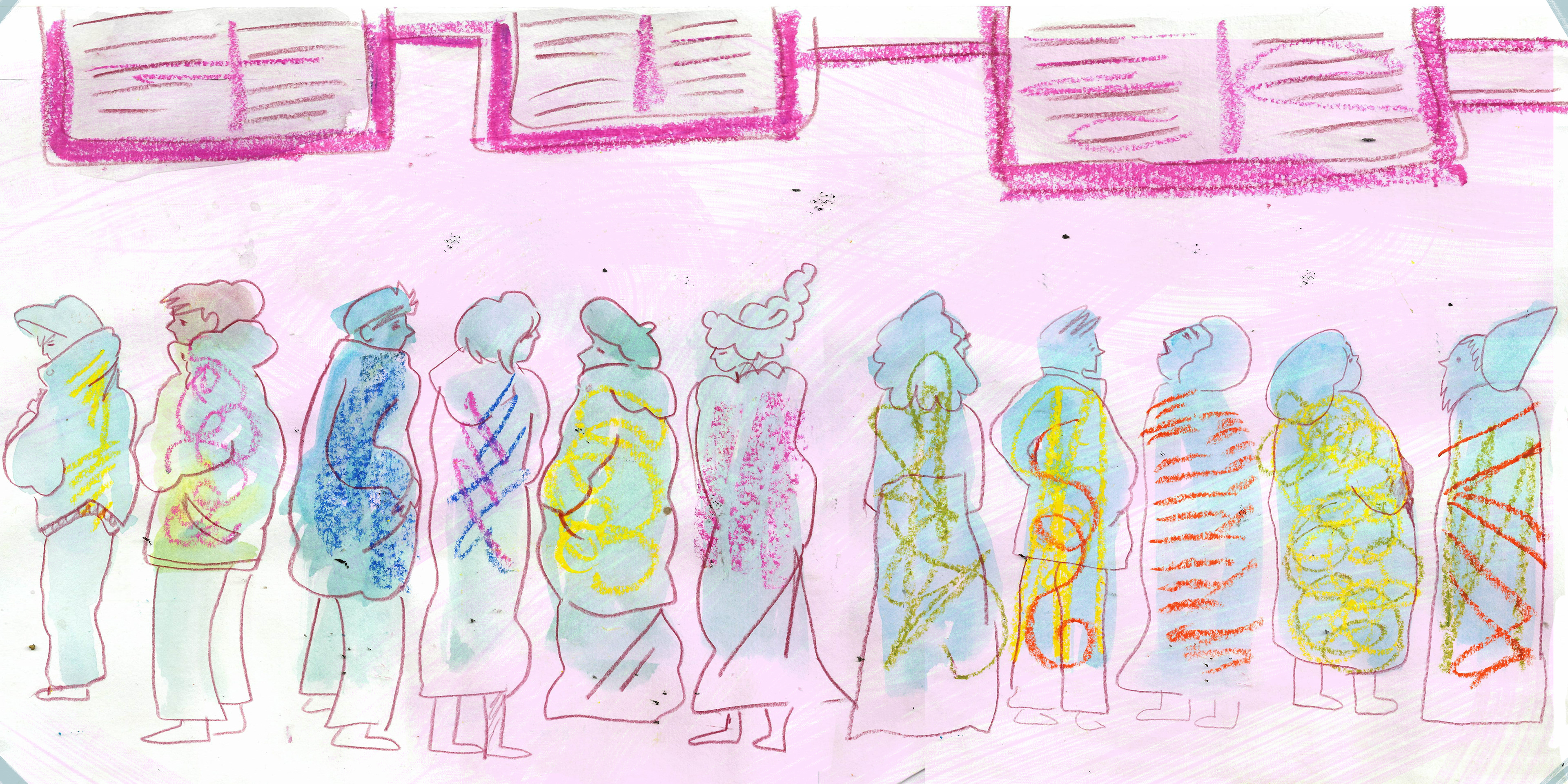
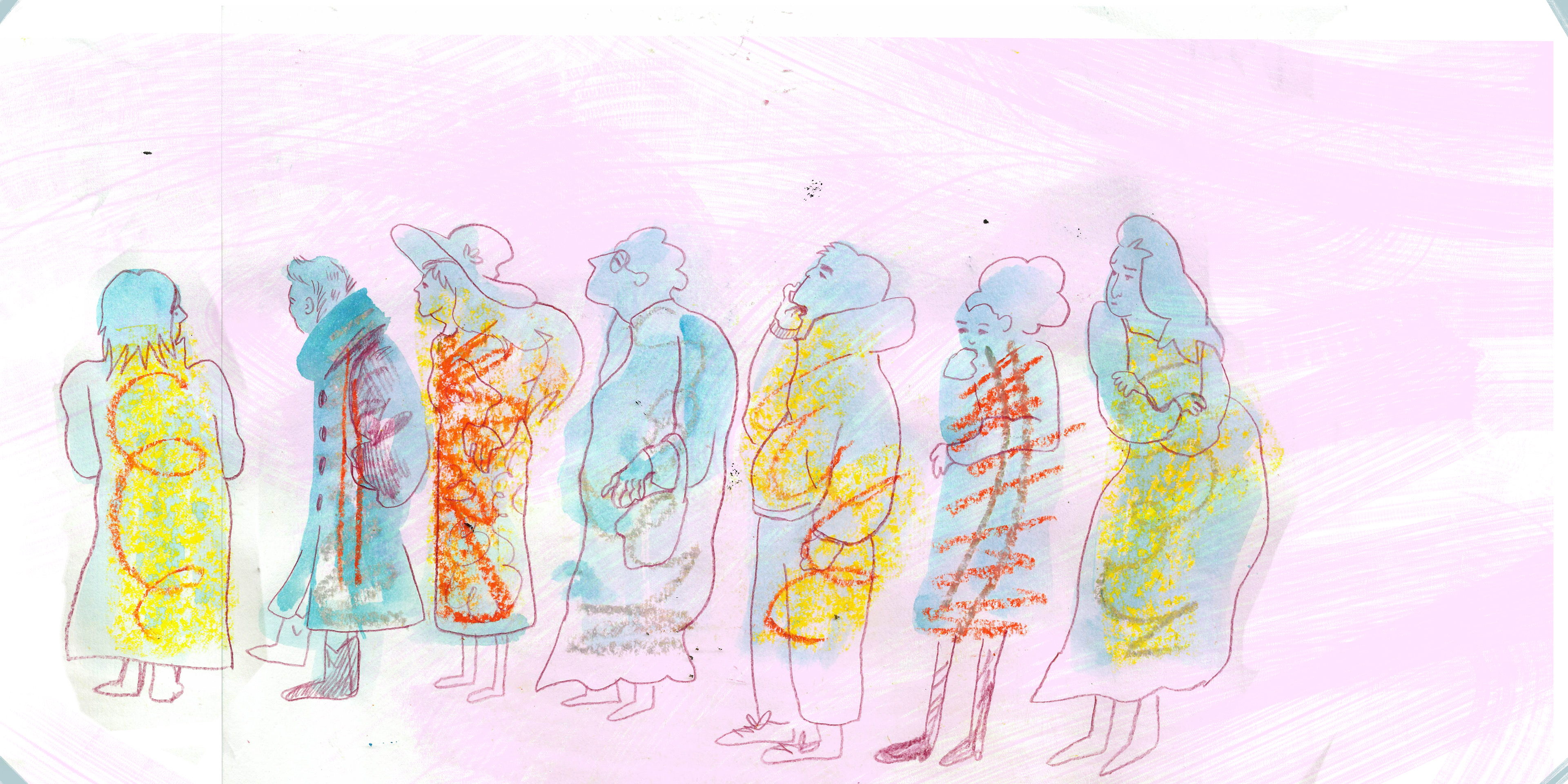

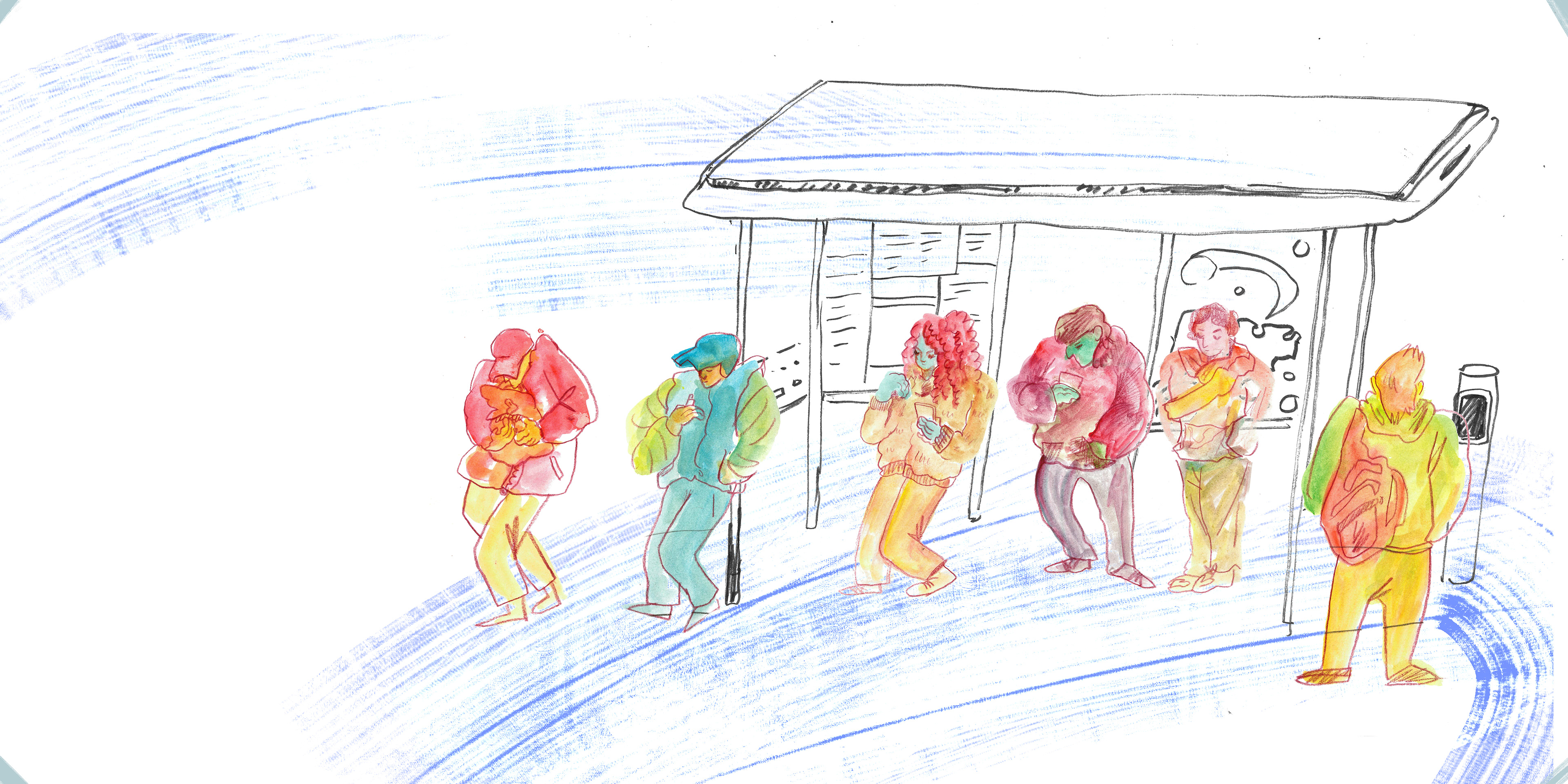
Touching Up
I gave myself a day to edit all the images in photoshop, making them look less messy, as well as to put the whole thing into indesign. I definitely cut it really clos, but I managed to do it, so that they were ready t0 print for the next day, which was the last day that I could print it with one of the technicians.
Final-ish layout
But, of course, before sending it to print, I had to mock up the book one last time. In the end I was quite happy with the pacing of the book. I wanted the book to end on an all-encompassing statement at the end. This was originally supposed to be ' Waiting can be beautiful', however, in the end, I decided that I want it to be something more neutral, so I decided on " waiting is living".
Binding the book went pretty well, but since I did it at home, it does not look entirely professional, so I am planning to remake it when I get the chance, potentially with a fabric cover.
I used a binding method that one of the lecturers reccommended, which consisted of printing each sprea one sided, and using double sided tape to stick them onto each others back, to form a text block with a pretty flat back without stitching it.
I printed out the cover and end sheets on vinyl, so I did not have to work with too much pva glue, which can make things look messy. I accidentally printed the cover wrong, as I did not leave enough room on one of the edges. The title was initially supposed to be in the centre, but I decided to move it to the corner, since that was the least obvious way to mask the mistake.
I also managed to submit in time! (right before they moved the deadline by a week)
I did not get shortlisted, but I am not disappointed, since I was not really expecting to, considering that my submission is quite rushed, and that fitting it into the fun7 play theme of this year was also a bit of a stretch.
More than anything, I am happy that I managed to submit a competition entry while still in university. I am trying to be more proactive and send my work to places, and I think the first couple of times doing that are definitely the hardest, so I am glad that I managed to get at least some semblance of a start right now.
I also feel like now that I am more familiar with the competition, I will know what to expect in future, if I decide to apply again.
Overall, although I plan to redo it in the future, I am quite happy with the book I managed to put together. My process during the creation of this book was quite weird and jumped from place to place, which hindered its development at times. think something that I have learned while making 'Waiting' is that I need to trust my own decisions more. I kept jumping from idea to idea, not even giving myself time to even explore them properly, since I was not confident enough to give them a chance.
This was also good practice in making a conceptual book, which I tend to not be very good at. I am fairly happy with how the theme of 'Waiting' translates in the final book. Through making this book, I feel like I was able to develop my visual story-telling skills through relaying an abstract topic.
I was also able to explore creating a finished book and exploring cut out and fold out elements. Although my professional finish is lacking in some aspects, I feel like I learned a lot about how a book is made, and my next books will benefit from this knowledge. I also acquired an interest in cut-out and fold-out book formats, which I will be exploring more in the future.
I feel like this book was a journey, and I got lost multiple times across the way, but I am happy with the final result.
